Airgo Networks AGN1201AP0000 True MIMO Access Point User Manual 2
Airgo Networks Inc. True MIMO Access Point 2
Contents
User manual 2
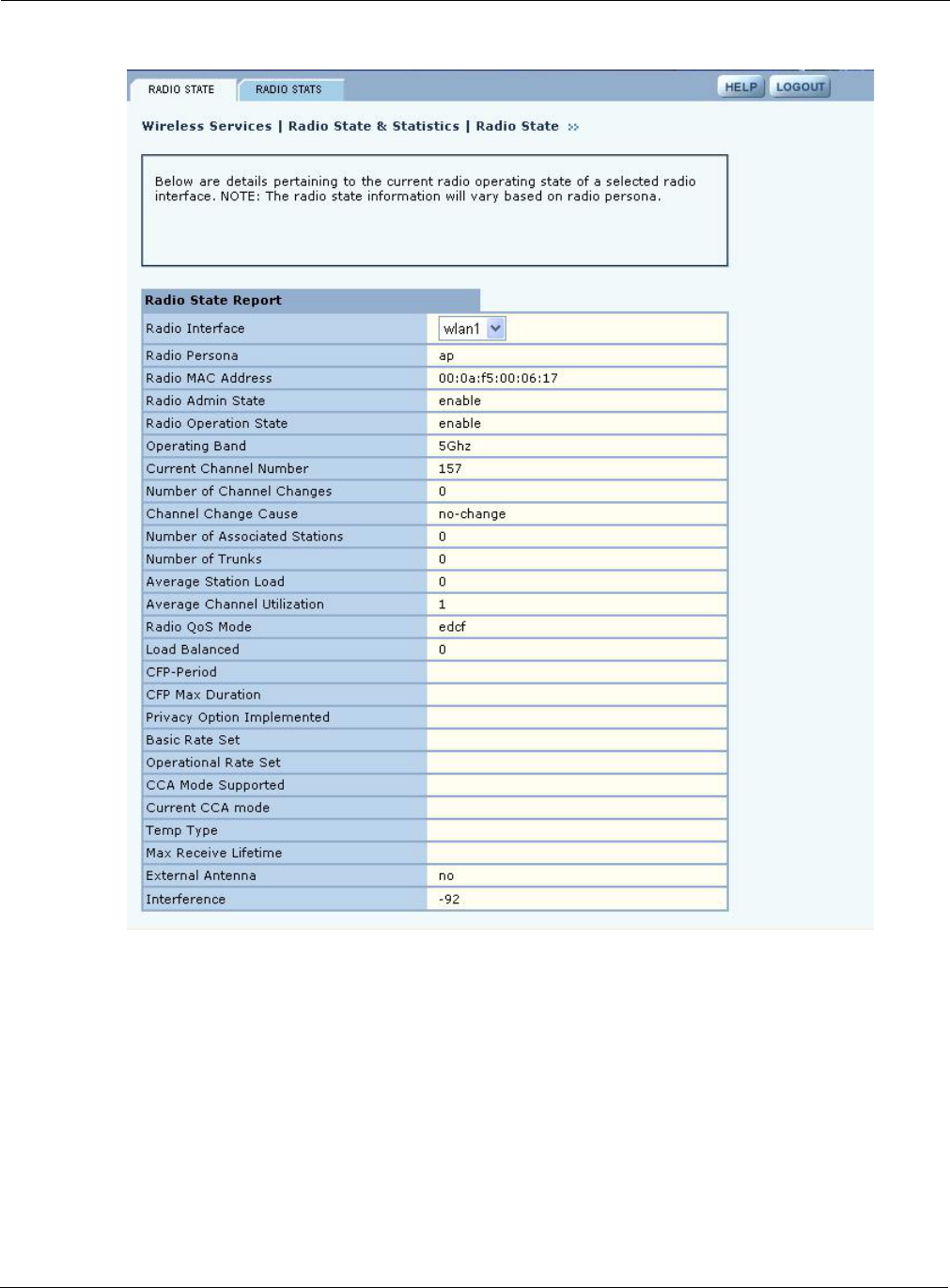
4 Configuring Radio Settings
78 Installation and User Guide: Airgo Access Point
Figure 49: Radio State Tab
Use the pull-down list to switch between radios. This tab contains the following information:
Field Description
Radio Interface AP radio (wlan0 or wlan1)
Radio Persona Mode of the radio - AP or BP
Radio MAC Address MAC address of radio
Radio Admin State Administrative status of the radio (enabled or disabled)
Radio Operation State Operational status of the radio (enabled or disabled)
Operating Band Current band of operation

Viewing Radio Statistics
Installation and User Guide: Airgo Access Point 79
Radio Statistics
The Radio Statistics tab (Figure 50) contains information on the operation of each radio. This
information varies according to whether the radio is in the AP or BP persona. The statistics refresh
every 10 seconds. It is advisable to wait 10 seconds or more to get new snapshot of the same
statistics.
Current Channel
Number
Current channel of operation
Number of Channel
Changes
Number of times the channel has changed since boot-up (AP persona only)
Channel Change Cause Reason the frequency changed since boot-up, if appropriate, due to user
intervention or performance degradation (AP persona only)
Number of Associated
Stations
The number of stations associated to the radio (AP persona only)
Number of Trunks Number of backhaul trunks associated with the radio (AP persona only)
Average Station Load Average load on client stations in percent (AP persona only)
Average Channel
Utilization
Average load on channels in percent (AP persona only)
Radio QoS Mode Mode used for class of service mapping
Load Balanced Number of load balanced stations (AP persona only)
CFP-Period Number of DTIM intervals between the start of Contention Free Periods
(CFPs)
CFP Max Duration Maximum duration of the CFP in time units that may be generated by the AP
Privacy Option
Implemented
Security setting
Basic Rate Set Set of basic rates for BSS (AP persona only)
Operational Rate Set Set of operational rates for BSS
CCA Mode Supported List of all of the Clear Channel Assessment (CCA) modes supported by the
PHY
Current CCA Mode Current CCA method in operation
Temp Type Current physical operating temperature range capability
Max Receive Lifetime Maximum amount of time allowed to reassemble a fragmented frame
External Antenna Indication of whether the radio has an external antenna (true) or not (false)
Interference Radio interference in the surrounding wireless environment pertaining to the
channel of operation, in dBm. (AP persona only)
NOTE: All statistics are computed since the last radio reset or since the Clear Statistics
button was last clicked.
Field (continued) Description
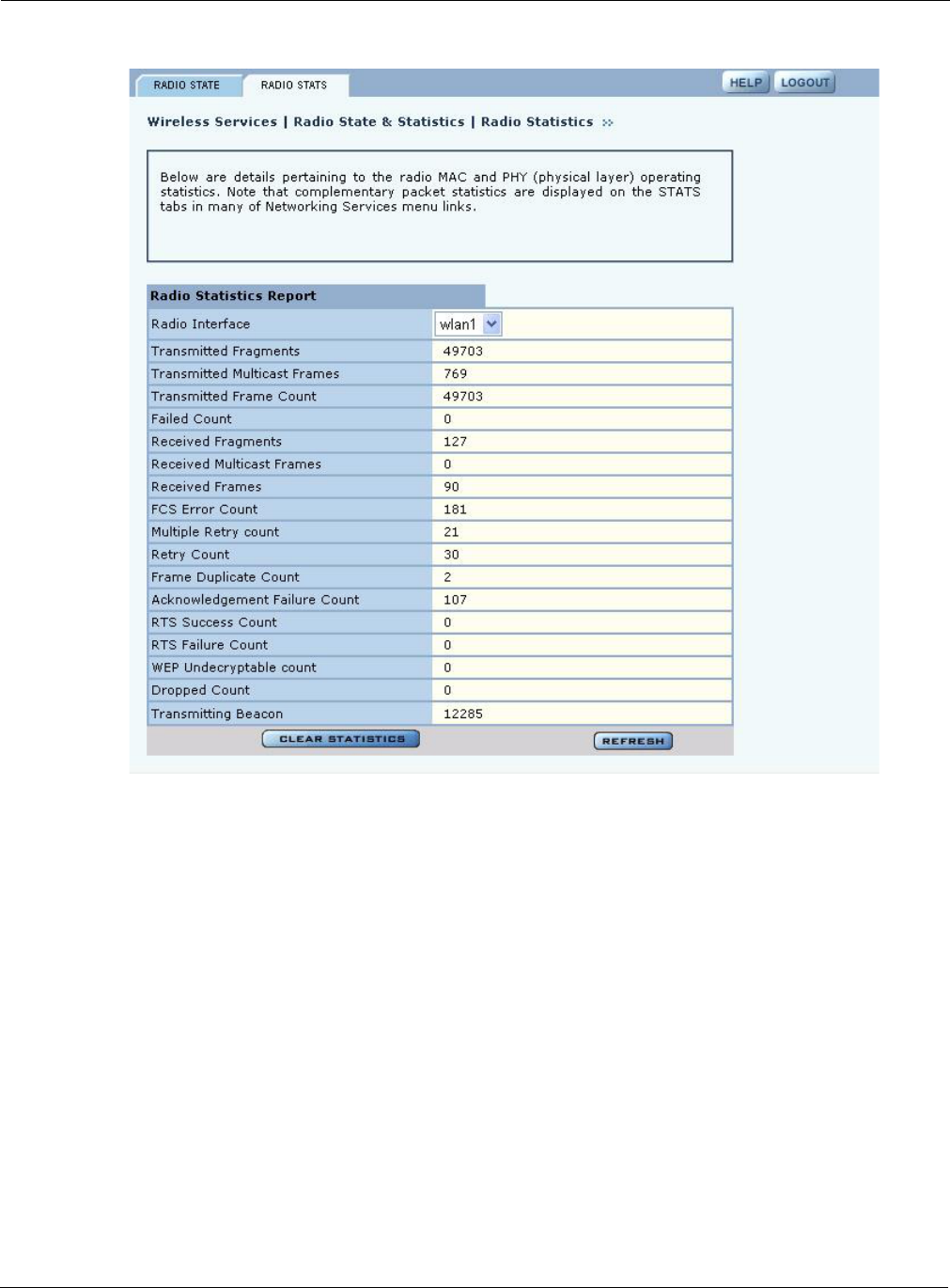
4 Configuring Radio Settings
80 Installation and User Guide: Airgo Access Point
Figure 50: Radio Statistics Tab
Use the pull-down list to switch between radios. This tab contains the following information:
Field Description
Radio Interface Access point radio (wlan0 or wlan1)
Transmitted Fragments Number of transmitted fragments (MAC Protocol Data Units) that have been
acknowledged since last power-up or last Clear Statistics request
Transmitted Multicast
Frames
Number of transmitted multicast frames
Transmitted Frame
Count
Count for successfully transmitted MSDUs
Failed Count Count of MSDU not transmitted successfully due to the number of transmit
attempts exceeding either the dot11ShortRetryLimit or dot11LongRetryLimit
Received Fragments Count for successfully received MPDUs of type Data or Management
Received Multicast
Frames
Count when an MSDU is received with the multicast bit set in the destination
MAC address

Viewing Radio Statistics
Installation and User Guide: Airgo Access Point 81
Received Frame Count Count of successfully received frames (MSDUs)
FCS Error Count Count of FCS errors detected when receiving a MPDU
Multiple Retry Count Count of successful transmissions after more than one retransmission
Retry Count Count of successful transmissions after one or more retransmission
Frame Duplicate Count Count of frames received in which the Sequence Control field indicates it is a
duplicate frame
Acknowledgement
Failure Count
Count of expected acks not received
RTS Success Count Count of successful CTS received in response to an RTS
RTS Failure Count Count of RTS for which a CTS response is not received
WEP Undecryptable
Count
Only if encryption is WEP, number of times a frame is received with the WEP
subfield of the Frame Control field set to one and the WEPOn value for the
key mapped to the Transmitter MAC address (indicates that the frame should
not have been encrypted or that frame is discarded due to the receiving STA
not implementing the privacy option)
Dropped Count Number of dropped frames
Transmitting Beacons Count of successfully transmitted beacons
Field (continued) Description
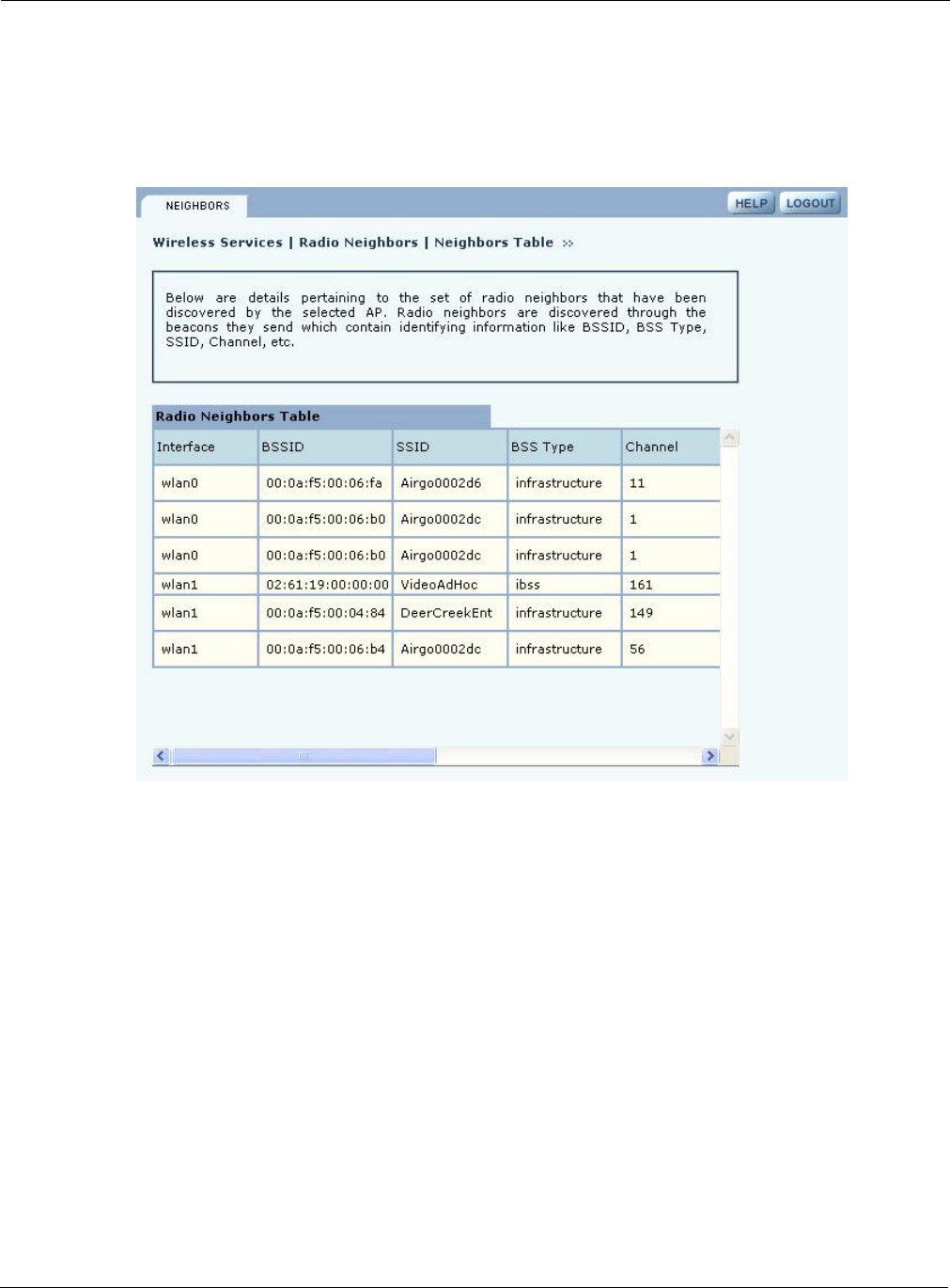
4 Configuring Radio Settings
82 Installation and User Guide: Airgo Access Point
Viewing Radio Neighbor Details
A radio neighbor is a radio whose beacon frame is detected by the AP. Select Radio Neighbors
from the Wireless Services menu to view summary information on all the neighboring APs within
beacon range (Figure 51).
Figure 51: Radio Neighbors
The summary table lists the following information:
Field Description
Interface The AP radio (wlan0 or wlan1)
BSSID MAC address of the neighboring AP radio, which determines the BSS
SSID Name of the network (ESS) in which the AP is operating
BSS Type Infrastructure or ad-hoc network arrangement
Channel Current channel of operation for the neighboring BSS
AP Beacon Name Name of the neighboring AP in the beacon frame
Compatibility Status Indication of whether the neighbor is an AP with which the IAPP protocol can
be established
Strength Strength of radio neighbor signal, in percentage
Load Percentage Load on the AP, in percentage
STA Count Number of client stations served by the neighboring AP
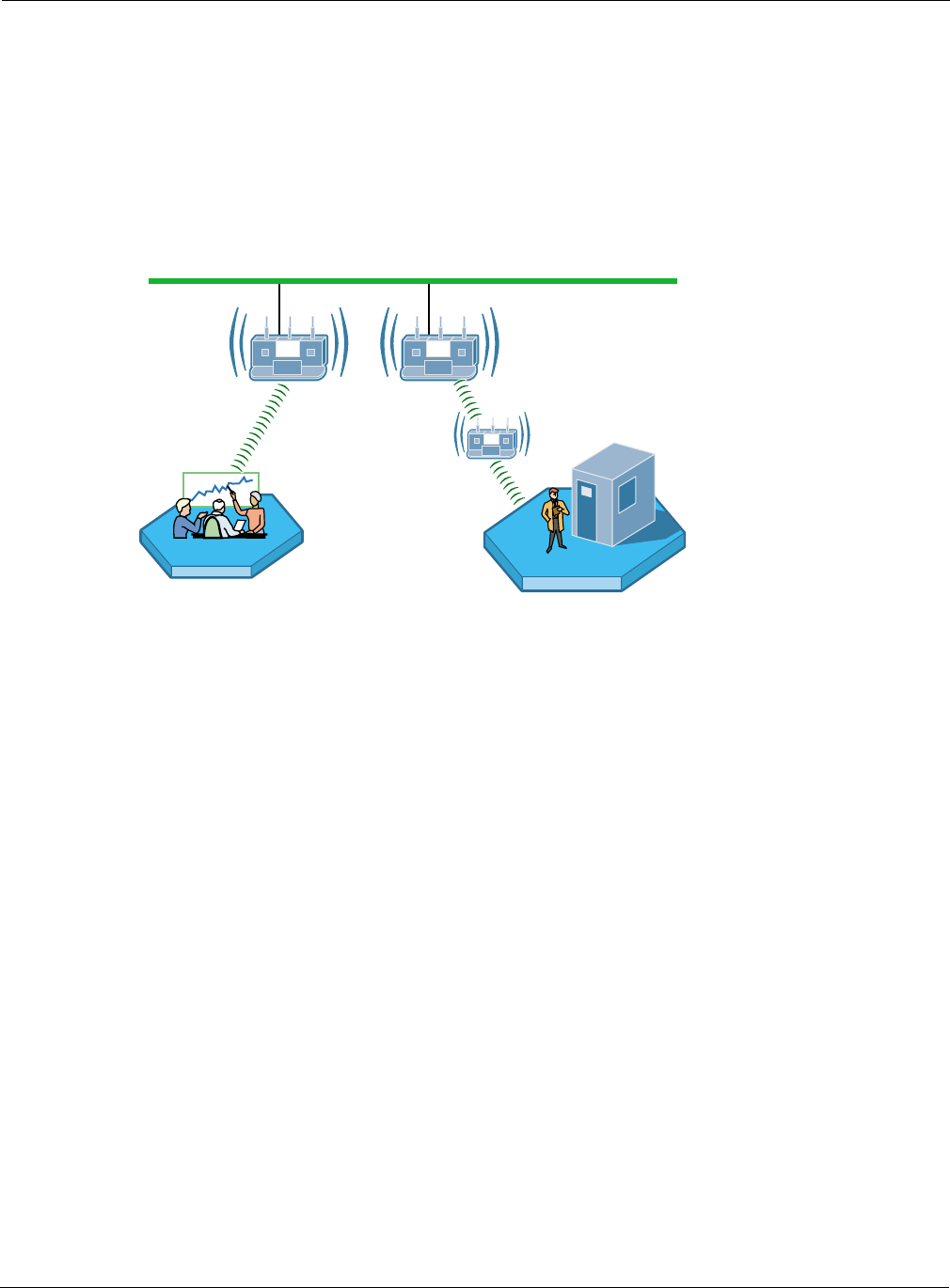
Configuring SSID Parameters
Installation and User Guide: Airgo Access Point 83
Use the scrolling bars to display the full range of interfaces and data.
Configuring SSID Parameters
A wireless network is formed when a set of APs advertises the same value as the SSID, or network
name. Figure 52 shows the Acme Works network with multiple Airgo APs, each advertising the
same Corporate SSID.
Figure 52: Example “Corporate” Network
Each Airgo AP is shipped with a default SSID, which must be replaced during the bootstrap
process (see “Using AP Quick Start to Initialize the Access Point” on page 34) or from the SSID
Configuration panel, as explained in this section. Multiple SSIDs are also supported. “Multiple
SSIDs” on page 90 explains how to enable this feature and permit clients to access multiple
wireless networks through the same access point.
A0042D
SSID="Corp" SSID="Corp"
10/100 Switched Ethernet
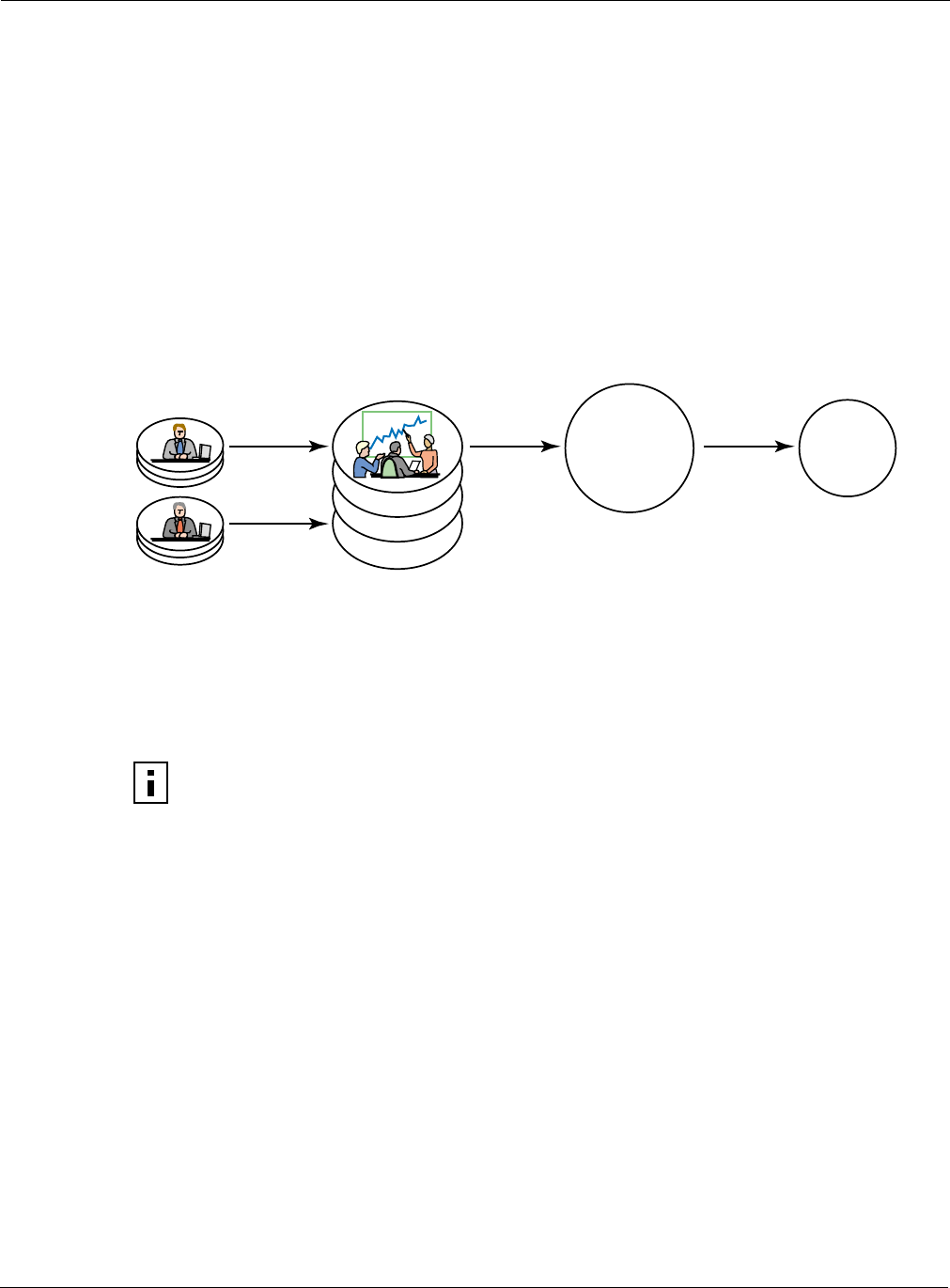
4 Configuring Radio Settings
84 Installation and User Guide: Airgo Access Point
SSIDs and Service Profiles
A service profile consists of VLAN, COS, and minimal security attributes applied to a network or
to designated classes of users once they are authenticated by a RADIUS authentication server
(security portal or external authentication server). If the service profile is defined without reference
to a specific user group and bound to an SSID, the profile is applied to all users who access the
network.
Figure 53 illustrates the relationship between users, user groups, service profiles, and SSID. A
RADIUS authentication server stores user group information and uses that information to match
users to groups during authentication. Upon authentication, a previously-defined service profile is
assigned to the user, based on user group membership. The service profile, in turn, is bound to the
SSID and thereby determines the level of service awarded to the user.
Figure 53: SSIDs and Service Profiles
From the SSID Configuration panels, you can define service profiles for user groups and then bind
the profiles to the SSID. A user who requests access to the network is authenticated and placed into
the appropriate user group, and the AP software automatically applies the privileges and
restrictions defined in the service profile for that group. Each user group can be assigned to just one
service profile, but multiple groups can share the same service profile.
Select SSID Configuration from the Wireless Services menu to open the SSID Configuration
panel. The panel contains the following tabs:
•SSID Table — View the current SSID configuration, modify the configuration, or add new
SSIDs.
•SSID Details — View the association between SSIDs and service profiles.
•Profile Table — Manage service profiles.
•Multiple SSID — Enable the multiple SSID feature.
NOTE: The SSID settings in this section apply only to AP mode radios. The Backhaul
Configuration panel described in “Configuring a Wireless Backhaul” on page 133 is
used to configure the SSID for the BP radio. Make sure that the SSID configuration for
the AP matches that of the other APs in the network.
A0029
User Groups
Assigned to Service Profile
VLAN
QOS
Encryption
Bound to
SSID
Users
Members of
Users
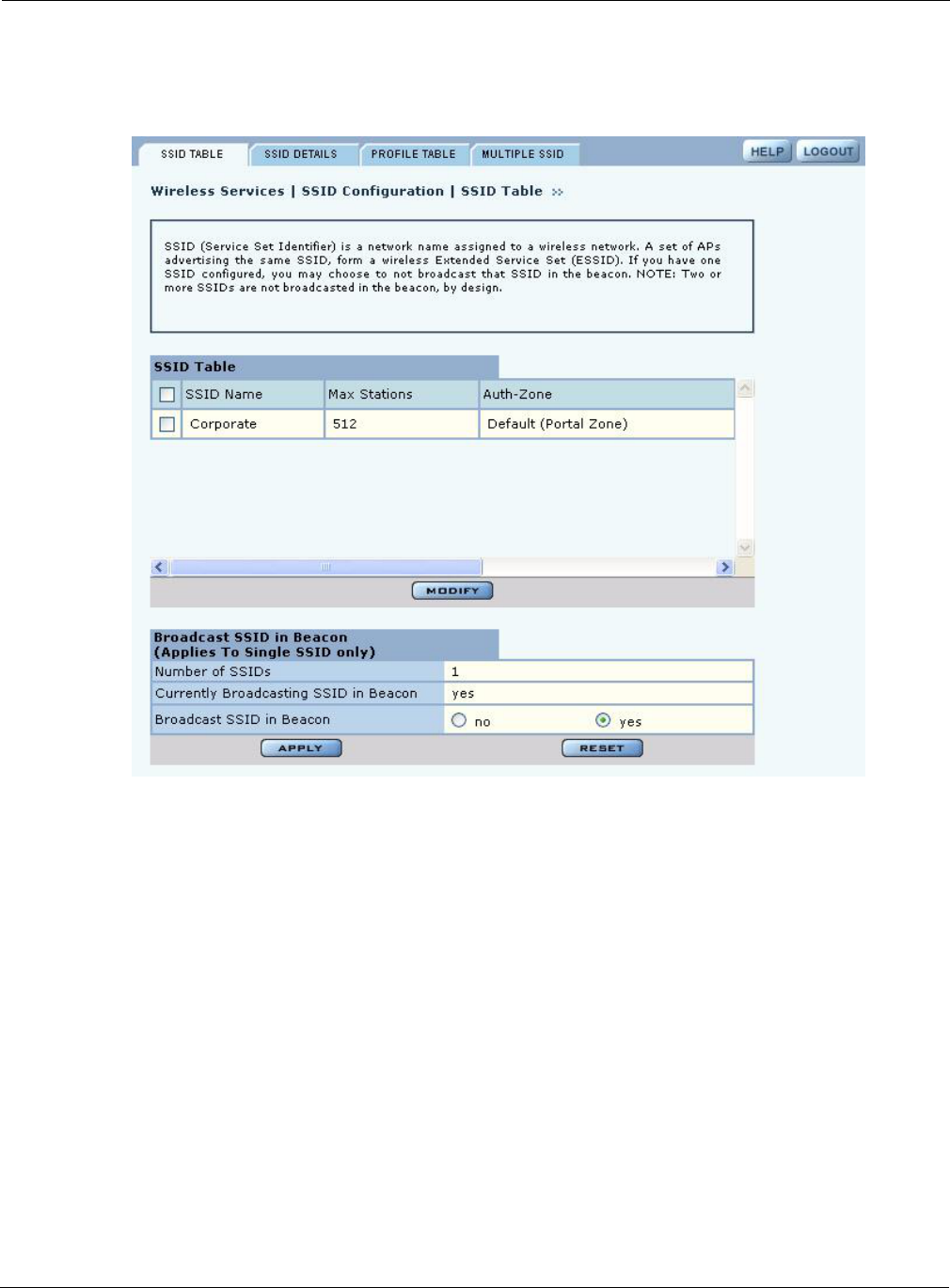
Configuring SSID Parameters
Installation and User Guide: Airgo Access Point 85
SSID Table
Select SSID Configuration from the Wireless Services menu to open the SSID Table (Figure 54).
Figure 54: SSID Configuration - SSID Table
The table lists the following information about each SSID:
Field Description
SSID Name Name (maximum 32 alphanumeric characters). This name is used only by the
radio in AP mode and is broadcast in its beacon. For a radio in backhaul point
mode, the SSID name is entered in the Backhaul Configuration, Link Criteria
tab (see Chapter 6).
Max stations The maximum number of stations that can be associated to this SSID on this
AP. The range is 1-256 for each AP radio. If the maximum number of stations
is reached and a new client tries to associate to the AP, the association attempt
is rejected. Association is also rejected if the number of clients is less than the
maximum but exceeds the number of client stations permitted by the AP
license.
Auth-Zone The RADIUS authentication zone for the SSID.
PSK-Type The type of pre-shared key used if WPA is the encryption suite.
MAC-ACL MAC-ACL authentication enabled or disabled.
Auth Servers The RADIUS server used for user authentication.

4 Configuring Radio Settings
86 Installation and User Guide: Airgo Access Point
Follow these steps to rename the SSID or modify its configuration:
1Select the checkbox for the SSID and click Modify to open the SSID Details table, which also
provides access to service profiles for the SSID.
2Enter the new SSID name.
3Click Apply. If an SSID is renamed, all configuration details related to the old SSID name,
such as service profile associations and security configuration, are automatically transferred,
and the radios that operate in AP mode now broadcast the new SSID in the beacon.
The default SSID cannot be modified. If an attempt is made to modify the default SSID, the system
prompts you to first rename it. If you select the current SSID in the table and click Delete, the SSID
reverts to the default.
The Airgo AP can be configured to support multiple SSIDs. If this feature is enabled on the
Multiple SSID tab (“Multiple SSIDs” on page 90), then it is possible to add new SSIDs from the
SSID Table tab, in addition to modifying or deleting an existing SSID.
Perform the following functions on the SSID Table tab:
Function Description
Add new SSID (if multiple
SSID is enabled)
1Click Add and enter the following information:
• SSID name — This name is used only by the radio in AP mode.
For a radio in backhaul point mode, enter the SSID name in the
Backhaul Configuration, Link Criteria tab (see Configuring a
Wireless Backhaul).
• Max Number of Stations — Enter a maximum number of client
stations, if desired. The range of values is 1-256 for each AP radio.
If the maximum number of stations is reached and a new client
tries to associate to the AP, the association attempt is rejected.
Association is also rejected if the number of clients is less than the
maximum but exceeds the number of client stations permitted by
the AP license.
2Click Apply.
Modify an existing SSID 1Select the SSID and click Modify to open the SSID Details table,
which also provides access to service profiles for the SSID.
2Enter the new SSID name.
3Confirm the maximum number of stations.
4Click Apply.
Delete an SSID (if multiple
SSID is enabled)
Click Delete, and click OK to confirm.
Change the SSID broadcast
setting (single SSID
configurations only)
For single SSID configurations, the SSID Table tab provides the option to
broadcast the SSID in the AP beacon or to suppress broadcast of the SSID
for increased security. The SSID is never broadcast in multiple SSID
configurations.
To change the SSID broadcast setting:
1Select no or yes.
2Click Apply.
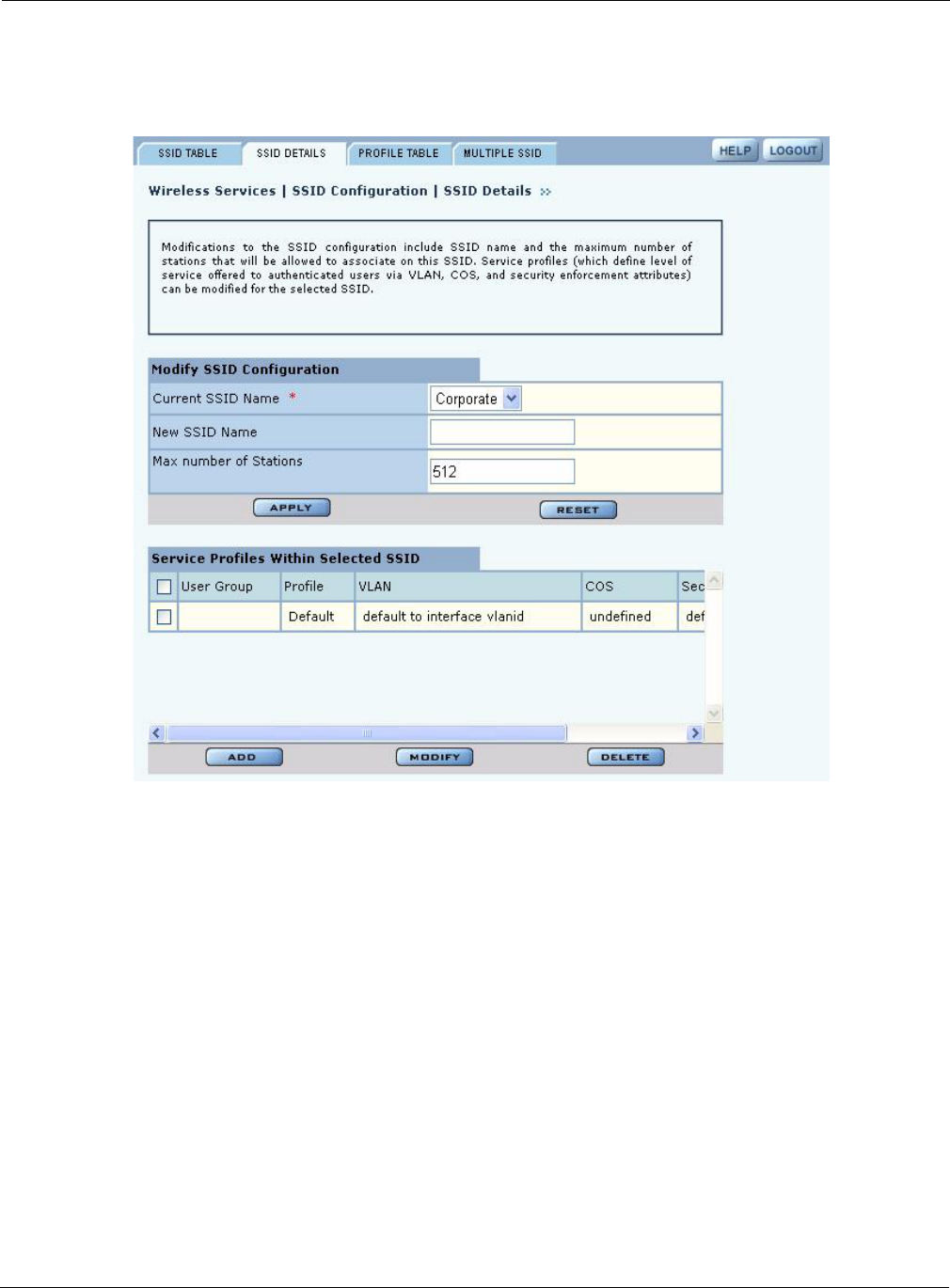
Configuring SSID Parameters
Installation and User Guide: Airgo Access Point 87
SSID Details
Use the SSID Details Tab (Figure 55) to modify an SSID and bind service profiles to an SSID.
Figure 55: SSID Configuration - SSID Details
The tab contains two areas. Use the Modify SSID Configuration area to change the current SSID
configuration, as described in “SSID Table” on page 85. The bottom area shows the service profiles
currently bound to the SSID. This list includes the following information for each service profile:
Feature Description
User Group The user group that is linked to the service profile; if this entry is empty, the
user group is null. The null user group is automatically assigned to the default
service profile, unless it is explicitly bound to another service profile.
RADIUS authentication must be active in order for user groups to be
effective. The user group for a given client is passed to the AP as a RADIUS
attribute for each successfully authenticated user. If all the service profiles
associated with an SSID are deleted, then the SSID is automatically associated
to the Default service profile.
If the group must be changed then the SSID to service profile binding must be
deleted and re-added.
Profile Service profile name.
VLAN VLAN assigned to the service profile.
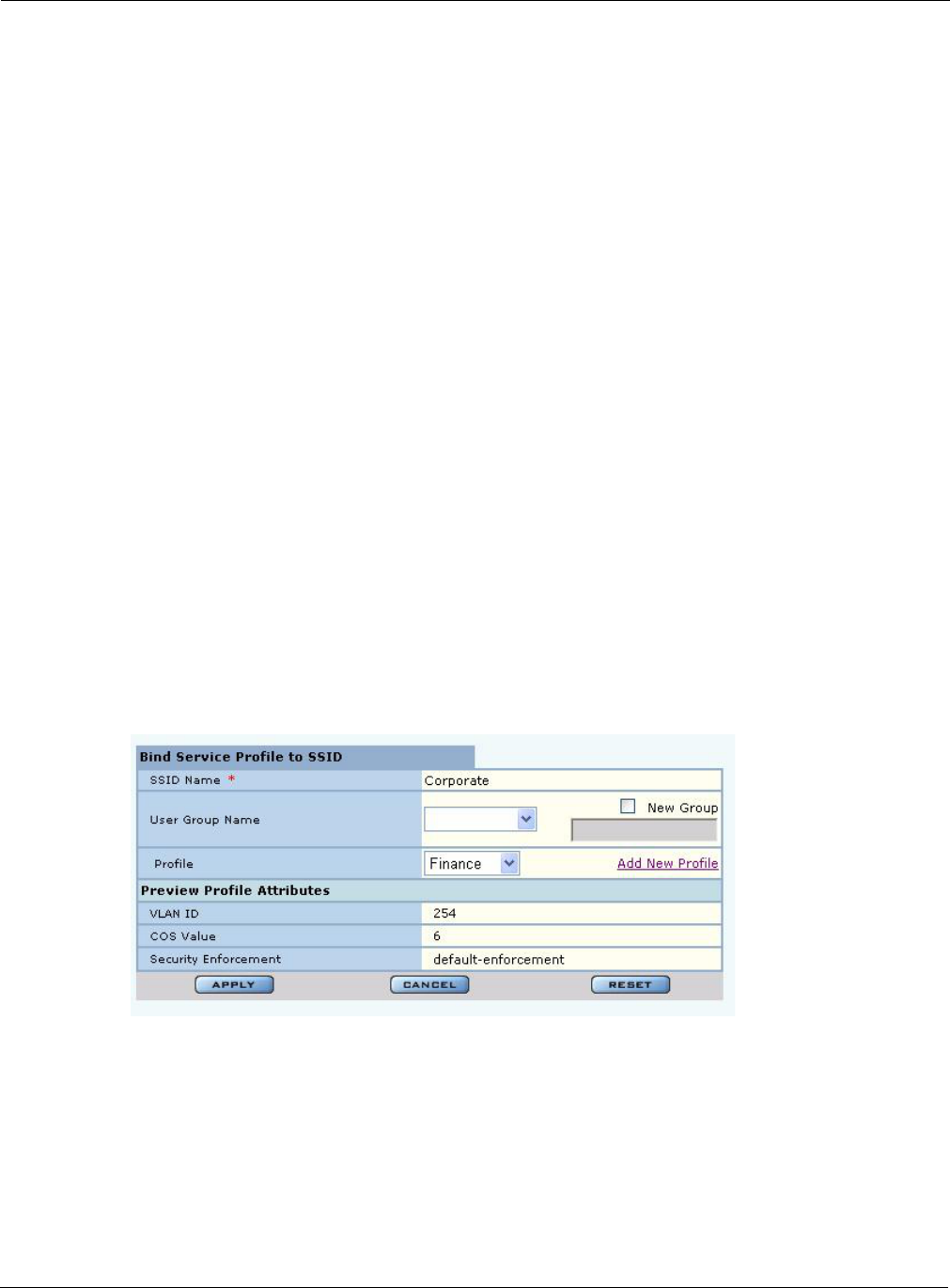
4 Configuring Radio Settings
88 Installation and User Guide: Airgo Access Point
Perform the following functions from the service profile list on this tab:
Figure 56: SSID Configuration - Bind Service Profile to SSID
COS Class of service values assigned to the service profile.
Security Enforcement Type of encryption required for the service profile; for user groups assigned to
this service profile, the security enforcement setting supersedes the encryption
type configured for the overall network.
Function Steps
Bind an existing service
profile to an SSID
1Click Add to open the Bind Service Profile to SSID entry panel
(Figure 56).
2Select the profile name, or click Add New Profile to create a new
profile according to the instructions in “Profile Table” on page 89.
3Select a group name from the existing RADIUS group names to
associate with the profile, or select New Group and enter a new user
group name.
4Click Apply.
Change service profile
binding
1Select the checkbox for the user group and profile, and click Modify
to open the Bind Service Profile to SSID entry panel (Figure 56) in
modify mode.
2Select a profile to bind to the SSID, or click Add New Profile to
create a new profile according to the instructions in “Profile Table” on
page 89.
3Click Apply.
Delete service profile binding 1Select the checkbox for the user group and profile, and click Delete.
2Click OK to confirm.
Feature (continued) Description
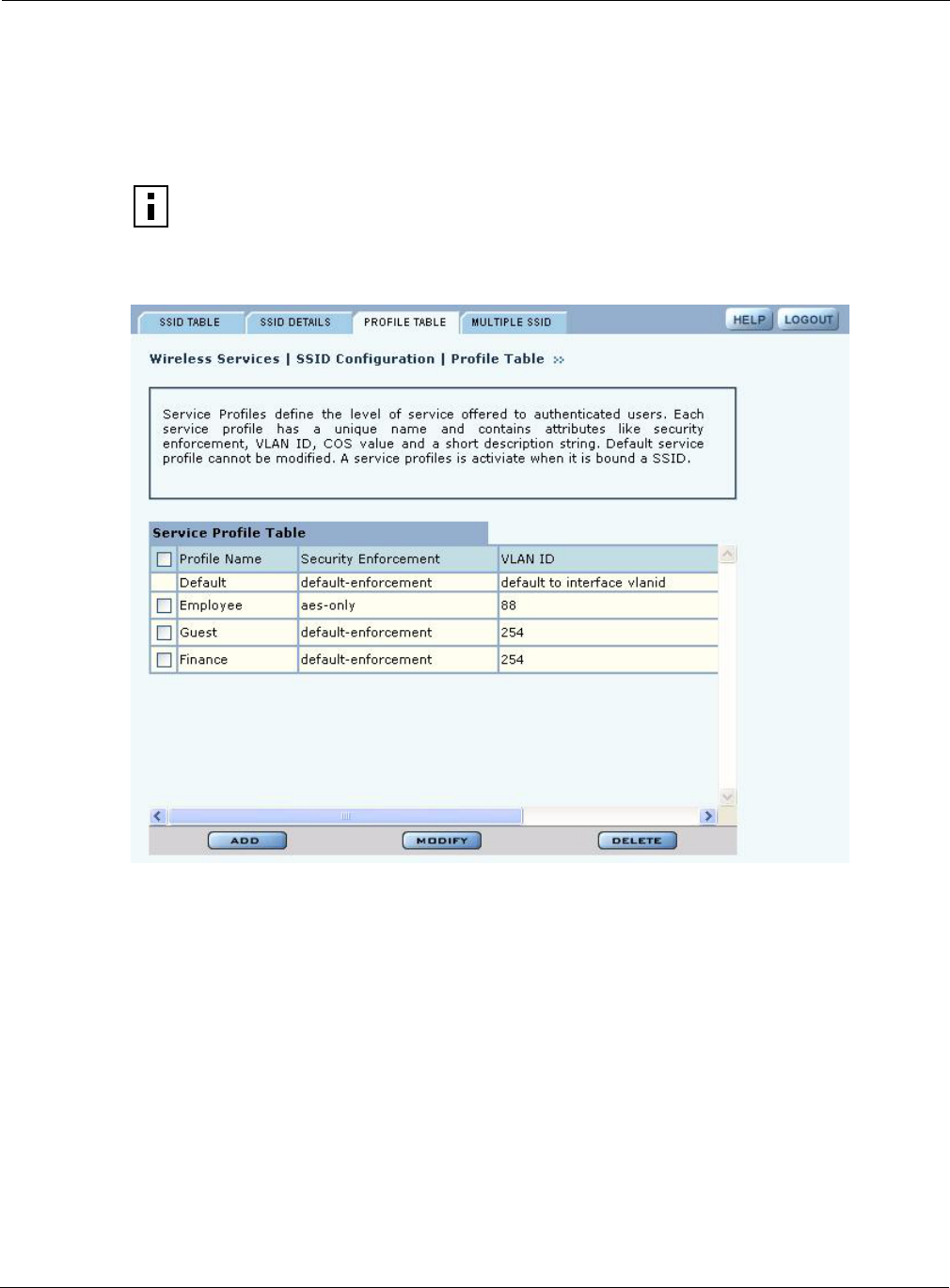
Configuring SSID Parameters
Installation and User Guide: Airgo Access Point 89
Profile Table
The Profile Table tab (Figure 57) lists all the currently defined service profiles. Each service profile
includes attributes for security enforcement, VLAN ID, and COS value. Binding a service profile to
an SSID determines the privileges and restrictions that apply to user groups associated with the
profile.
Figure 57: SSID Configuration - Profile Table
NOTE: Changes made to SSID or service profiles cause affected users to be
automatically disassociated from the AP. The AP then attempts to reassociate them
automatically. This causes a momentary interruption in service.
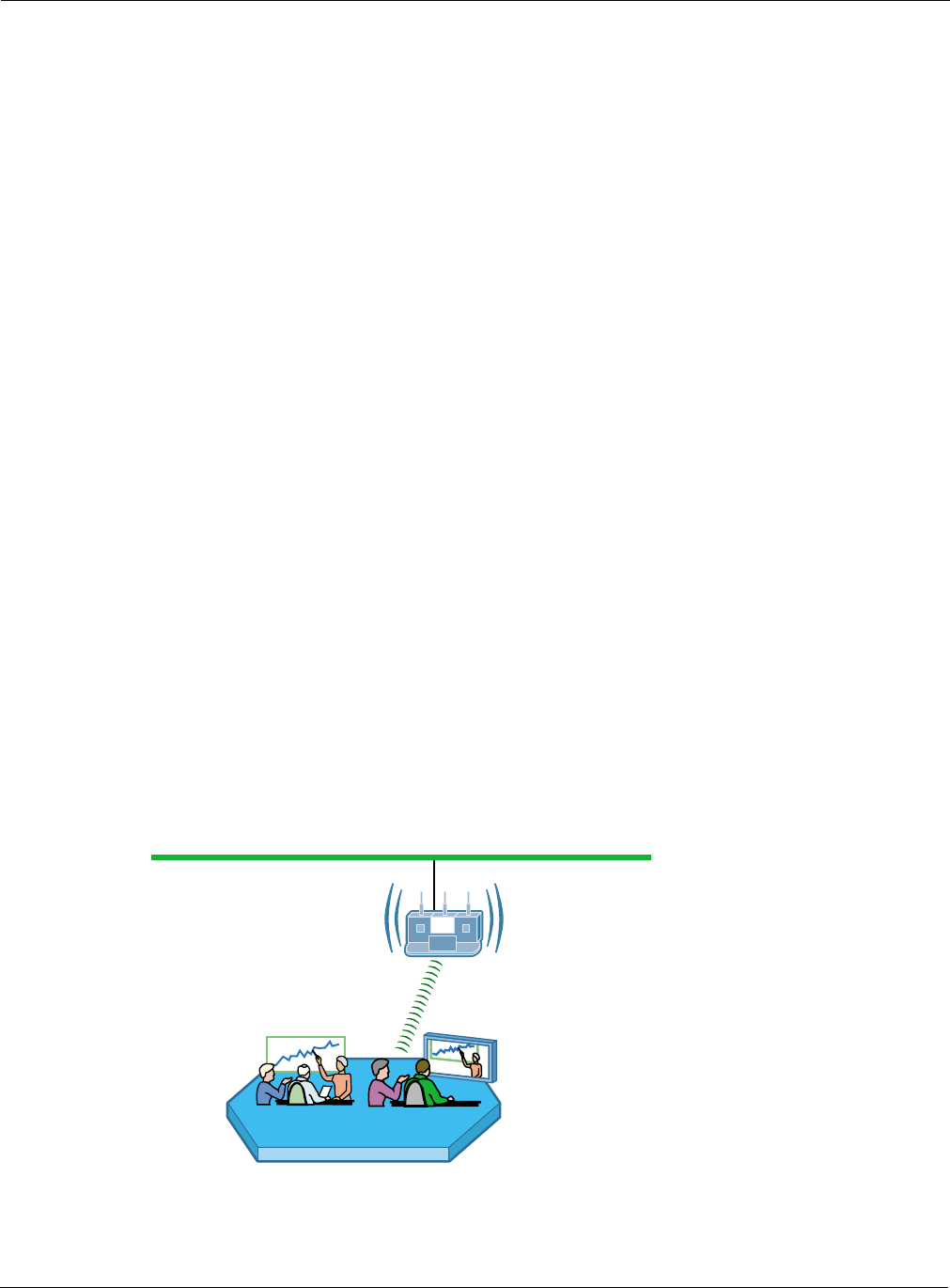
4 Configuring Radio Settings
90 Installation and User Guide: Airgo Access Point
Perform the following functions from this tab:
Multiple SSIDs
With the multiple SSID feature, the same physical network infrastructure can support multiple
wireless networks. Each network (identified by SSID) can have its own service profile and
associated level of service. For example, Figure 58 shows how Acme Works configured two
SSIDs: one to accommodate the normal corporate network and one for a separate video conference
network, which requires a higher quality of service.
Figure 58: Example Use of Multiple SSIDs to Differentiate Levels of Service
Function Steps
Add a new service
profile
1Click Add to create a new service profile.
2Enter the profile name, which must be unique. (required)
3Select the VLAN for the profile.
4Enter a COS value for the profile. The range is 0-7. For more information,
see “Configuring Quality of Service” on page 117.
5Select an enforcement level for data encryption to apply to the profile. This
setting provides fine-grained security options at the user group level.
Default-enforcement refers to the encryption settings that prevail in the
network at large. The security enforcement applies after authentication is
complete.
6Enter a description, if desired.
7Click Apply to save the profile or Cancel to return to the Profile Table.
Modify a profile 1Select the profile from the table and click Modify.
2Make changes as desired, and click Apply, or click Cancel to return to the
Profile Table without saving changes. User groups bound to the profile
automatically inherit any modified attributes.
It is not possible to modify the default profile.
Delete a profile A service profile can only be deleted if there are no groups under the SSID
bound to the profile. It is not possible to delete the default profile.
A0043B
SSID="Corporate" SSID="Video"
10/100 Switched Ethernet
Corporate Video
COS=7COS=4
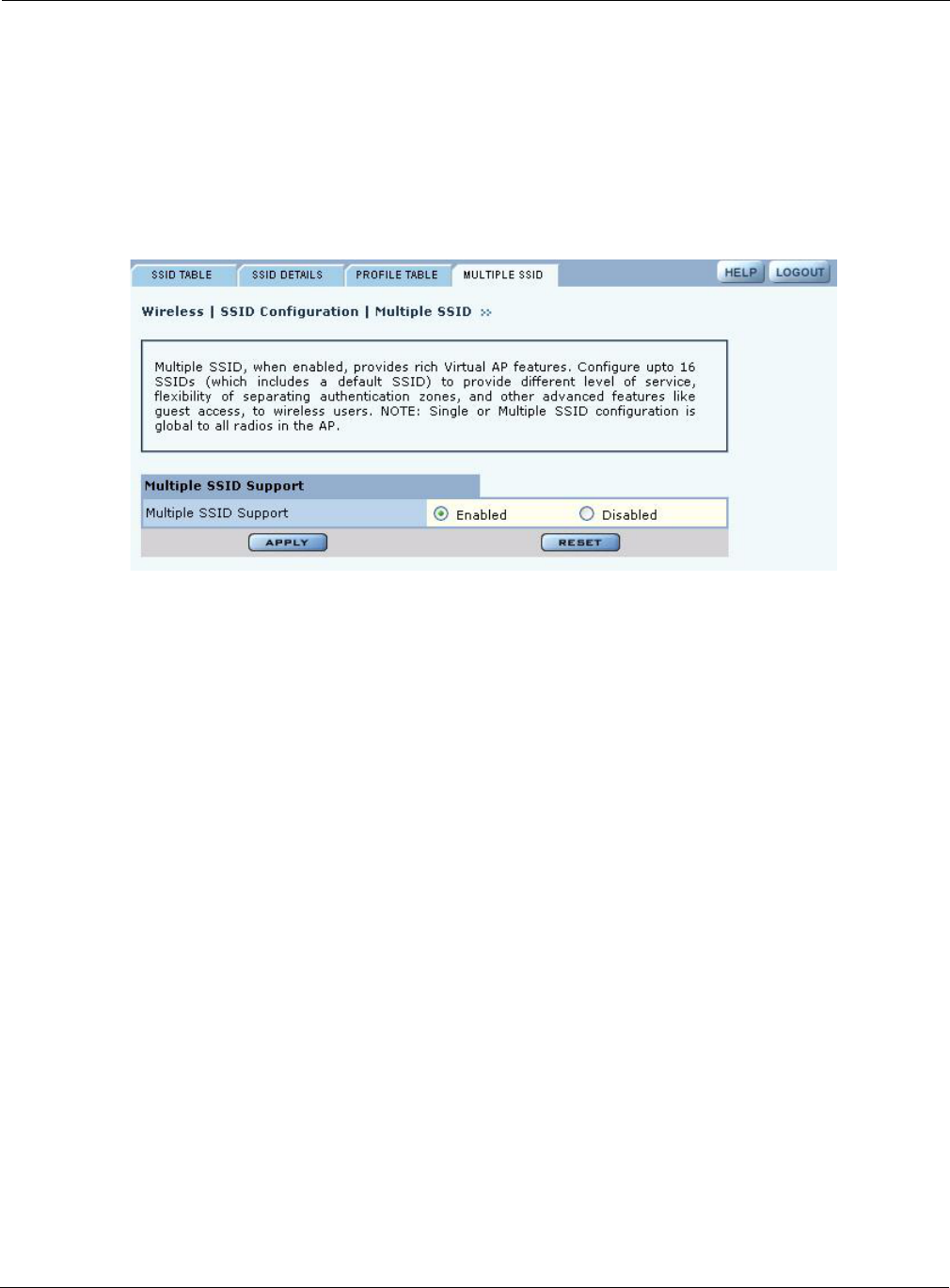
Managing Client Stations
Installation and User Guide: Airgo Access Point 91
Use the Multiple SSID tab (Figure 59) to enable the multiple SSID feature. Make a selection, and
click Apply. After enabling the multiple SSID feature, additional SSIDs can be added on the SSID
Table (see “SSID Table” on page 85).
When multiple SSIDs are enabled on the Airgo AP, that AP no longer broadcasts an SSID in its
beacon frame. In order for a client to associate with the Airgo AP configured for multiple SSIDs, a
profile for each target SSID must be created on the client workstation using the Windows Zero
Config (WZC) Add function or the Airgo Wireless Client Utility Create function.
Figure 59: SSID Configuration - Multiple SSID
Managing Client Stations
Select Station Management from the Wireless Services menu to open the Station Associations
panel. The panel contains the following tabs:
•Stations — View all client stations associated to this Airgo AP.
•Link Stat — View signal strength, signal quality, and all the MAC level statistics.
•Security Stat — View 802.1x security statistics.
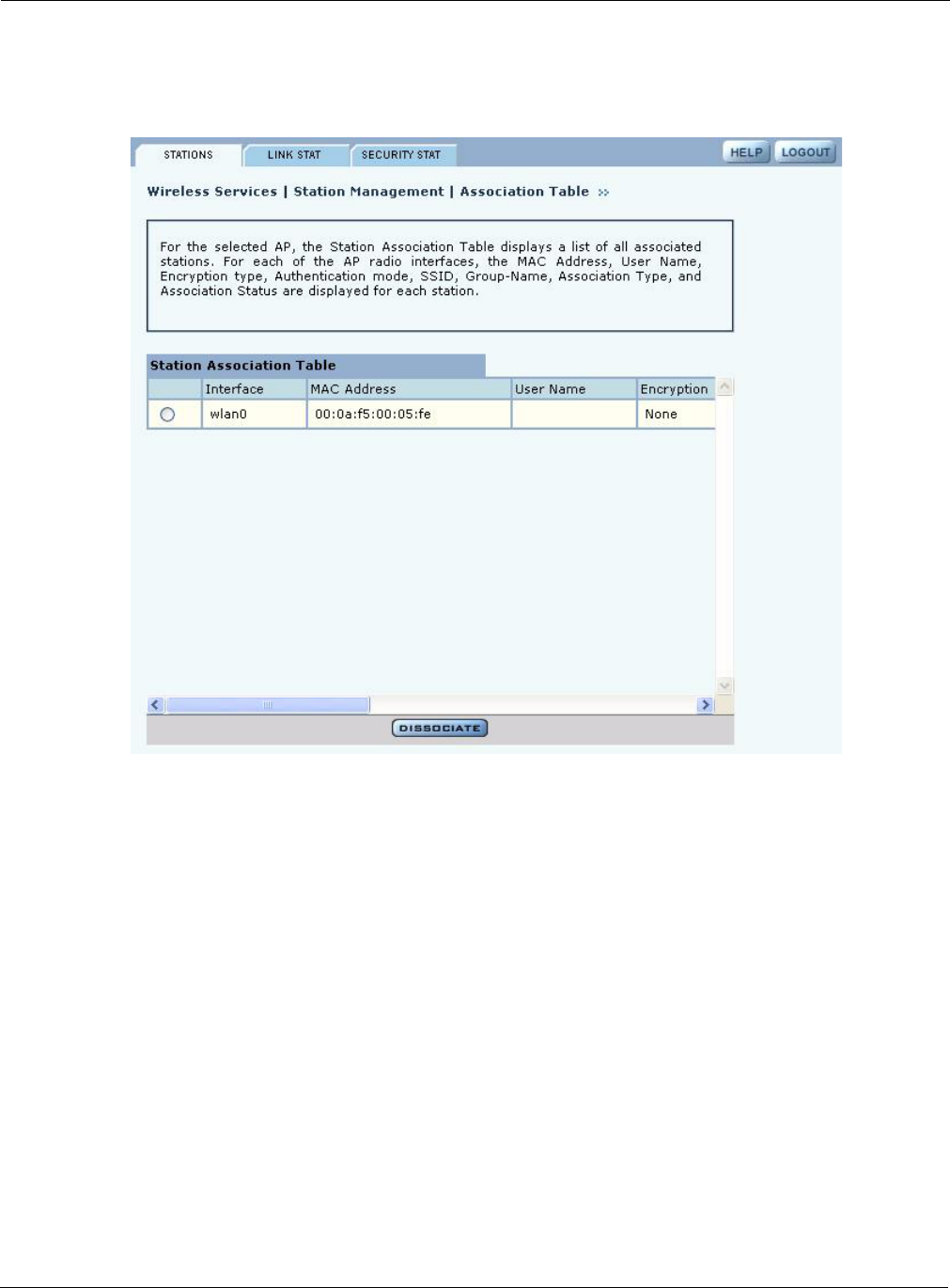
4 Configuring Radio Settings
92 Installation and User Guide: Airgo Access Point
Stations
The Stations tab (Figure 60) shows the client stations currently associated to the AP.
Figure 60: Station Management - Stations
Use this panel to control association to the Airgo AP. The panel lists the following information for
each client station associated to the AP:
Field Description
Interface The AP radio (wlan0, wlan1)
MAC address MAC address of the client station
User Name User name assigned through the RADIUS server (if MAC ACL is used, the
user name is the MAC address of the client station)
Encryption Type of encryption used by client station (AES, TKIP, WEP, or no
encryption)
Authentication Type of authentication used by the client station (Open, Shared Key, EAP, or
MAC-ACL)
SSID SSID to which the client station is associated
Group name Group to which the client station belongs
Association Type Normal or transferred (transferred means that the client station has been
moved to the second AP radio)
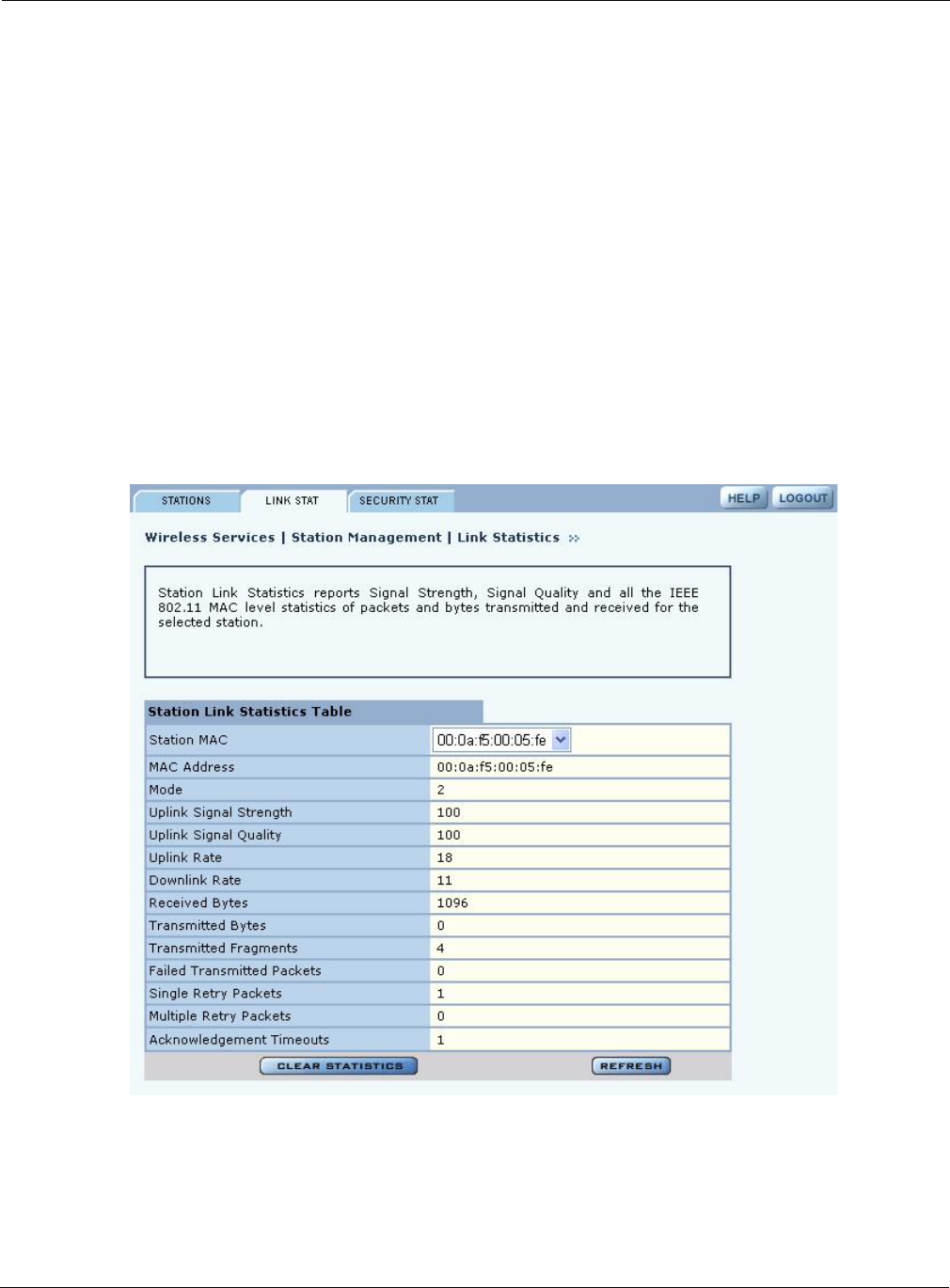
Managing Client Stations
Installation and User Guide: Airgo Access Point 93
Select a station from the list and click a button at the bottom of the panel to perform any of the
following functions:
Link Statistics
The Link Stats table (Figure 61) provides details on the signal quality and strength between the AP
and client station.
Figure 61: Station Link Statistics
Association Status Associated or reassociated to the AP
Item Description
Disassociate Detach the station from the AP and remove station related information.
Link Stats Display information about the link strength and quality between the AP and
station.
Security Stats Display current security statistics.
Field (continued) Description

4 Configuring Radio Settings
94 Installation and User Guide: Airgo Access Point
Select a station from the Station Associations table and click Link Stats to display the following
information:
Security Statistics
The Security Stats table (Figure 62) provides detailed security information for the connection
between the AP and client station.
Field Description
Station MAC address The MAC address that identifies the station
Mode 802.11 mode used by the station (11a, 11b, or 11g)
Uplink Signal Strength Average signal strength on uplink (station-to-AP direction) as a percentage
Uplink Signal Quality Average signal quality on uplink (station-to-AP direction) as a percentage
Uplink Rate Average uplink data rate on uplink (Mbps)
Downlink rate Average downlink data rate on uplink (Mbps
Received Bytes Bytes received from the station
Transmitted Bytes Bytes transmitted to the station
Transmitted Fragments Count of acknowledged MPDUs
Failed Transmitted
Packets
Number of MSDUs that were not transmitted successfully because retries
exceeded short or long retry limit
Single Retry Packets Number of packets that were successfully transmitted after one retry
Multiple Retry Packets Number of packets that were successfully transmitted after multiple retries
Acknowledgement
Timeouts
Number of times the AP timed out while waiting for an 802.11 ACK frame
from the selected STA
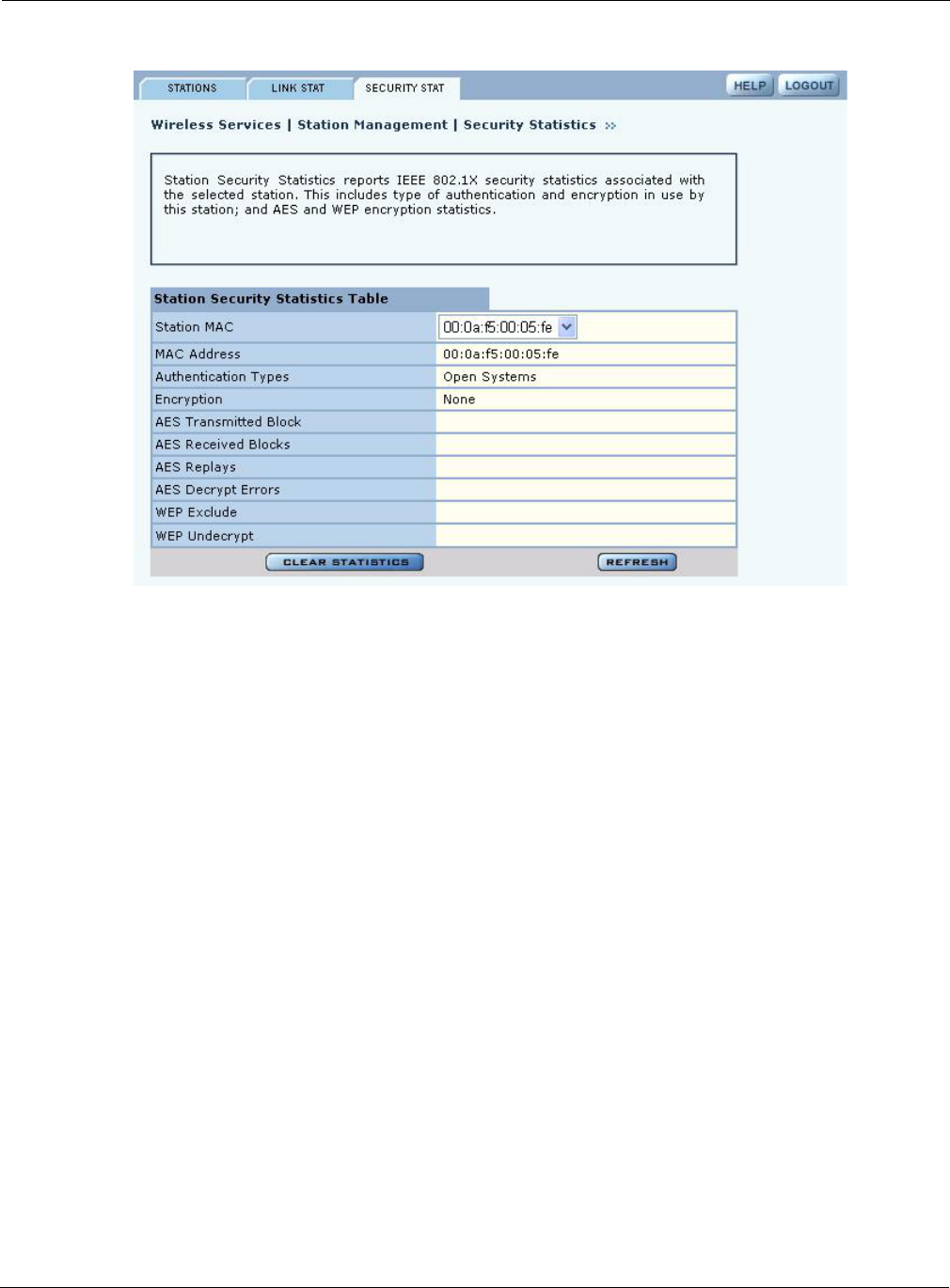
Configuring Inter Access Point Protocol (IAPP)
Installation and User Guide: Airgo Access Point 95
Figure 62: Station Security Statistics
Select a station from the Station Associations table and click Security Stat to display the following
information:
Configuring Inter Access Point Protocol (IAPP)
Inter-Access Point Protocol enables neighboring access points to keep up-to-date information
concerning the status of roaming client stations. Select IAPP Configuration from the Wireless
Services menu to configure the IAPP settings and to view the associated topology and statistics.
Field Description
Station MAC The MAC address that identifies the client station
MAC Address MAC address of the AP
Auth Type Authentication used by station (Open, Shared key, EAP, or MAC-ACL)
Encryption Encryption used by station (AES, TKIP, WEP, or open access)
AES Transmitted
Blocks
Number of AES transmitted blocks (valid only if encryption is AES)
AES Received Blocks Number of AES received blocks (valid only if encryption is AES)
AES Replays Number of AES replays (valid only if encryption is AES)
AES Decrypt Errors Number of AES decryption errors (valid only if encryption is AES)
WEP Excluded Count Number of WEP exclude packets (valid only if encryption is WEP)
WEP Undecryptable
Count
Number of frames received that are NOT encrypted (and thus are not
decryptable)
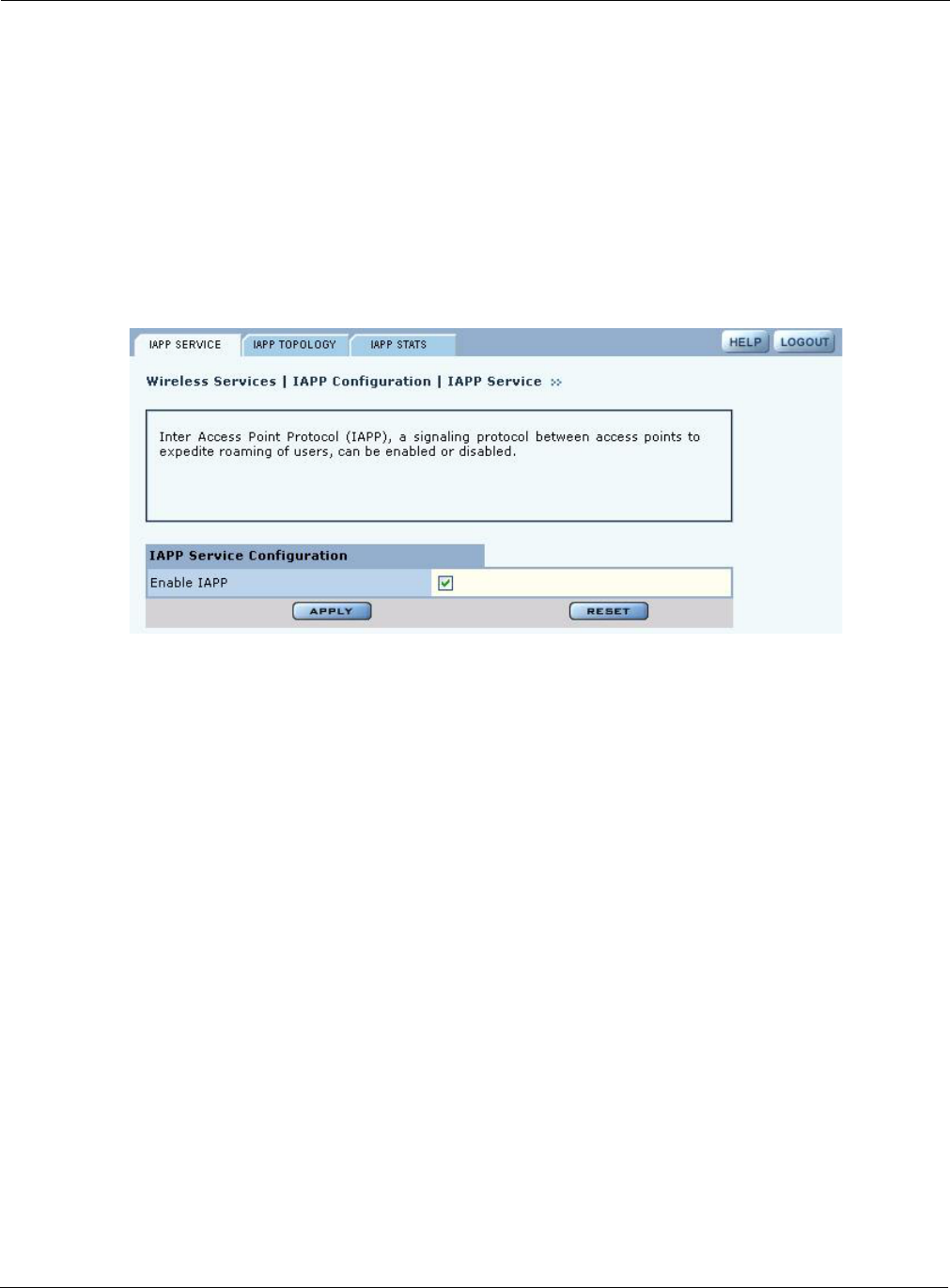
4 Configuring Radio Settings
96 Installation and User Guide: Airgo Access Point
The panel contains the following tabs:
•IAPP Service — Enable or disable IAPP.
•Topology — View BSSID, IP address, and compatibility details.
•Stats — View statistics details, including notifications sent and received, “move” notification
and response details, and details on Intra-AP moves.
IAPP Service
Use the IAPP Service tab (Figure 63) to enable IAPP. Selecting Enable IAPP initializes IAPP to
perform network discovery and communicate with other APs. Click Apply to save changes.
Figure 63: IAPP Configuration - IAPP Service
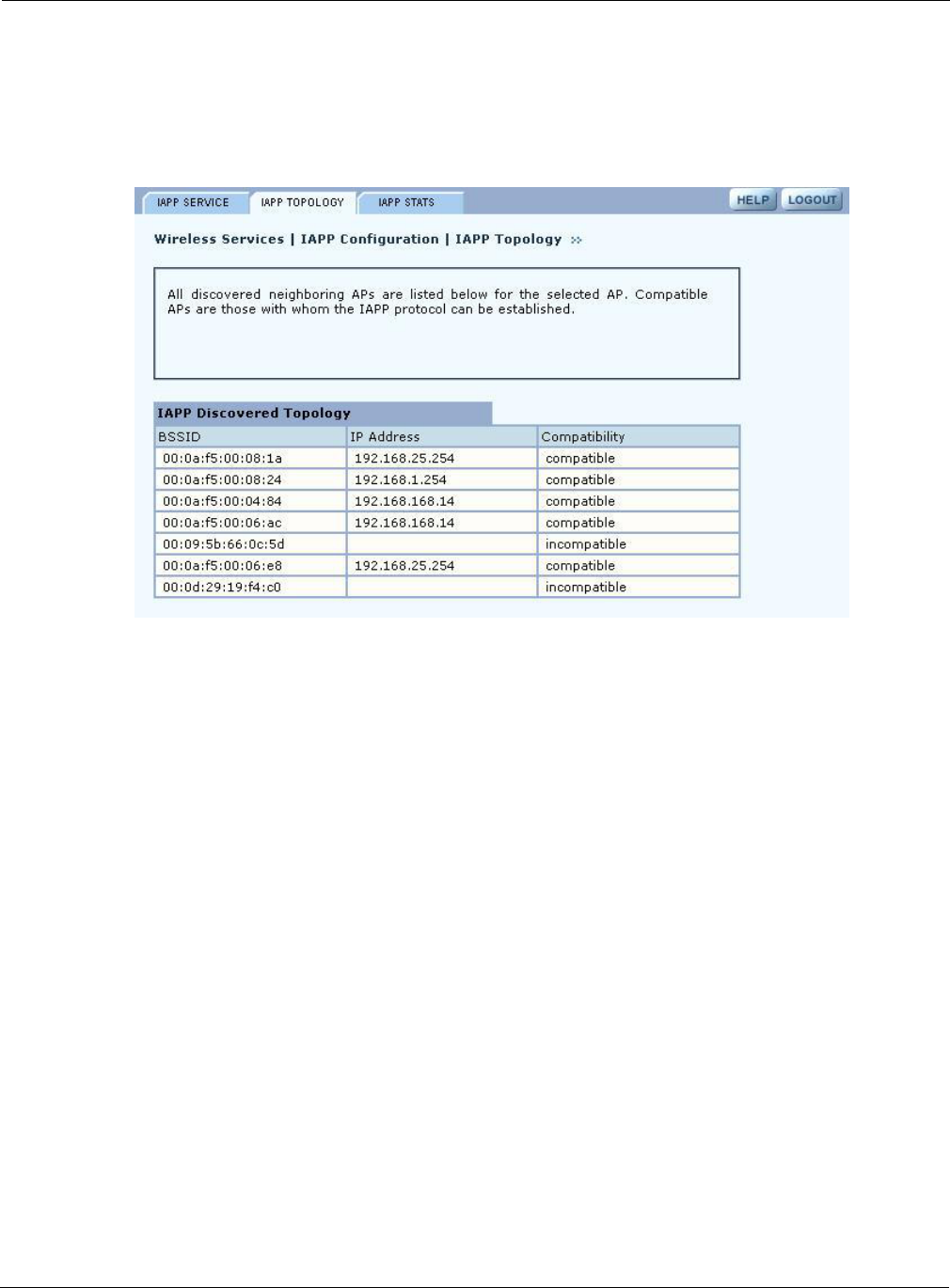
Configuring Inter Access Point Protocol (IAPP)
Installation and User Guide: Airgo Access Point 97
IAPP Topology
The read-only IAPP Topology tab (Figure 64) displays information about all the neighboring APs
this AP has discovered, including the BSSID, IP address, and Compatibility (whether the IAPP
protocol can be established with the neighboring AP).
Figure 64: IAPP Configuration - IAPP Topology
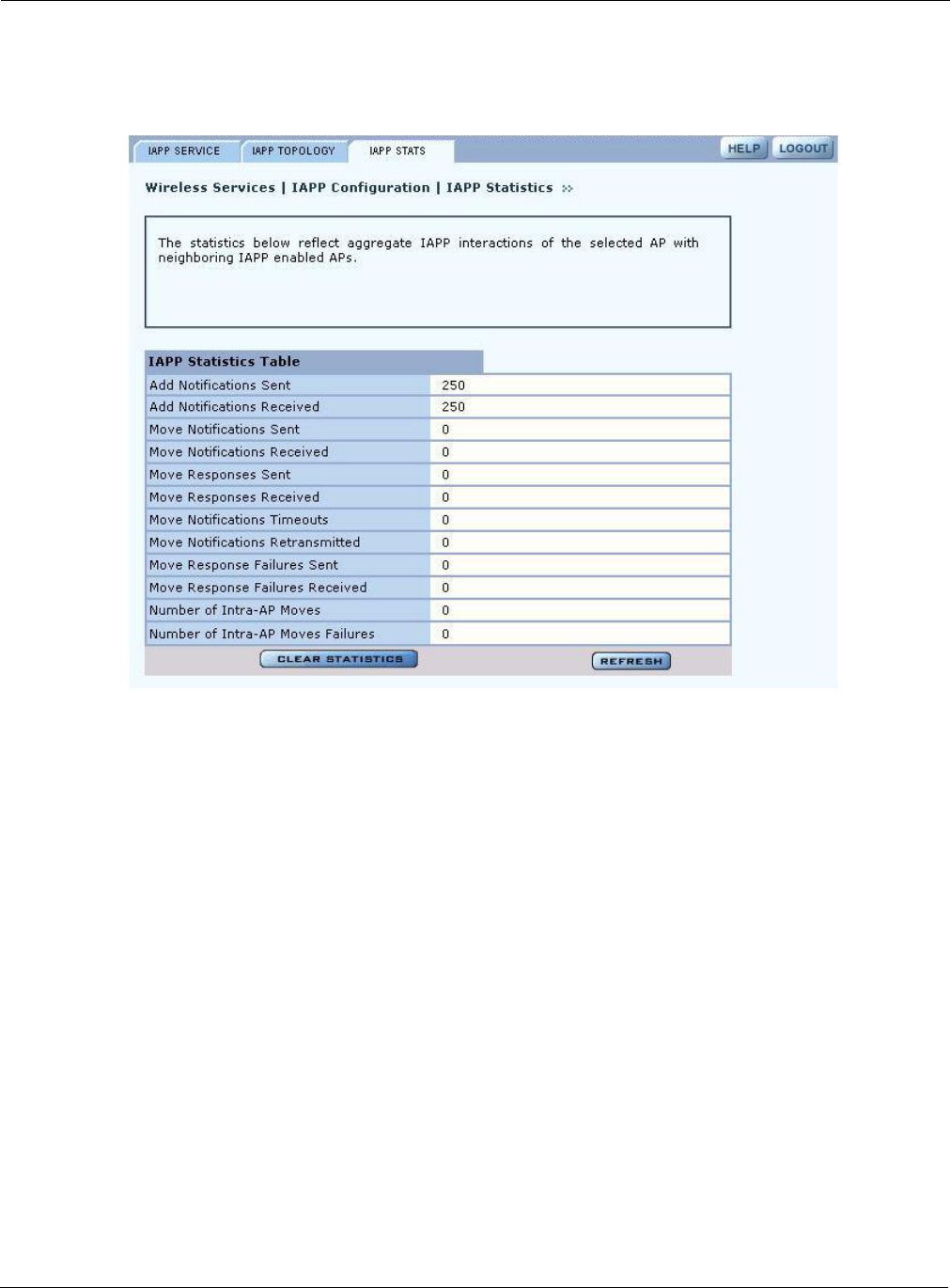
4 Configuring Radio Settings
98 Installation and User Guide: Airgo Access Point
IAPP Statistics
The IAPP Stats tab (Figure 65) lists information about IAPP activity.
Figure 65: IAPP Configuration - IAPP Stats
This tab contains the following information:
Item Description
Add Notifications Sent Number of add-notifications sent to other APs in the local multicast domain
due to stations associating to the AP
Add Notifications
Received
Number of add-notifications received by the AP due to stations associating
with other APs in the local multicast domain
Move Notifications Sent Number of move notifications sent to other APs where the stations were
previously associated
Move Notifications
Received
Number of move notifications received from other APs to which the stations
are currently associated
Move Responses Sent Number of move responses sent to other APs when stations have reassociated
with the other APs
Move Responses
Received
Number of move responses received from other APs in the process of stations
reassociating with this AP
Move Notifications
Timeouts
Number of move notifications that were not sent in the maximum time
allowed for a move transaction
Move Notifications
Retransmitted
Number of times the move notifications were retransmitted for all the move
transactions (not supported)

Performing Radio Diagnostics
Installation and User Guide: Airgo Access Point 99
Click Clear Statistics to return the statistics to zero and begin re-collecting them, and click
Refresh to update the display with the most current information.
Performing Radio Diagnostics
Choose Radio Diagnostics from the Wireless Services menu to test the radio signal between the
AP and a client station. The panel contains the following tabs:
•Link Test — Test the radio link between the AP and a client station.
•Walk Test — Advanced parameters regarding rate and range performance testing.
Move Response Failures
Sent
Number of move responses with a FAILURE status sent to other APs during
the station reassociating process
Move Response Failures
Received
Number of move responses with a FAILURE status received from other APs
during the station reassociating process
Number of Intra-AP
Moves
Number of successful station reassociations between APs
Number of Intra-AP
Moves Failures
Number of unsuccessful station reassociations between APs
Item Description
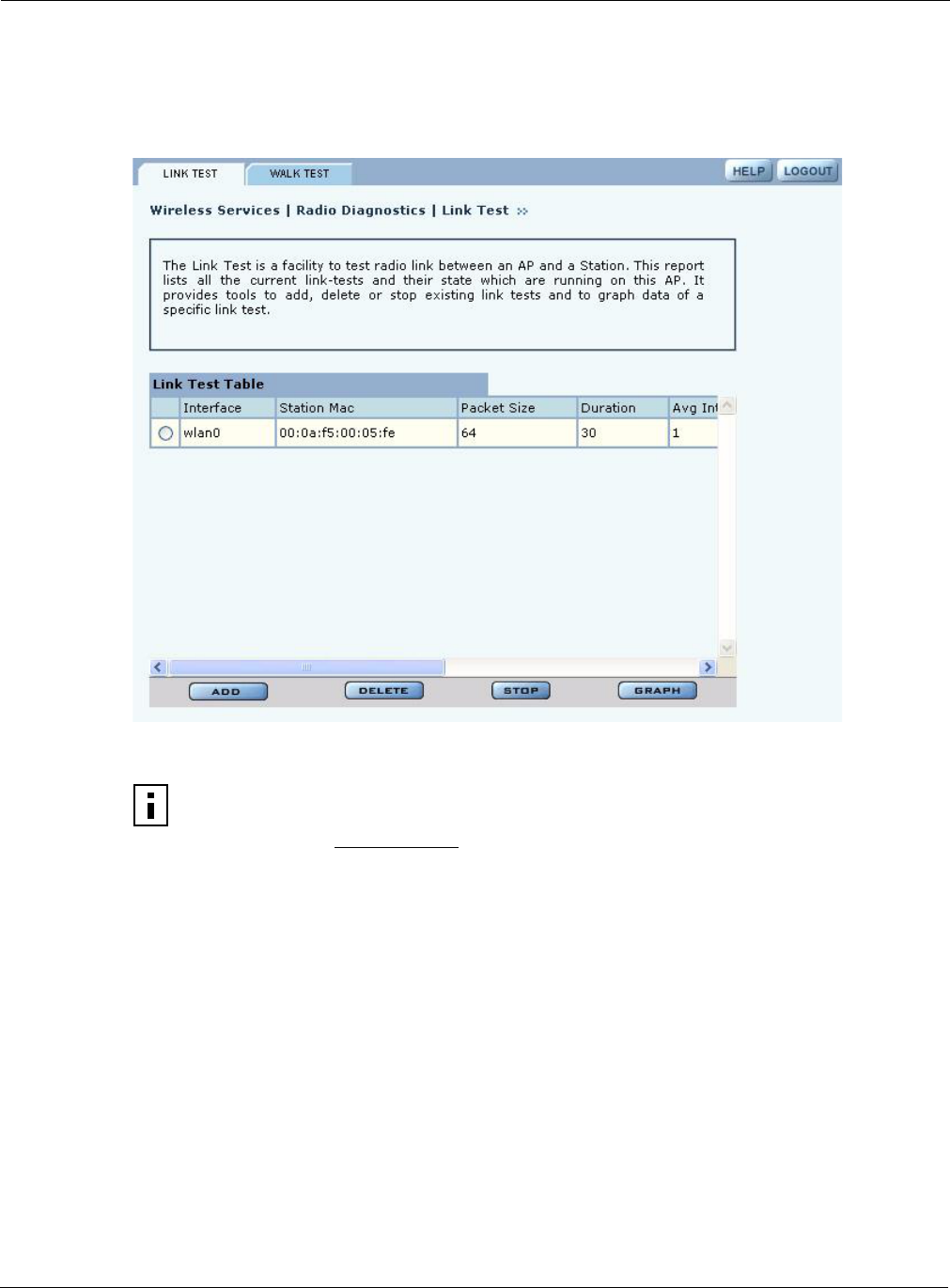
4 Configuring Radio Settings
100 Installation and User Guide: Airgo Access Point
Link Test
Use the Link Test tab (Figure 66) to test connections to IP devices or run performance tests on
specified links.
Figure 66: Radio Diagnostics - Link Test
The Link Test tab includes the following information for each defined link test:
NOTE: The Link Test graphing feature requires the installation of Sun Java (not
Microsoft Java) on your Microsoft Internet-Explorer web browser. For download
instructions, go to www.java.com.
Field Description
Interface Access point radio
Station MAC MAC address of the station included in the link test
Packet Size Size of each link packet (in bytes)
Duration Period during which the which the test runs
Average Interval Sampling interval
Status Current status of the link test (click the Link Test tab to refresh)

Performing Radio Diagnostics
Installation and User Guide: Airgo Access Point 101
To perform a link test:
1Click Add to open the Link Test Setup entry panel (Figure 67).
Figure 67: Radio Diagnostics - Link Test - Setup
2Configure the following:
3Click OK to save the test.
To confirm that the test is running, click Link Test to return to the Link Test table. Scroll the table
columns to the right to view the Status column. When the test begins, the column displays the
message: Link Test Active. Continue to refresh the display until you see the message: Link
Test Completed Successfully.
Other recommendations for running a link test:
•Set the test duration to be greater than five minutes (or equivalent number of packets, for
example five minutes = 1200 packets), and set the averaging interval greater than 30 seconds.
This compensates for any momentary glitches in the wireless link.
•Generate traffic (such as ping traffic) to the station when performing the link test. If rate
adaptation is active, this helps the uplink and downlink data rates settle at the maximum
sustainable rates for that link.
A maximum of 10 link tests can be active on an AP at one time. The collected link test data is
retained even after the link test is finished, until manually deleted.
To graph the results of a link test, select the test on the Link Test tab, and click Graph. The Graph
panel (Figure 68) opens. Only one graph can be displayed at a time.
Field Description
Interface Select the AP radio.
Station MAC Select the MAC address of the station included in the link test.
Test Criteria Select whether the test is for a specified duration (seconds) or number of
packets. Enter the duration in the area to the right of the Test Criteria pull-
down list.
Packet Size Specify the size of each link packet (in bytes).
Average Interval Enter the interval over which link test data such as signal strength or signal
quality is averaged.
NOTE: When the link test is first invoked, the Java Applet will post a standard Java
security warning. Accept the warning to continue. A single link test graph can be
displayed at a time.
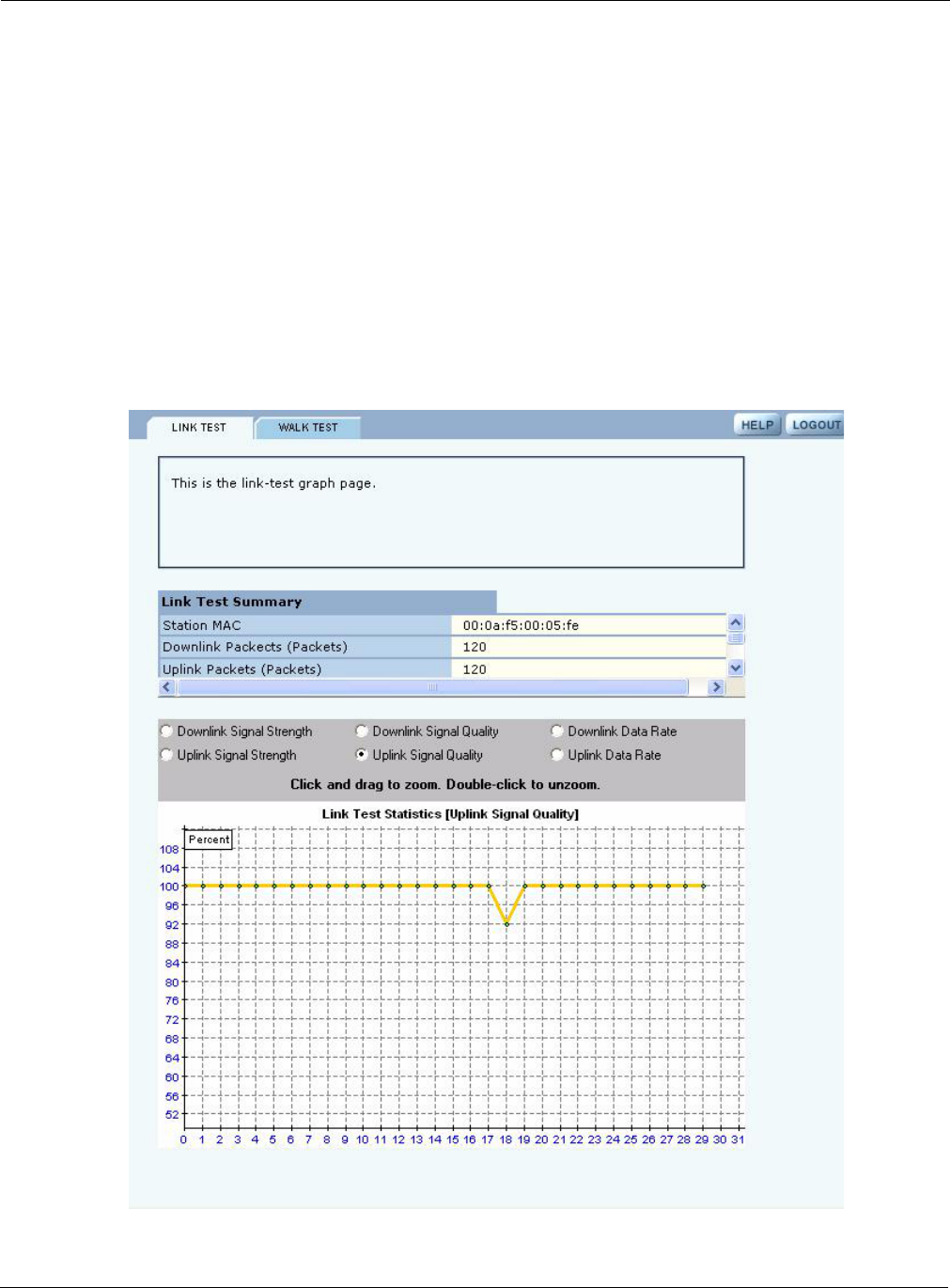
4 Configuring Radio Settings
102 Installation and User Guide: Airgo Access Point
Select from the following set of link test parameters to display a graph of the test results:
When a parameter is selected, that graph is displayed.
Figure 68: Radio Diagnostics - Link Test Graph
Item Description
Downlink signal
strength
Strength of the signal sent from the AP to the client station (percentage)
Uplink signal strength Strength of the signal sent from the client station to the AP (percentage)
Downlink signal quality Quality of the signal sent from the AP to the client station (percentage)
Uplink signal quality Quality of the signal sent from the client station to the AP (percentage)
Downlink data rate Transmission rate from the AP to the client station (Mbps)
Uplink data rate Transmission rate from the client station to the AP (Mbps)
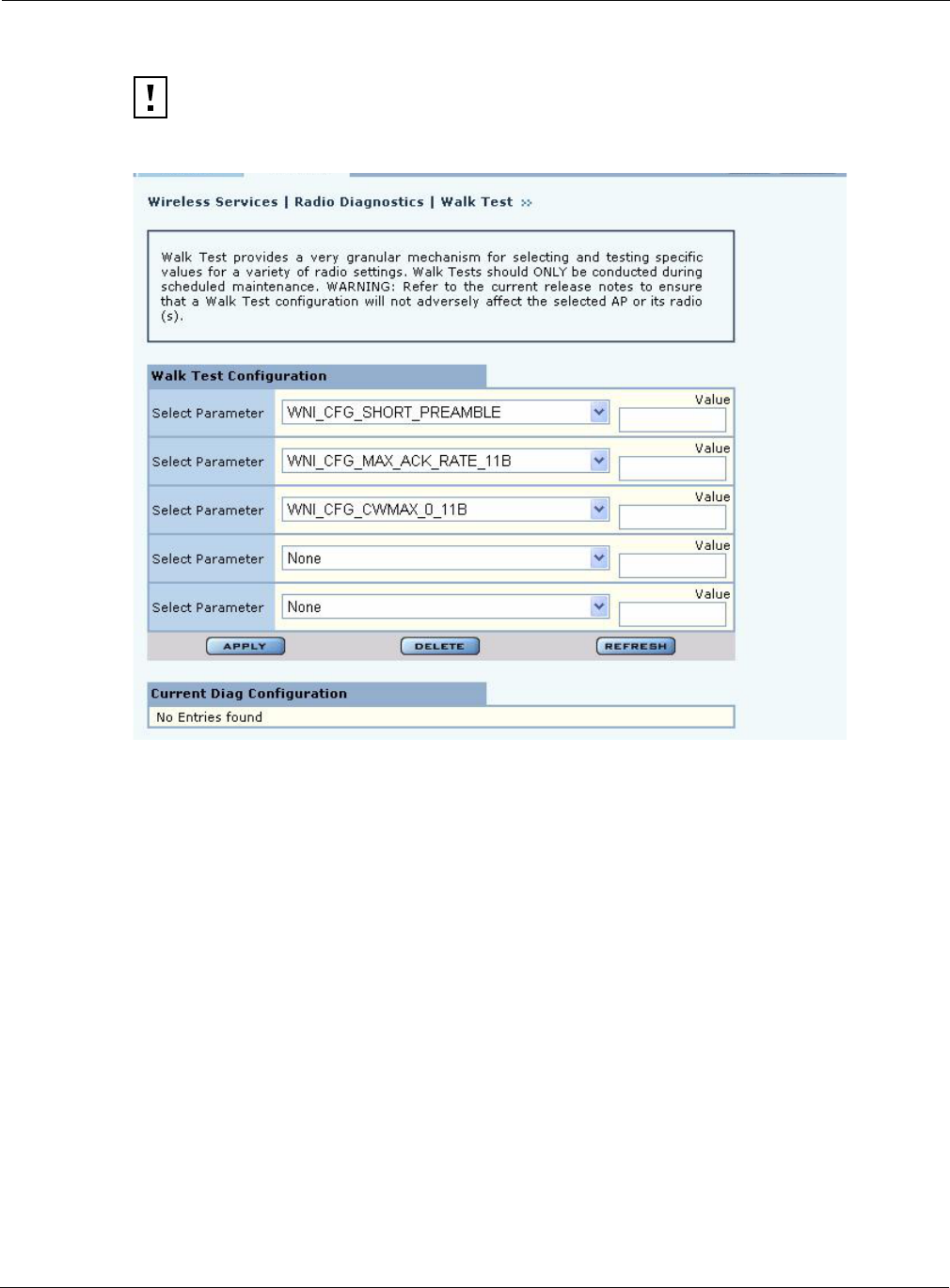
Performing Radio Diagnostics
Installation and User Guide: Airgo Access Point 103
Walk Test
Figure 69: Radio Diagnostics - Walk Test
CAUTION: These Radio Diagnostics are to be used only by Product Engineers. The
information below is for reference only.
Parameter Parameter Description Range/Units
WNI_CFG_CURRENT_TX_ANTENNA # of TX chains 1 to 2 / +
WNI_CFG_CURRENT_RX_ANTENNA # of RX chains 1 to 3 / –
WNI_CFG_DEFER_THRESHOLD Packet Detection Threshold 0–254 / dBm + 130
WNI_CFG_ACK_TIMEOUT_11A Ack Timeout 802.11a 0 - 100 / Micro
seconds
WNI_CFG_ACK_TIMEOUT_11B Ack Timeout 802.11b 0 - 100 / Micro
seconds
WNI_CFG_MAX_ACK_RATE_11A Max Ack Rate 802.11a MAC rate encoding:
Rate - Entered Value
6 - 12
9 - 18
12 - 24
18 - 36
24 - 48
36 - 72

4 Configuring Radio Settings
104 Installation and User Guide: Airgo Access Point
WNI_CFG_MAX_ACK_RATE_11B Max Ack Rate 802.11b MAC rate encoding:
Rate - Entered Value
1 - 2
2 - 4
5.5 - 11
11 - 22
WNI_CFG_SHORT_PREAMBLE Enables or Disables Short
Preamble
DISABLE (0),
ENABLE (1)
WNI_CFG_CWMIN_0_11A Min Contention Window
Size for 802.11a (TC0)
0 - 1023 / slots
WNI_CFG_CWMIN_0_11B Min Contention Window
Size for 802.11b (TC0)
0 - 1023 / slots
WNI_CFG_CWMIN_0_11G Min Contention Window
Size for 802.11g (TC0)
0 - 1023 / slots
WNI_CFG_CWMAX_0_11A Max Contention Window
Size for 802.11a (TC0)
0 - 1023 / slots
WNI_CFG_CWMAX_0_11B Max Contention Window
Size for 802.11b (TC0)
0 - 1023 / slots
WNI_CFG_CWMAX_0_11G Max Contention Window
Size for 802.11g (TC0)
0 - 1023 / slots
WNI_CFG_PROXIMITY Used to set the transmit
power for radio
0 (operates at max
power); 1 (operates at
reduced power)
Parameter (continued) Parameter Description Range/Units

Installation and User Guide: Airgo Access Point 105
5Configuring Networking Settings
This chapter explains how to configure the advanced networking features of the Airgo Access
Point. It includes the following topics:
•Introduction
•Configuring Bridging Services
•Configuring IP Routes
•Configuring VLANs
•Configuring Quality of Service
•Configuring Advanced QoS
•Configuring Packet Filters
•Configuring Interfaces
•Configuring SNMP
•Ping Test
Introduction
The Airgo Access Point provides advanced features to configure wireless networking services and
extend services to network users. From the Networking Services menu, assign interfaces, define
quality of service, configure VLANs, and define packet filters. Statistics are also available to
monitor network activity.
Interfaces
Figure 70 illustrates the physical and logical elements of the wireless network. Each Airgo Access
Point has virtual interfaces that correspond to specific communications functions, as listed in
Table 11. The interfaces wlan0 and wlan1 provide access to the BSS created on the AP radios; the
interface eth0 provides access to the Ethernet network. In addition, a separate interface is reserved
for each wireless backhaul trunk.
NOTE: It is not necessary to modify any of the default networking settings in order to
get a wireless network up and running. The default settings may also be acceptable for
normal operation of small to mid-size networks.
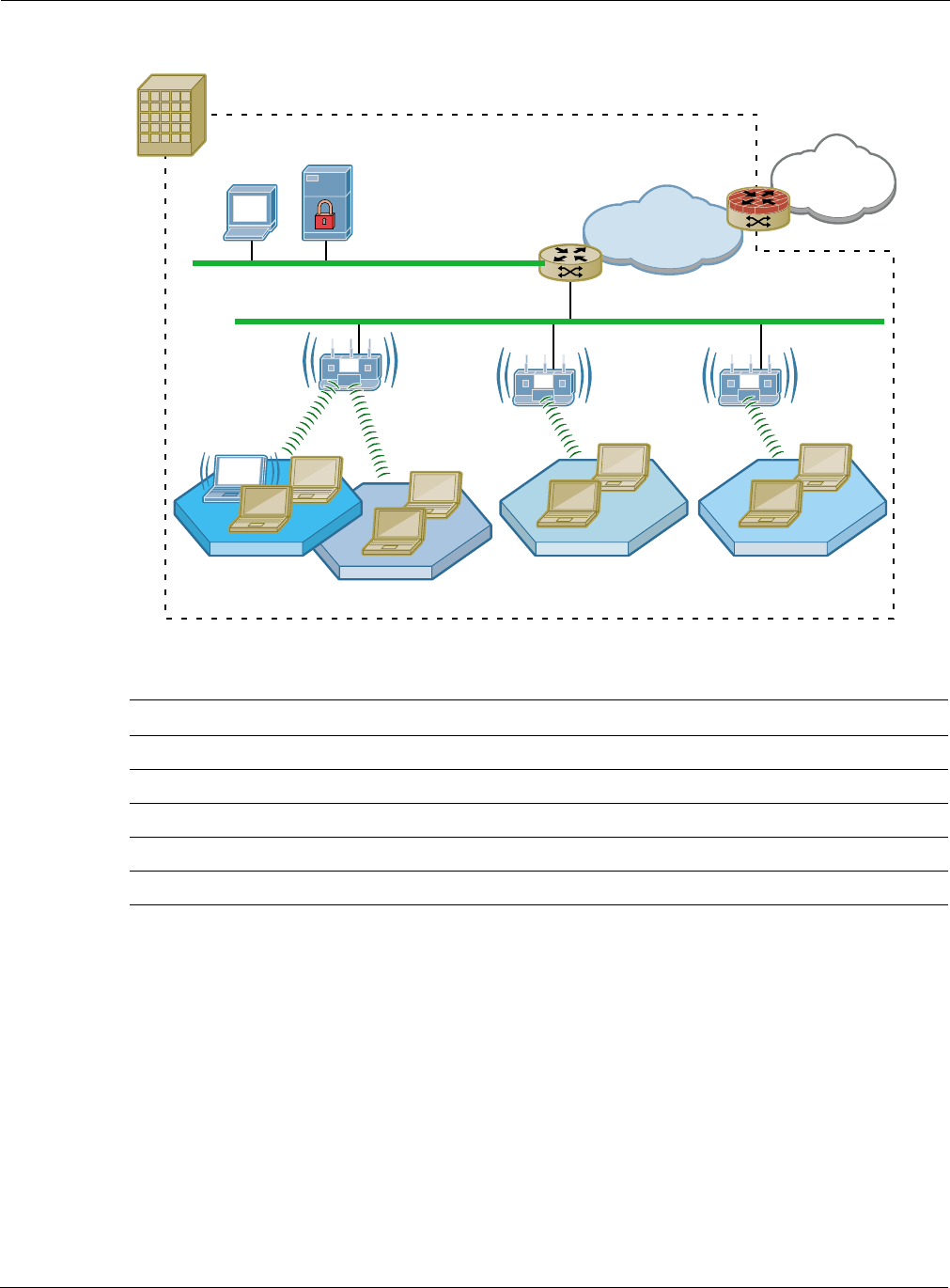
5 Configuring Networking Settings
106 Installation and User Guide: Airgo Access Point
Figure 70: Airgo Networks Wireless Network Elements
Configuring Bridging Services
Use the Bridging panel, accessible from the Networking Services menu, to view the relationships
among bridges, interfaces, and client stations. The panel contains the following tabs:
•Bridge & STP — View bridges, their interface members, and spanning tree protocol (STP)
settings.
•Bridge Stats — View packet counts for each bridge.
•ARP Table — View the ARP cache.
Bridge and STP
Choose Bridging from the Networking Services menu to open the Bridge & STP tab (Figure 71),
The tab displays how bridging is currently configured and lists the interfaces and MAC addresses
Table 11: AP Interfaces
Interface Description
eth0 Wired Ethernet interface
wlan0 Wireless interface, radio 0
wlan1 Wireless interface, radio 1
wlan0.tkx Backhaul x created on wlan0 (each radio can support multiple backhauls)
wlan1.tkx Backhaul x created on wlan1 (each radio can support multiple backhauls)
Enterprise Boundry
NMS RADIUS
10/100 Ethernet
Corporate
Network
Internet
LAN Switch/Router
WAN Router
with Firewall
Network Operations Center
AP with
2 Radios AP with
1 Radio
AP with
1 Radio
802.11a
802.11g/b
802.11a
(or 802.11g/b)
802.11g/b
(or 802.11a)
A0008C
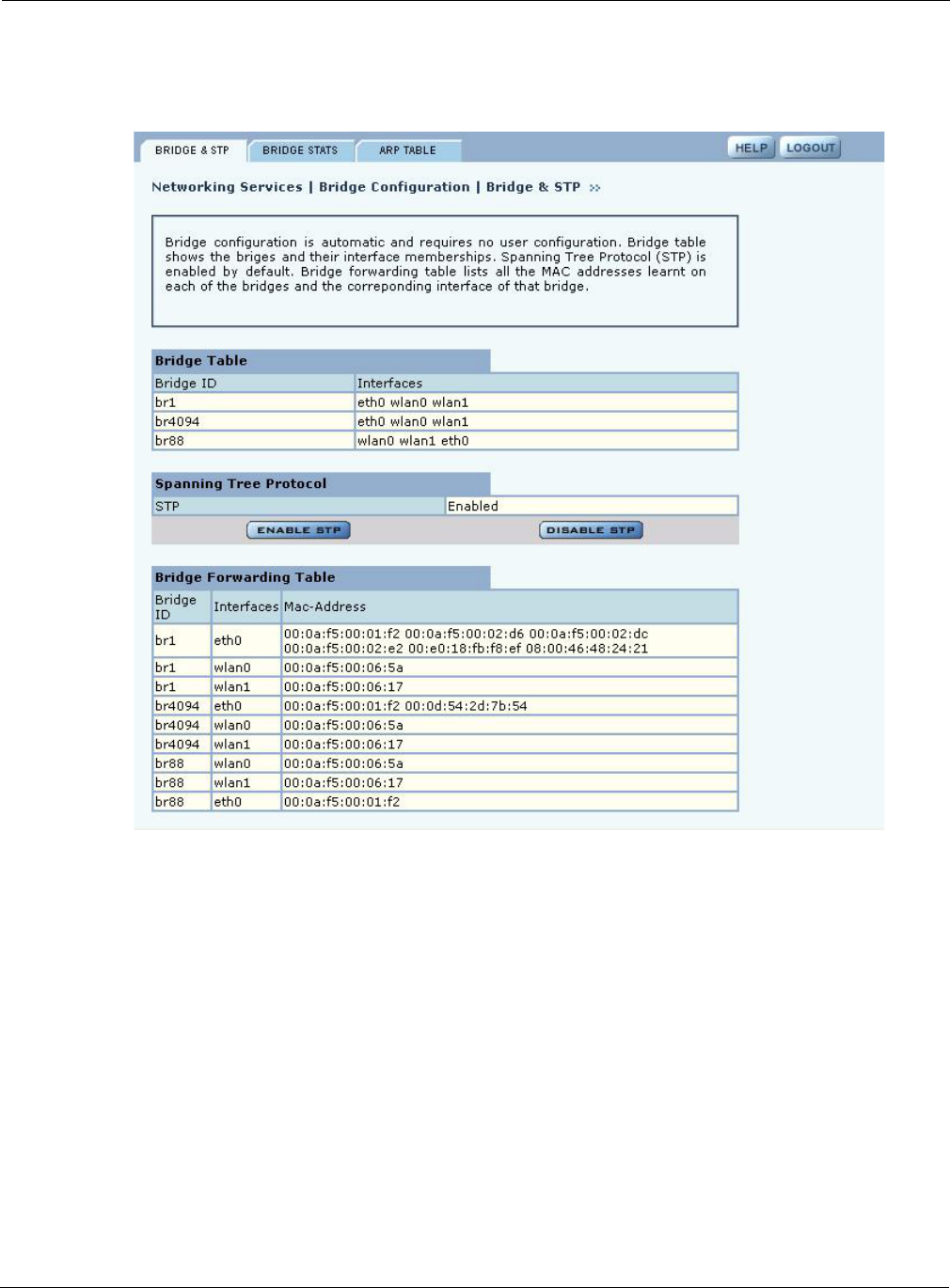
Configuring Bridging Services
Installation and User Guide: Airgo Access Point 107
learned at each interface (port) of the bridge. The bridge configuration is automatic and requires no
user configuration.
Figure 71: Bridge Configuration - Bridge & STP
Each bridge name is composed of a prefix, br, together with a bridge number. When the VLAN
feature is enabled, the VLAN ID is used as the bridge number. The following IDs are reserved:
•br1 represents VLAN 1 and is the default bridge for forwarding user data traffic.
•br4094 represents VLAN 4094, which is an internal VLAN assigned to the default bridge
used for the spanning tree protocol (see the next section).
The Bridge Table lists each bridge and its associated interfaces (or ports). The Bridge Forwarding
Table, located at the bottom of the panel, lists each bridge and interface and specifies which MAC
addresses are learned at the interface.
Spanning Tree Protocol
The Bridge & STP tab also provides an option for enabling or disabling spanning tree protocol
(STP). STP is a protocol that prevents bridging loops from forming due to incorrectly configured
networks. STP provides protection against looping, but it does increase network overhead. Before
STP allows traffic through a specific port, there may be a time lapse of 30 seconds. Operations may
also take longer than normal.
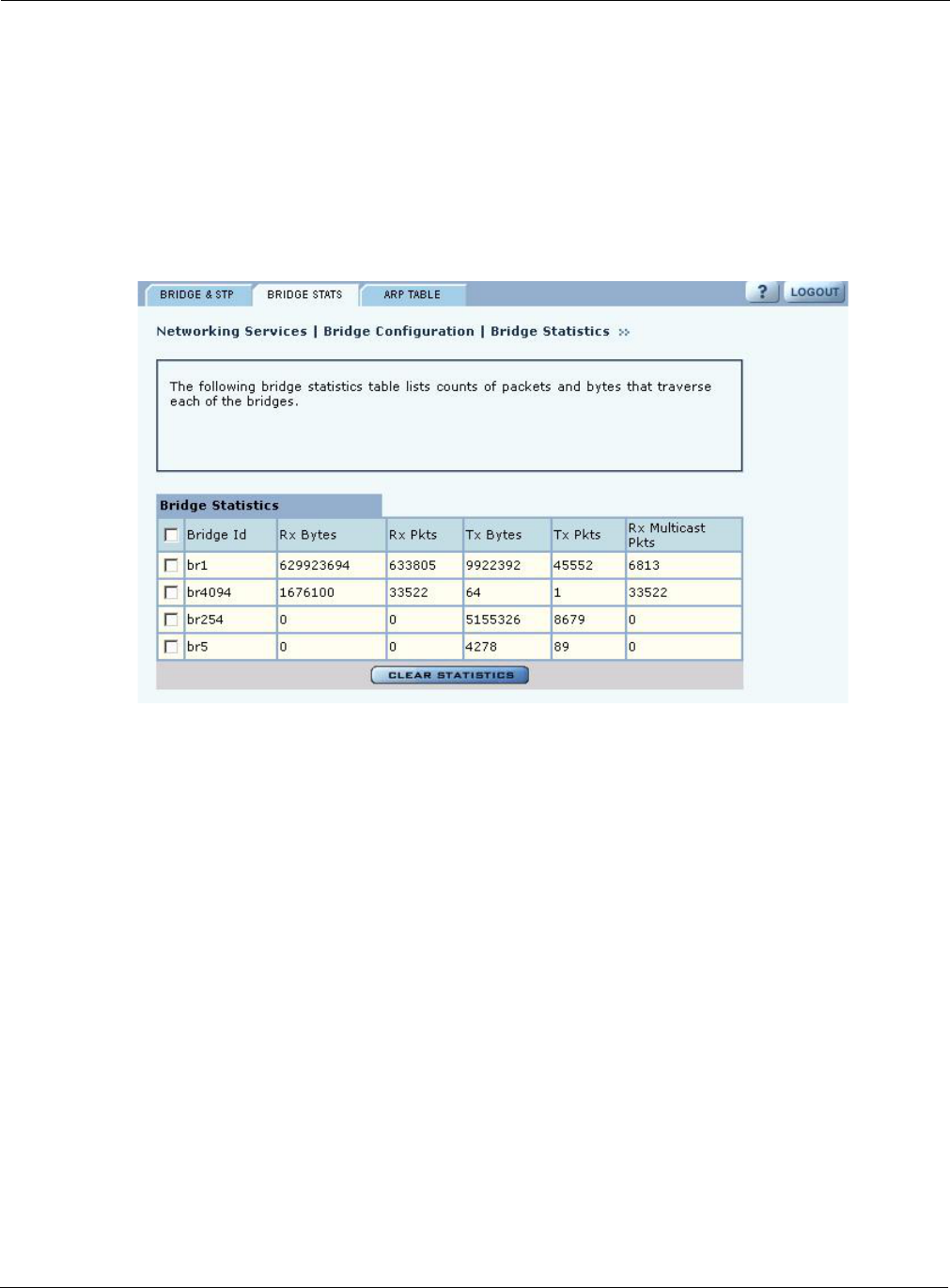
5 Configuring Networking Settings
108 Installation and User Guide: Airgo Access Point
The default setting for STP is Enabled. Disable STP if the network is small to mid-size and
looping is not a concern.
Bridge Statistics
The Bridge Stats tab (Figure 72) provides a summary of transmit/receive statistics for each bridge
or VLAN. The statistics are calculated from the last time the AP was rebooted or the Clear
Statistics button was selected. Click Clear Statistics to return the collected values to zero and start
collecting statistics again.
Figure 72: Bridge Configuration - Bridge Stats
ARP Table
The Address Resolution Protocol (ARP) tab (Figure 73) displays the current mapping of IP
addresses to MAC addresses associated with the listed interface. During normal operations, the
ARP table is updated automatically based on the number of MAC entities in the network. If a
mapping changes, however, some entries of the ARP table may become invalid. In this case, click
Clear ARP Cache on the tab to remove the current ARP entries and repopulate the table
automatically with valid entries. Click Refresh to update the display.
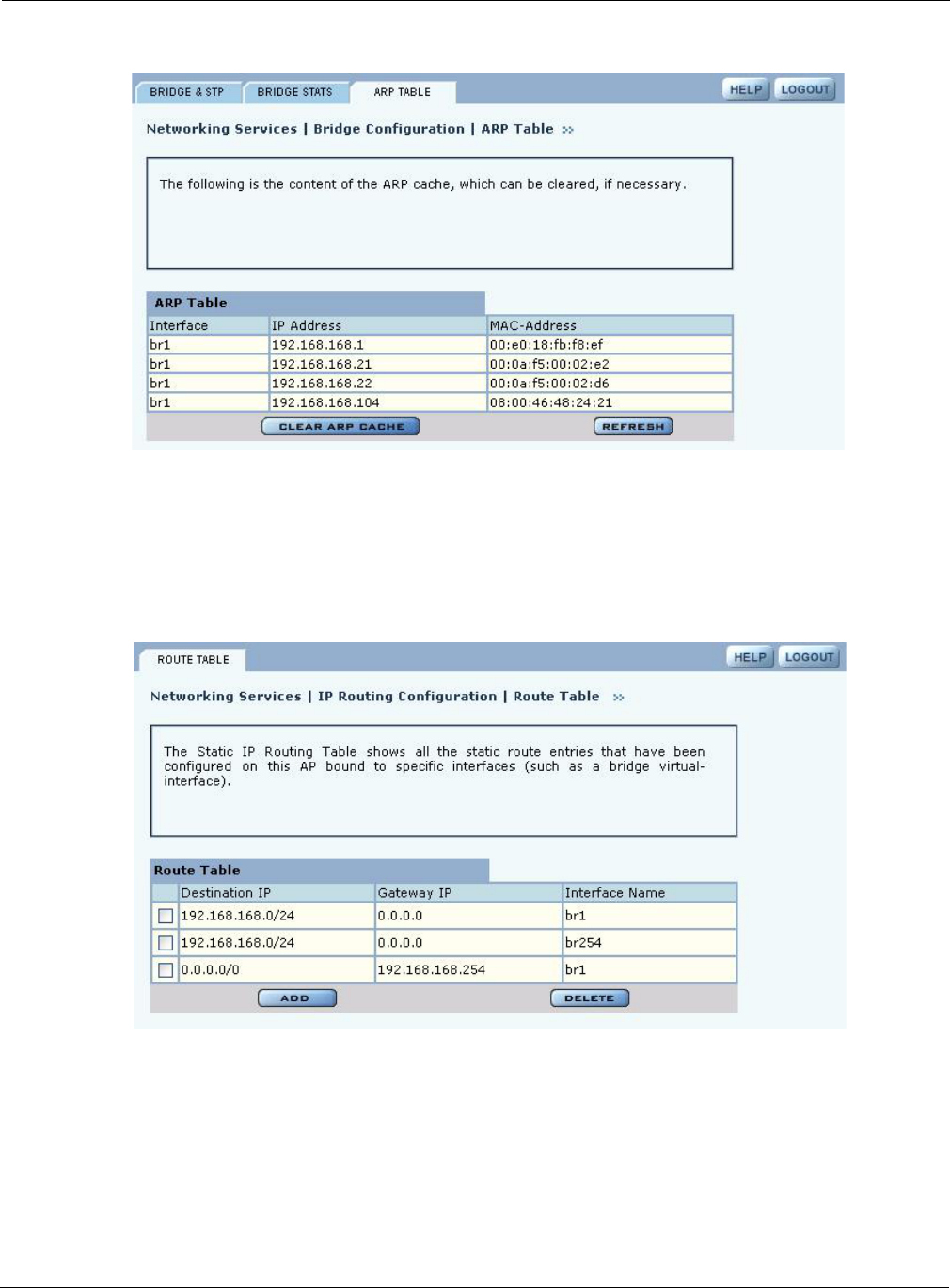
Configuring IP Routes
Installation and User Guide: Airgo Access Point 109
Figure 73: Bridge Configuration - ARP Table
Configuring IP Routes
IP routing expands the addressing capability of the Airgo AP and allows you to mange the AP from
outside its local subnet. Use the IP Routing panel (Figure 74) to explicitly address subnets that are
not local. If a destination subnet is not entered into this panel, then default network routing applies.
Figure 74: IP Routing
The Route table shows the static route entries currently configured on the AP and bound to bridging
interfaces. To create a new route, click Add, enter the following information, and click Save.
Field Description
Destination IP Enter the IP address of the subnet to which packets can be forwarded, along
with the subnet prefix for the address.

5 Configuring Networking Settings
110 Installation and User Guide: Airgo Access Point
Gateway IP Enter the IP address of the gateway that will route traffic between this AP and
the destination subnet.
Interface Name Enter the name of the bridging interface. Use the br prefix, as described in
“Configuring Bridging Services” on page 106.
Field Description
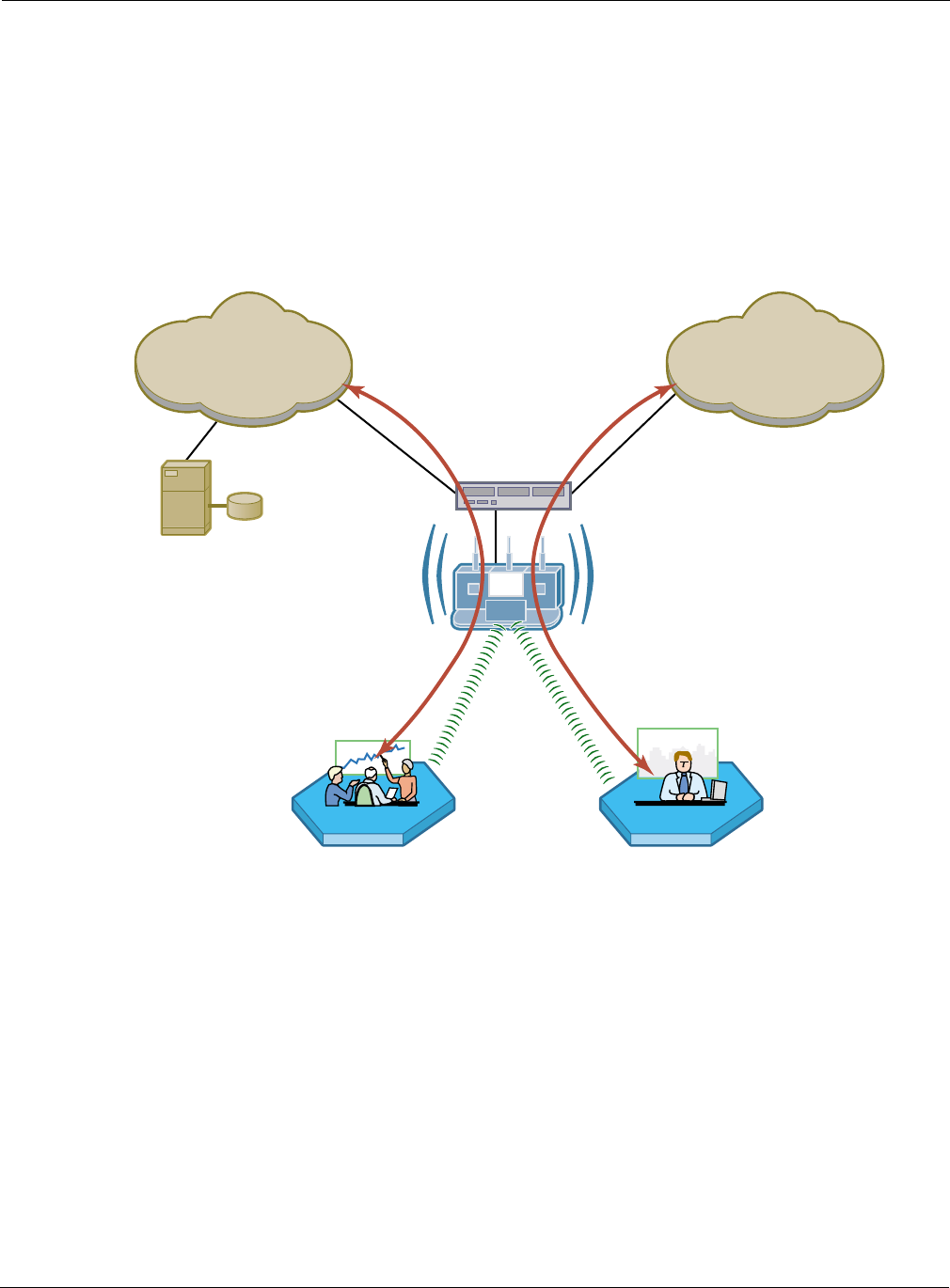
Configuring VLANs
Installation and User Guide: Airgo Access Point 111
Configuring VLANs
VLANs are key to helping enterprises improve network traffic flow, increase load, and deliver
varying levels of service and access to different groups of users. For example, Figure 75 shows how
Acme Works uses two VLANs: one for normal corporate traffic and one for Finance Department
traffic. When a Finance Department user logs in to the network, the Finance group tag is passed to
the Airgo AP, and the Finance service profile, including Finance VLAN, is applied to the user.
Database transaction traffic, which was previously a burden on the overall network, is now handled
through the Finance VLAN and is transparent to normal corporate users.
Figure 75: Example Use of VLANs to Manage Enterprise Traffic
The Airgo AP supports up to 16 VLANs including the default VLAN. Use the VLAN
Configuration panel, accessible from the Networking Services menu, to add new VLANs and map
VLANs to specific AP interfaces (“VLAN Table” on page 112). The VLAN panel contains a list of
users assigned to user VLANs; to make user VLAN assignments, use service profiles (“SSIDs and
Service Profiles” on page 84).
The VLAN Configuration panel contains the following tabs:
•VLAN Table — View the list of currently defined VLANs and add or modify VLANs.
•Interface VLAN—Assign VLANs for untagged frames arriving at the AP.
•User VLAN — View the list of client stations assigned to each VLAN by virtue of user group
membership.
•VLAN Stats — View packet statistics for each VLAN.
RADIUS
Server
A0044B
Corporate VLAN
Corporate VLAN
VLAN Switch
Finance VLAN
Finance VLAN
Corporate Finance
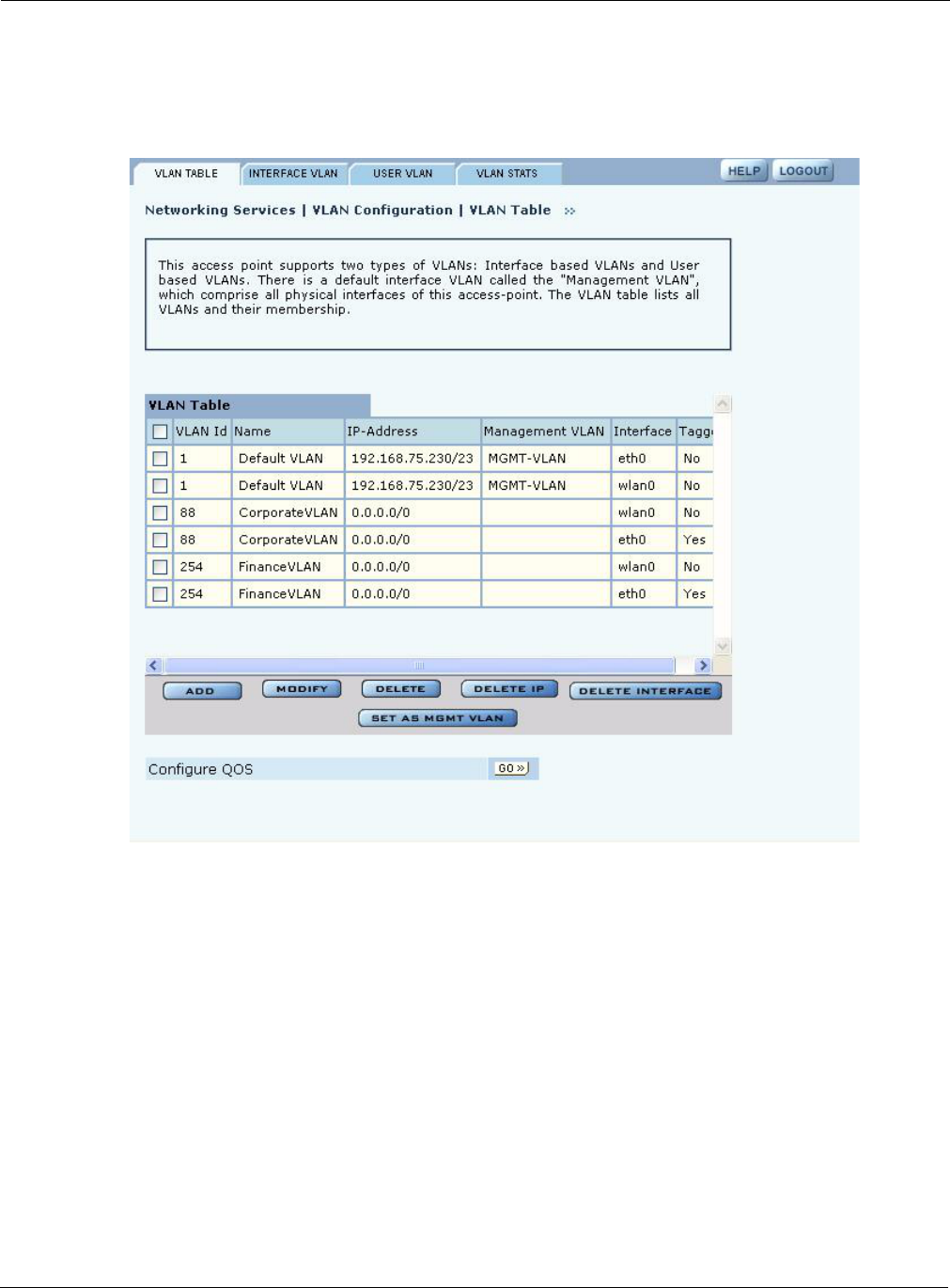
5 Configuring Networking Settings
112 Installation and User Guide: Airgo Access Point
VLAN Table
Choose VLAN from the Networking Services menu to list information about each VLAN and
interface (Figure 76).
Figure 76: VLAN Configuration - VLAN Table
The VLAN table contains the following columns of information:
Field Description
VLAN ID Numeric identifier for the VLAN. In bridging notation, this is the numeric ID
that follows the br prefix.
Name Alphanumeric name of the VLAN. The field is optional, unless it is the
default VLAN. The maximum length of the VLAN name is 80 characters with
no spaces.
IP Address The IP address and subnet prefix assigned to the VLAN. Assigning an IP
address enables the VLAN to be managed from this AP.
Management VLAN Indicates whether this VLAN is the management VLAN.
Interface The logical AP interface. The table contains a separate row for each VLAN/
interface combination.
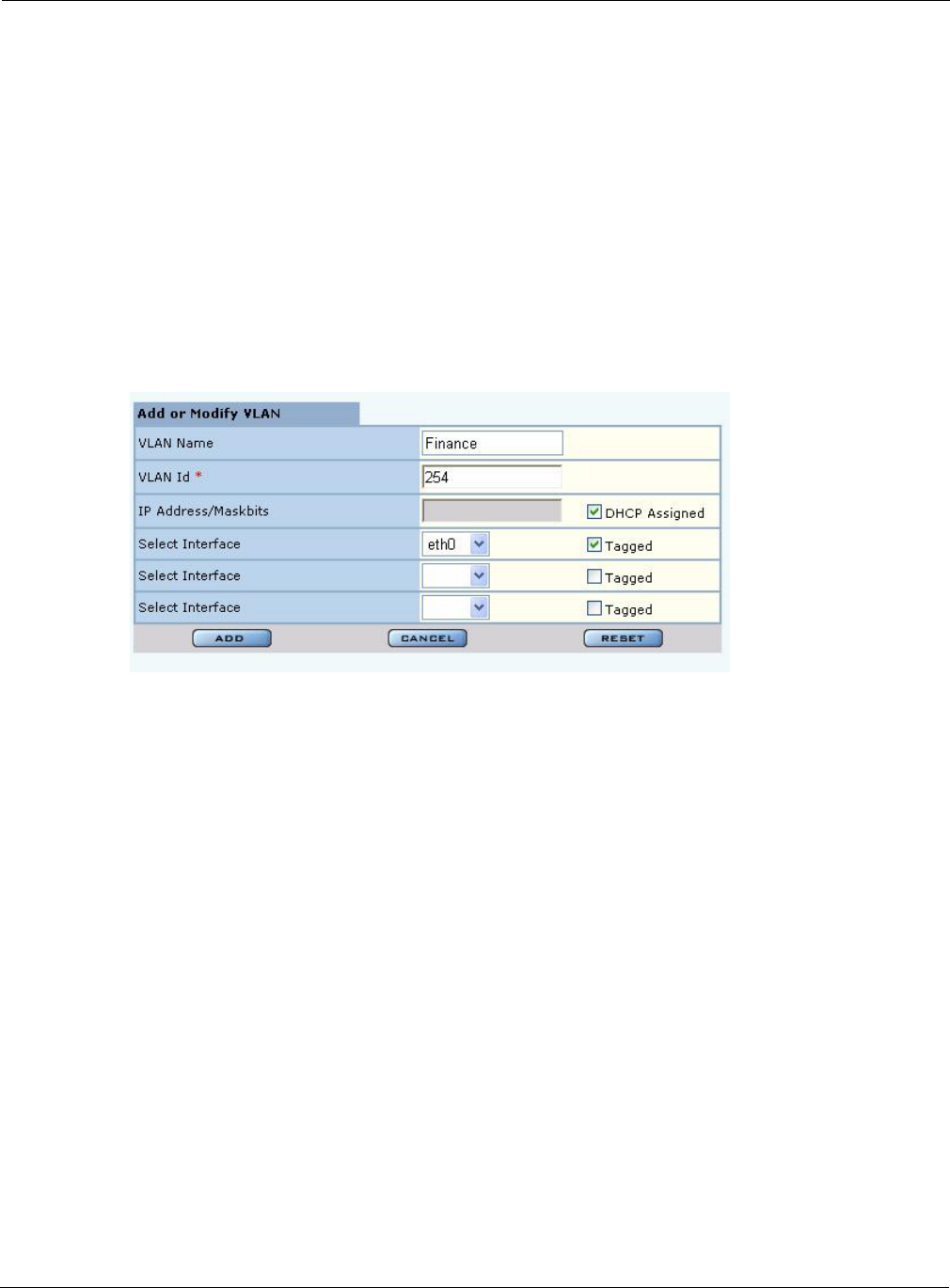
Configuring VLANs
Installation and User Guide: Airgo Access Point 113
Use the buttons on the Summary tab to add a new VLAN, configure an existing VLAN, delete an
interface from a VLAN, delete IP addresses from a VLAN, or set an interface as part of the
management VLAN. The default VLAN cannot be modified.
To add a new VLAN, click Add to open the Add VLAN Entry panel (Figure 77).
Figure 77: VLAN Configuration - Add VLAN Entry Panel
Enter the following information to define the new VLAN:
Click Add to create the new VLAN and return to the VLAN table.
Tagged Indication of whether the identity of the VLAN is explicitly encoded in
transmitted packets. Each frame contains a 4-byte tag that encodes the VLAN
to which the packet belongs when it is sent on a tagged interface. If the
received packet is untagged, the packet is classified as belonging to the
interface VLAN. If the VLAN interface is not tagged, then the AP drops any
VLAN-tagged packet. When the packet is transmitted from the interface, it is
untagged.
Field Description
VLAN Name Enter an alphanumeric name for the VLAN. The maximum length of VLAN
name is 80 characters. (optional)
VLAN ID Enter a numeric identifier for the VLAN. This number is used for table
references and as part of the bridging ID. The range is 2 - 4093. VLAN IDs 1
and 4094 are reserved.) (required)
IP Address/Maskbits Enter the IP address and maskbits used to access the VLAN for management
purposes. If the address is to be assigned by a DHCP server, select DHCP
Assigned.
If the VLAN is to be used for guest access, you must assign an IP address. See
“Configuring Guest Access with VLANs” on page 173.
Select Interface Select interfaces for the VLAN. If an interface is assigned to the VLAN, then
packets transmitted over that interface are included in that VLAN.
Tagged Select Tagged for an interface to mark packets sent out over the interface as
belonging to the VLAN.
Field Description
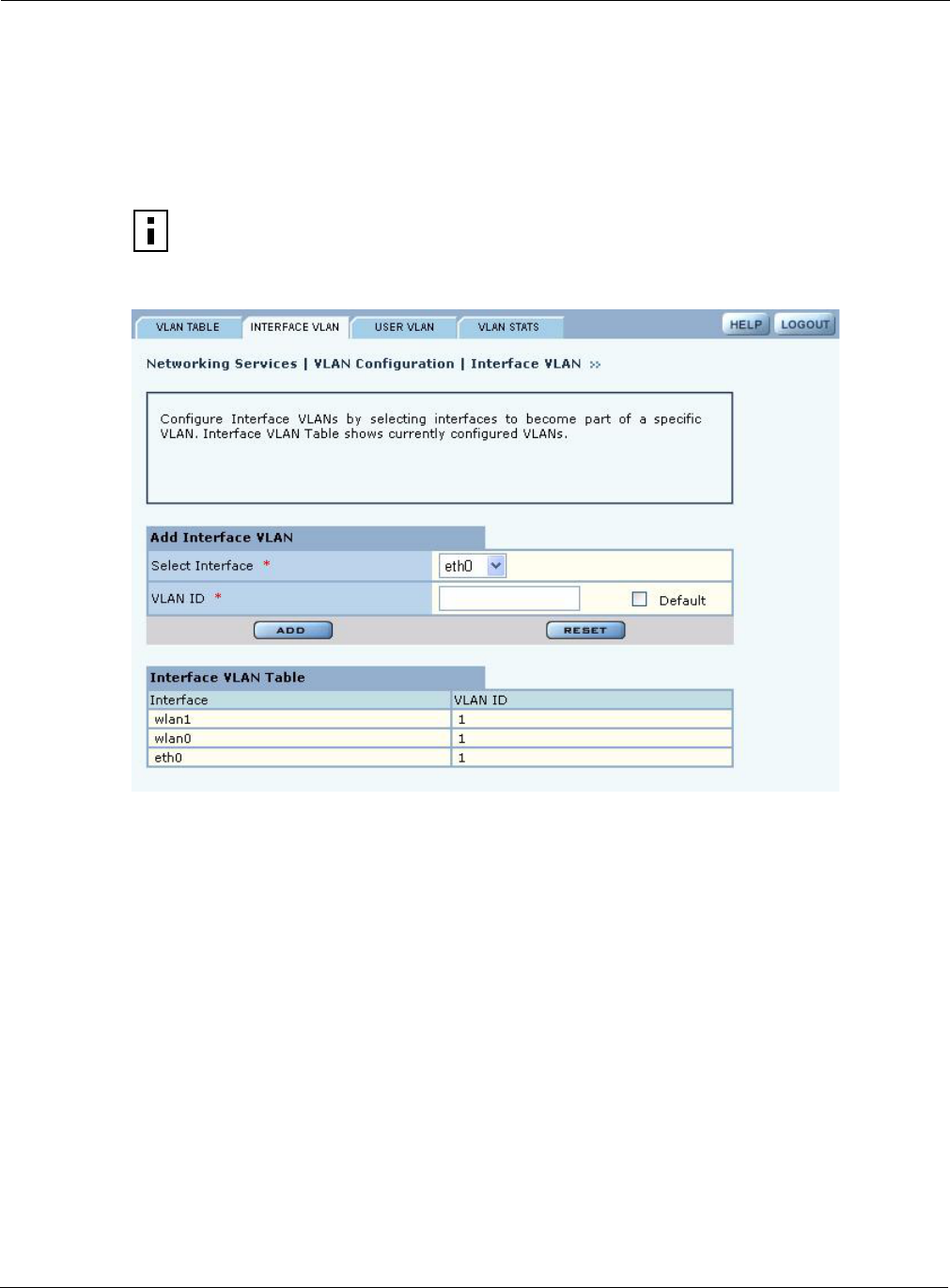
5 Configuring Networking Settings
114 Installation and User Guide: Airgo Access Point
Interface VLAN
When the AP receives a frame, it must determine the VLAN to which the frame belongs. If the
received frame is tagged, then VLAN is already known and the AP can route the packet
accordingly. The Interface VLAN tab (Figure 78) specifies treatment of frames that arrive at the AP
in an untagged state. Each interface is assigned to a VLAN, which then receives all untagged
frames arriving at the interface.
Figure 78: VLAN Configuration - Interface VLAN
Make sure that the VLAN is defined before assigning an interface, and then configure the following
fields:
Click Add to assign the interface to the specified VLAN.
User VLAN
The read-only User VLAN tab (Figure 79) lists the client stations mapped to each VLAN by way of
bound service profiles. The tab contains the following information:
NOTE: Do not add the wlan0 or wlan1 radio interfaces to the management
VLAN.
Field Description
Select Interface Select the AP interface. (required)
VLAN ID Enter the VLAN ID. (required)
Default Select to assign this as the default VLAN for untagged frames.
Field Description
VLAN ID VLAN identifier
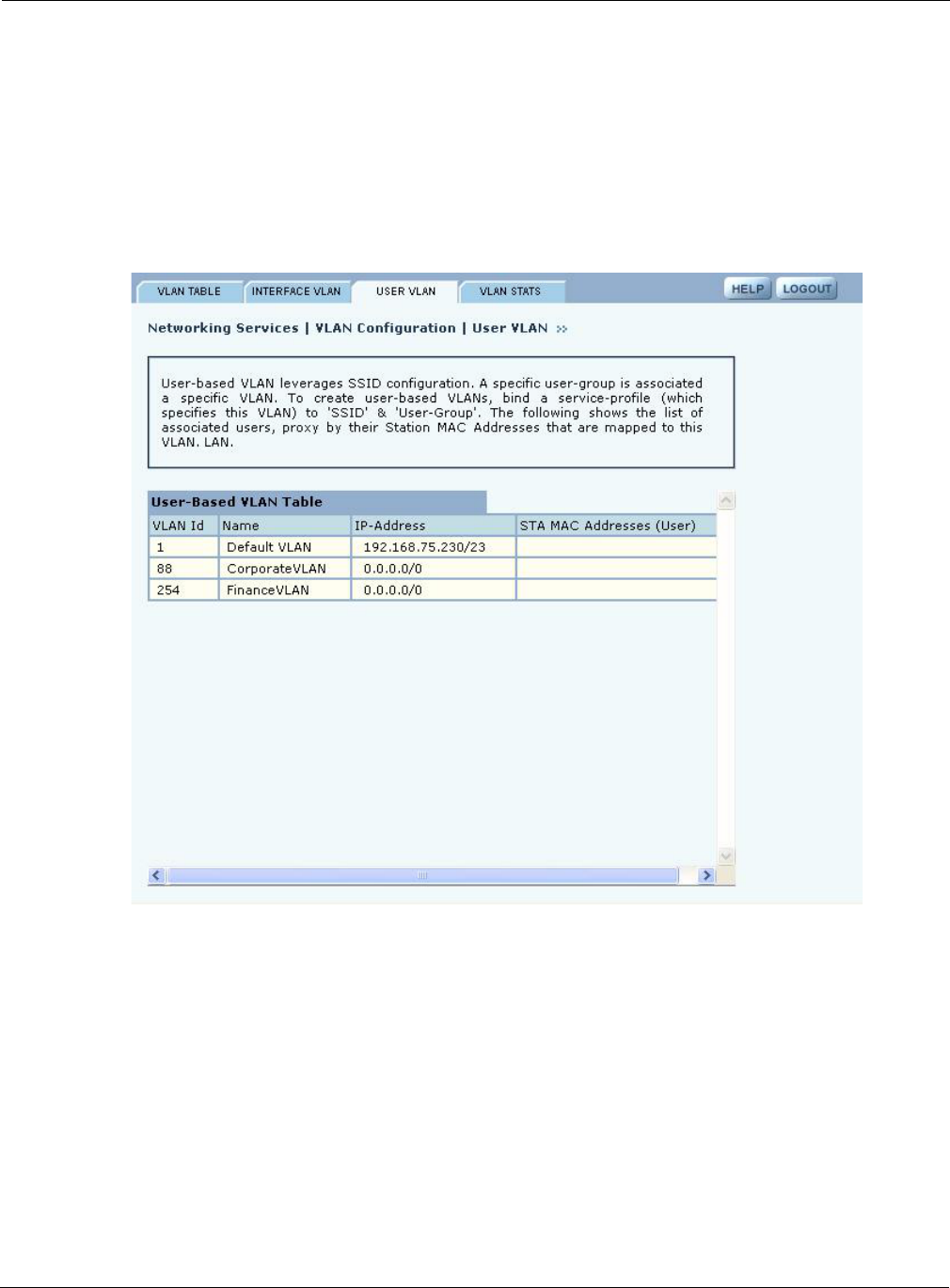
Configuring VLANs
Installation and User Guide: Airgo Access Point 115
See “Configuring SSID Parameters” on page 83 for information on service profiles.
Figure 79: VLAN - User VLAN
VLAN Name Alphanumeric name of the VLAN
IP Address Address used to access the VLAN
MAC Address MAC addresses of the client stations mapped to this VLAN through their user
group’s service profile
Field Description
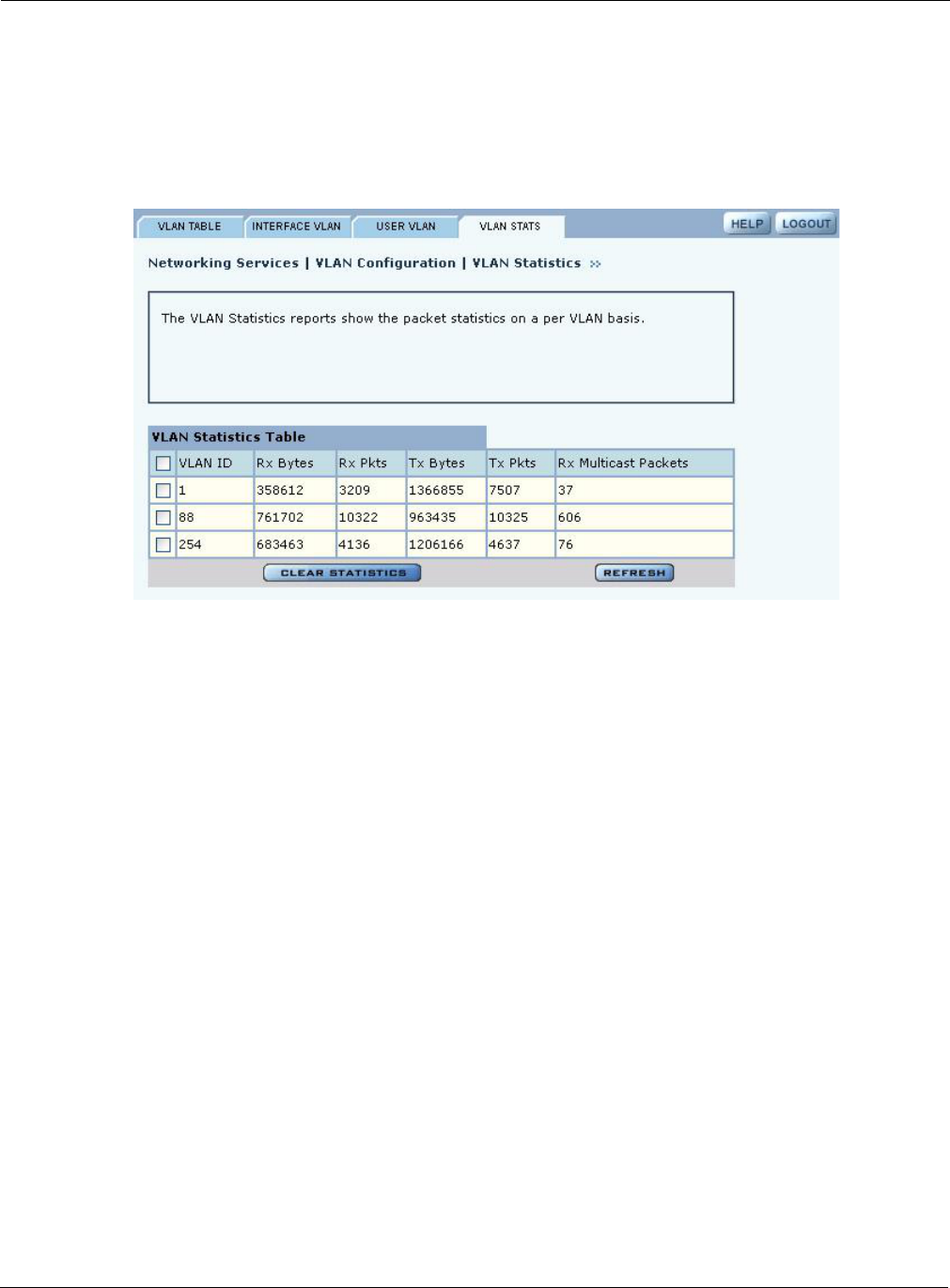
5 Configuring Networking Settings
116 Installation and User Guide: Airgo Access Point
VLAN Statistics
The VLAN Stats tab (Figure 80) provides a summary of transmit/receive statistics for each VLAN.
The statistics are calculated from the last time that the AP was rebooted or the Clear Statistics
button was selected. Click Refresh to update the statistics or Clear Statistics to return the collected
values to zero and start collecting statistics again.
Figure 80: VLAN - Stats
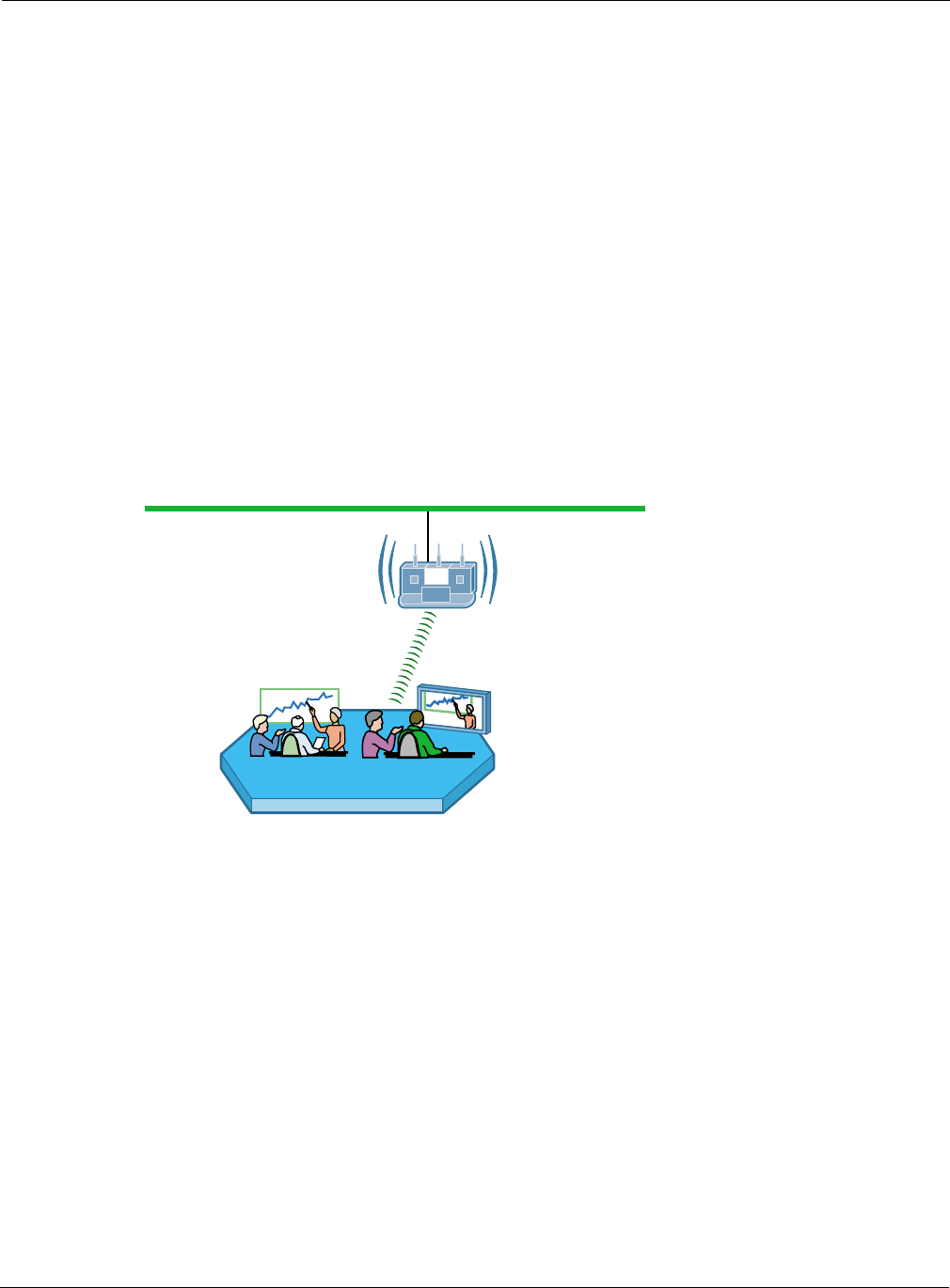
Configuring Quality of Service
Installation and User Guide: Airgo Access Point 117
Configuring Quality of Service
Under normal network conditions, traffic in the wireless network is routed on a best-effort basis,
and all types of traffic are treated with equal priority. Quality of Service (QoS) permits priority
setting for different types of traffic, which can be important for applications in which even minor
interruptions in packet transmission can have a deleterious effect on perceived results. Examples
include streaming media or Voice-over-IP (VoIP). With a QoS process in place, multiple clients
can run applications with varying traffic delivery requirements over a single shared network.
QoS is supported through hierarchical classes of service (COS) that control how network
bandwidth is shared among multiple entities. COS specifies a numeric class code with values
ranging from 0 (lowest priority) to 7 (highest priority). This method does not guarantee bandwidth
for different traffic types, but does assure that high COS traffic will be given preference.
For example, when Acme Works wanted to set up a video conference center, it was important to
provide a higher quality of service for the video conference application. The company accordingly
set up a structure of multiple SSIDs in which a higher COS value was assigned to the service
profile for the Video SSID (Figure 81).
Figure 81: Example Applications with Different COS Levels
The Airgo AP supports several options for assigning COS to the packets passing into the AP (the
ingress to the AP).
Rule Description
TCID-to-COS mapping Defines a COS mapping based on the traffic class identifier (TCID), which is
part of the standard 802.11 frame header. Incoming packets with a TCID
value assigned can be mapped to COS.
VLAN-to-COS Defines a COS mapping for packets not VLAN-tagged upon arrival at the AP.
Interface-to-COS Associates a COS value to each of the AP interfaces (eth0, wlan0, wlan1).
MAC Uses the COS value from the user group’s service profile (see “Configuring
SSID Parameters” on page 83).
IP Precedence Defines a mapping based on the first three bits in the Type of Service (ToS)
byte of the IP header. Incoming packets that have an IP Precedence value can
be mapped to COS.
A0043B
SSID="Corporate" SSID="Video"
10/100 Switched Ethernet
Corporate Video
COS=7COS=4

5 Configuring Networking Settings
118 Installation and User Guide: Airgo Access Point
Use the QoS Configuration panel to define TCID, VLAN, and Interface COS mappings. Use the
Advanced QoS Configuration panel (“Configuring Advanced QoS” on page 121) to define the IP
and DSCP mapping and to assign class order. The QoS Configuration panel is divided into the
following tabs:
•Ingress QoS — Define COS mappings packets entering the AP.
•Egress COS — Assign priority to the 802.11 packets leaving the AP.
•QoS Stats — Display QoS statistics for each of the AP interfaces.
DiffServ Code point
(DSCP)-to-COS
Defines a mapping based on the first 6 bits in the ToS byte of the IP header.
Incoming packets that have a DSCP value can be mapped to COS.
IP Protocol Assigns COS value based on the standard numbers for individual IP protocols.
Class Order Determines the order in which all the COS mapping rules are applied.
Rule (continued) Description
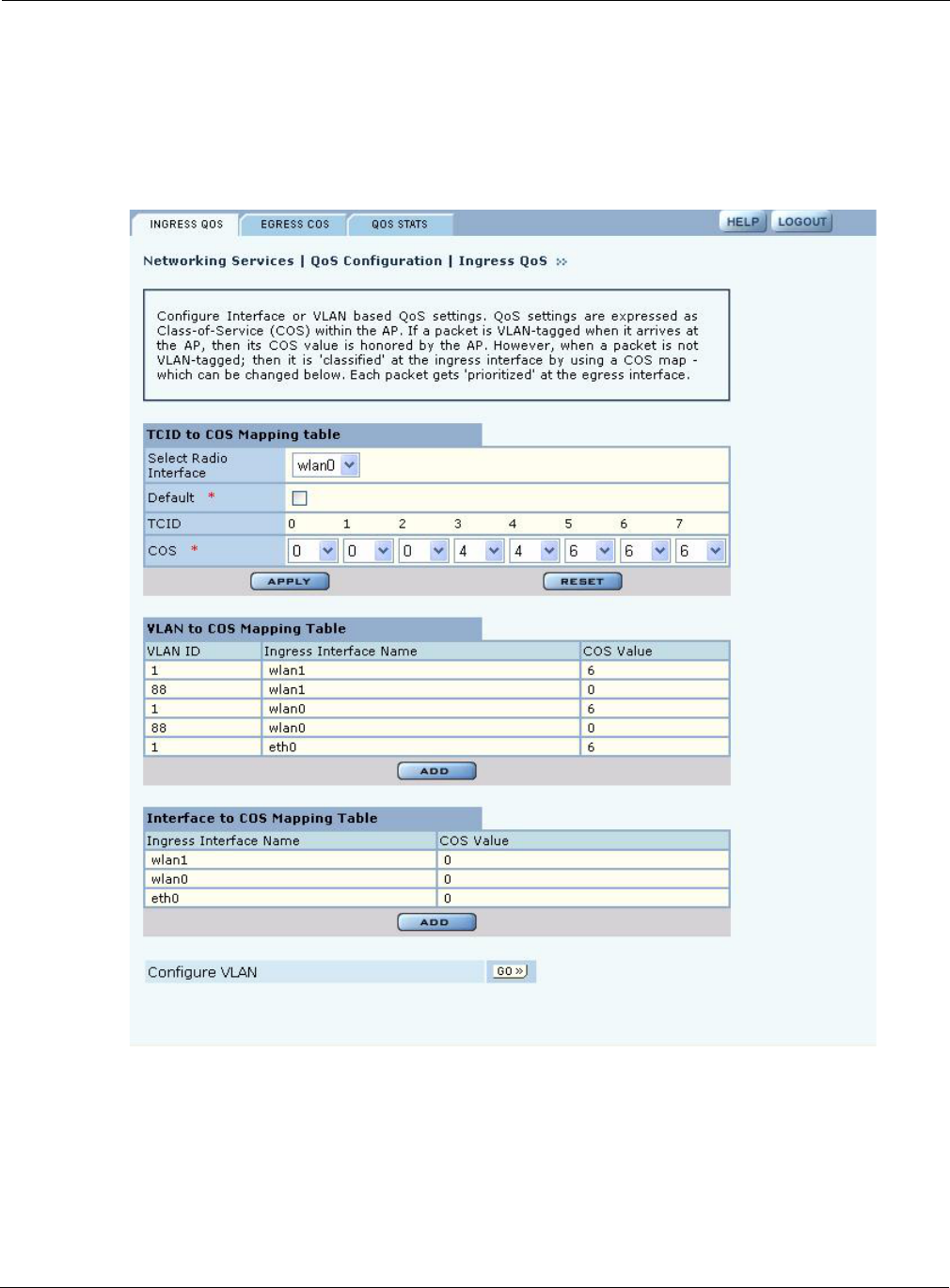
Configuring Quality of Service
Installation and User Guide: Airgo Access Point 119
Ingress QoS
Use the Ingress QoS tab to assign COS values to incoming 802.11 packets. If a packet has a COS
value in the VLAN tag when it arrives at the AP, its COS value is honored by the AP. If the packet
is not VLAN-tagged, it can be classified at the ingress interface by way of a COS map defined on
the Ingress QoS tab (Figure 82).
Figure 82: QoS Configuration - Ingress QoS
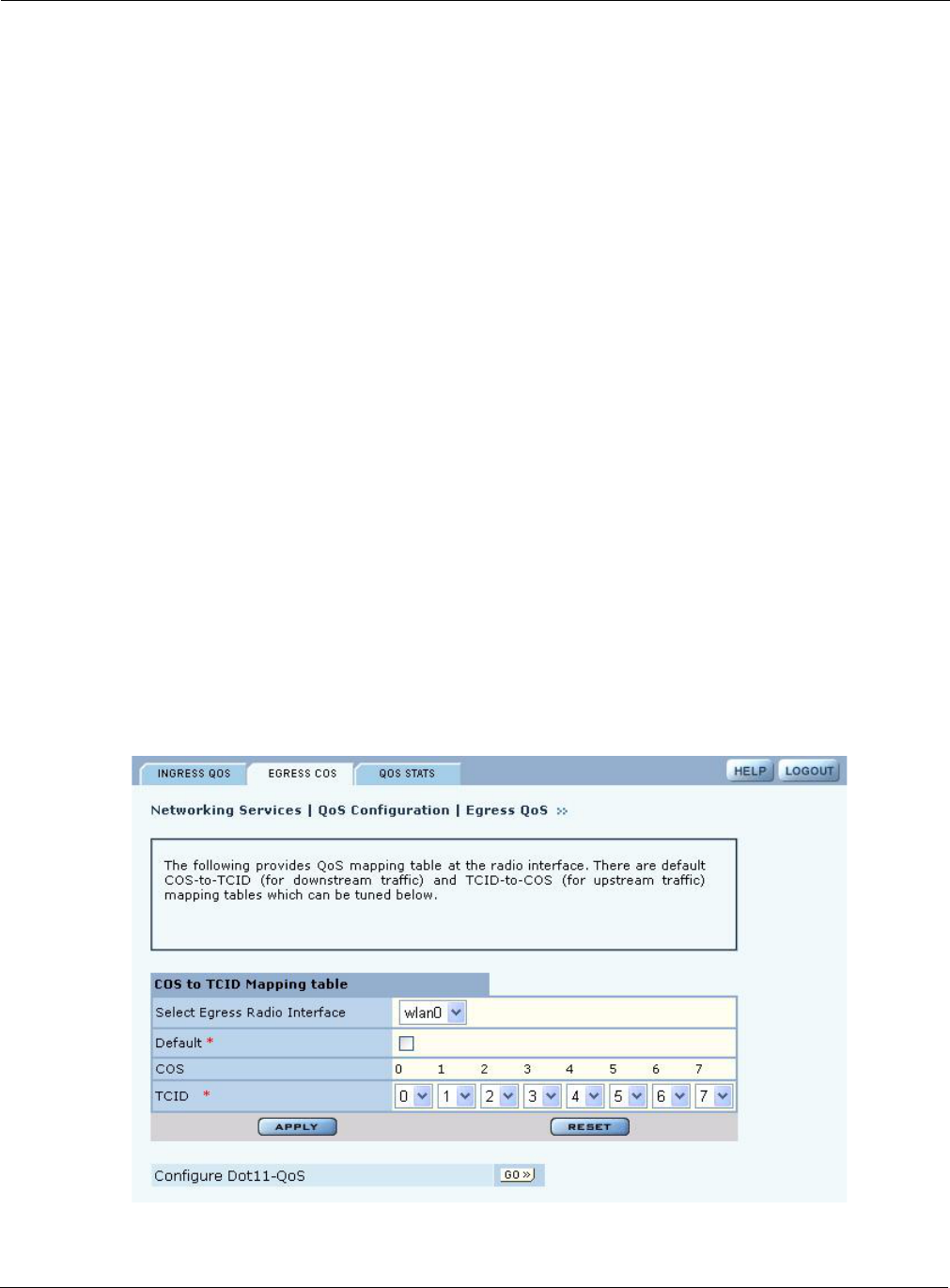
5 Configuring Networking Settings
120 Installation and User Guide: Airgo Access Point
Perform the following functions on this tab:
Egress COS
Use the Egress COS tab (Figure 85) to modify the default priorities assigned to 802.11 packets
leaving the AP by creating a COS-to-TCID mapping.
If a TCID-to-COS mapping is defined, the TCID value is obtained from the mapping table of the
interface based on the COS field of the frame. By default, COS-to-TCID mapping is one-to-one,
i.e. COS 0 maps TCID 0, 1 maps to 1 … and 7 maps to 7. If your network supports fewer than 8
priority levels, you can map multiple COS levels to a single TCID value.
Figure 83: QoS Configuration - Egress COS
Function Steps
Define TCI- to-COS
mapping
1Select the radio interface for the mapping.
2Select a COS value for each TCID value, or select Default to accept the
default mapping.
3Click Apply.
Define VLAN-to-COS
mapping
1Click Add.
2Select the AP interface.
3Select the VLAN ID. (See “Configuring VLANs” on page 111 for
information on VLAN IDs.)
4Select a COS value or select Default to use the default mapping.
5Click Apply.
Interface-to-COS
mapping
1Click Add.
2Select the AP interface.
3Select a COS value or select Default to use the default mapping.
4Click Apply.
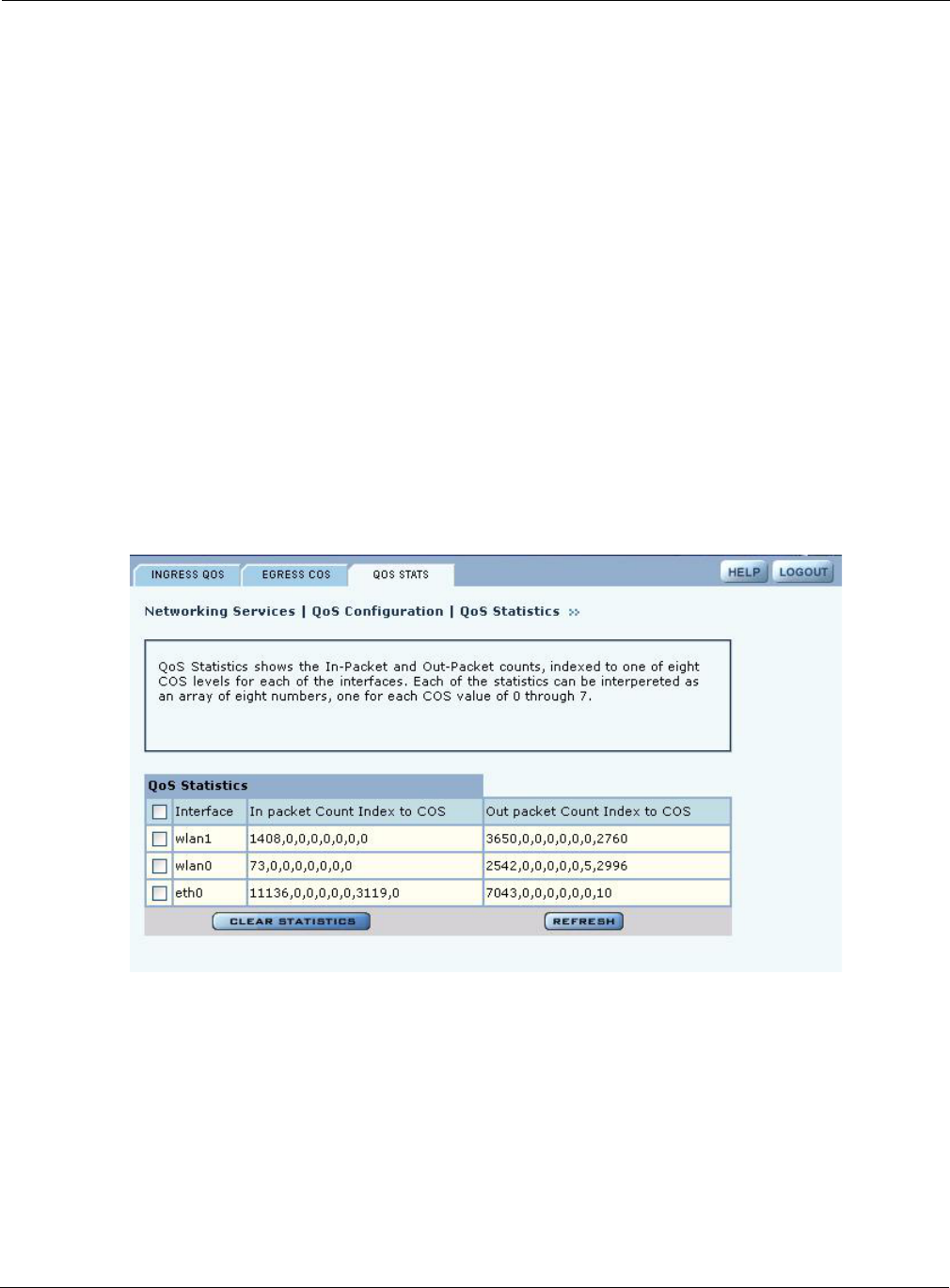
Configuring Advanced QoS
Installation and User Guide: Airgo Access Point 121
Configure the following fields on this tab:
Click Apply to save your changes or Reset to return to previously saved values.
QoS Stats
The QoS Stats tab (Figure 85) presents incoming packet and outgoing packet counts for each of the
AP interfaces. The counts are indexed to one of the eight available COS levels. Every statistic is a
comma-separated set of numbers, each of which corresponds to one of the COS levels 0-7. For
example, the out-of-packet count for wlan0 in the figure shows 77614 packets at COS level 0 and
36127 packets at COS level 7.
Click Clear Statistics to return the values to zero and restart the collection process.
Figure 84: QoS Configuration - QoS Stats
Configuring Advanced QoS
Use the Advanced QoS panel to assign COS values to packets entering the AP based on IP layer
information and choose the QoS class order. The panel contains the following tabs:
•Class Order—Determine the order in which to apply all the QoS rules.
•IP DSCP—Define COS mapping based on the first 6 bits in the ToS byte of the IP header.
•IP Protocol—Use standard IP protocol numbers assigned to different IP layer protocols.
•IP Precedence—Define COS mapping based on the first 3 bits in the ToS byte of the IP header.
Field Description
Select Egress Radio
Interface
Select the AP interface.
Default Select to use the default mapping.
COS Displays the COS levels.
TCID If Default is not selected, map each COS level to a TCID level.
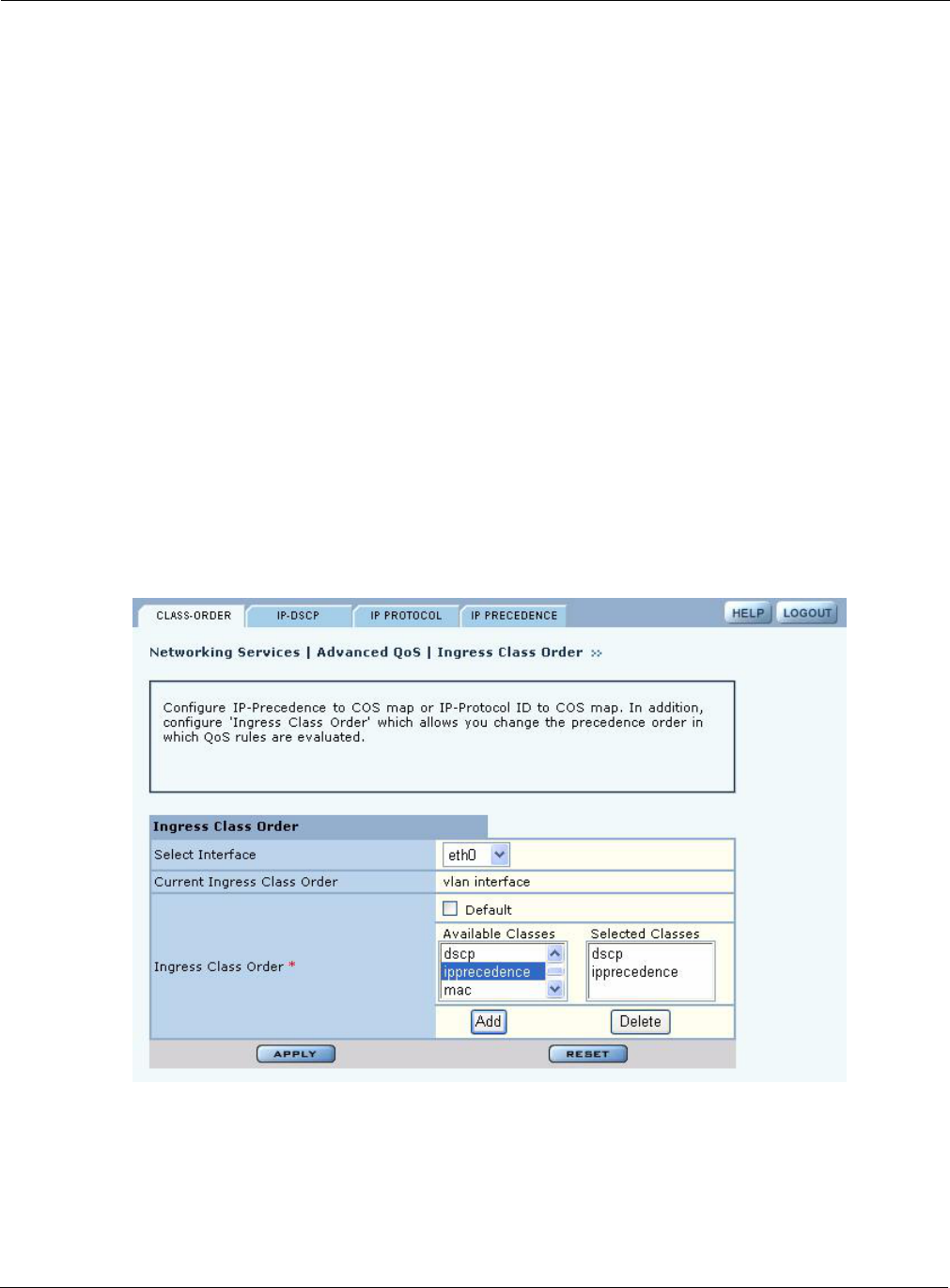
5 Configuring Networking Settings
122 Installation and User Guide: Airgo Access Point
Class Order
The COS mappings on the QoS and Advanced QoS Configuration panels may yield conflicting
results for ingress packet priority. Use the Class Order tab (Figure 85) to specify the order in which
to apply each of the rules. When a packet arrives at the AP, the AP checks to see whether a
mapping exists for the first rule in the class order list. If so, that mapping is applied to the packet. If
not, the AP checks whether a mapping exists for the second rule. If so, that mapping is applied. If
not, the AP continues down the class order list.
The default class order for non-VLAN tagged frames on the Ethernet interface (eth0) is:
•DSCP
•VLAN
•Interface
The default class order for the wlan0 and wlan1 interfaces is:
•TCID
•DSCP
•MAC
•VLAN
•Interface
You can also select IP Protocol and IP Precedence to include in the class order.
Figure 85: Advanced QoS Configuration - Class Order
Configure the following fields on the Class Order tab:
Field Description
Select Radio Interface Select the AP interface.

Configuring Advanced QoS
Installation and User Guide: Airgo Access Point 123
Click Apply to save all the changes on the tab.
IP DSCP
Use the IP DSCP tab (Figure 86) to map DiffServ Code point (DSCP) values to COS and to view the
current DSCP-to-COS maps. DSCP uses the first 6 bits in the ToS byte of the IP header, so the possible
values range from 0 to 63.
Current Ingress Class
Order
Displays the current setting for class order.
Ingress Class Order -
Default
Select to use the default mapping.
Ingress Class Order -
Move to Top
If the default order is not chosen, select the class that you want to have at the
top of thc class order list, and click Add. This adds the class to the Selected
Classes list. Continue adding classes in the order you want them to be applied.
When you have finished, click Apply. The class order is saved and listed in
the Current Ingress Class Order field.
Field Description
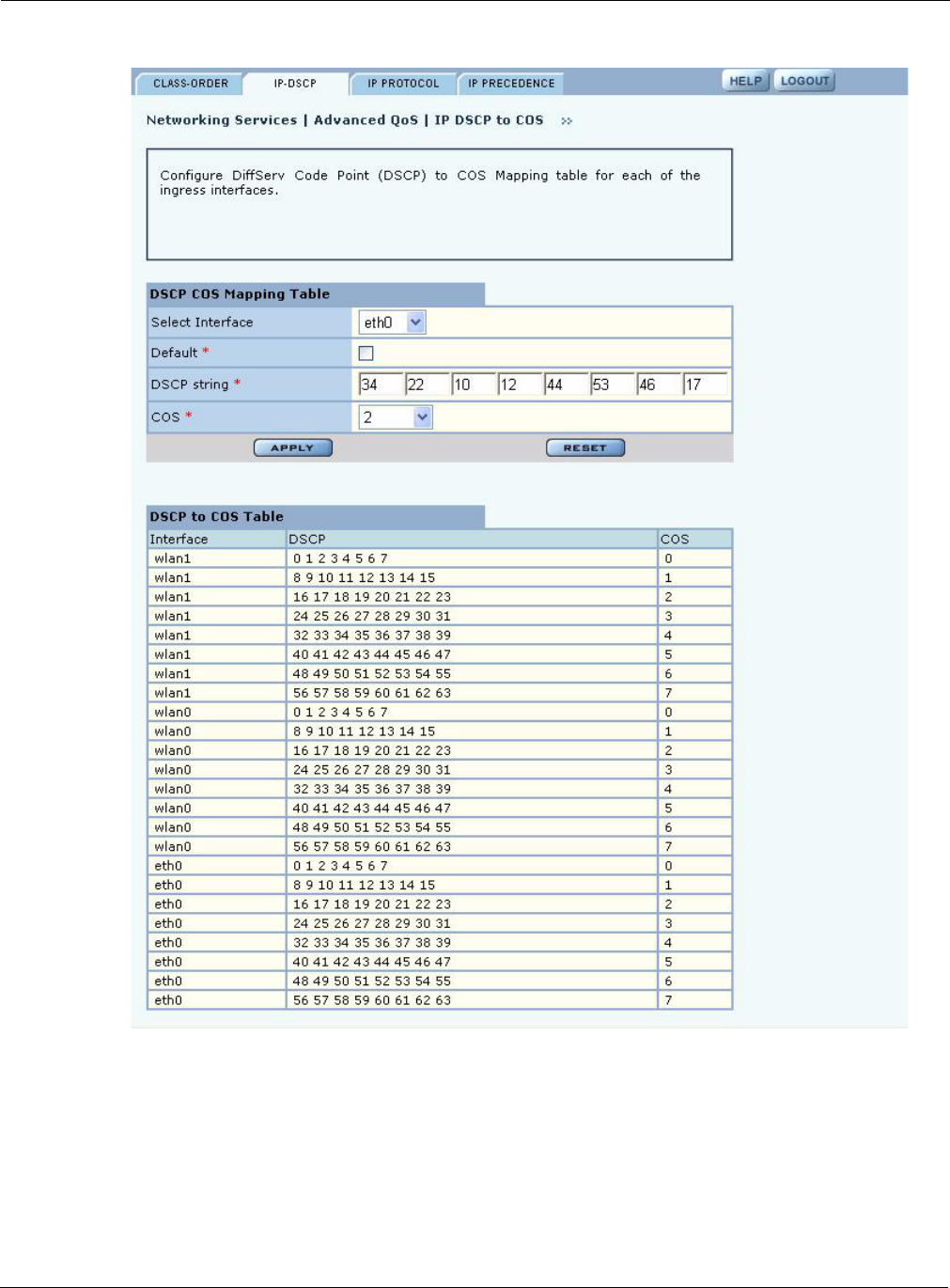
5 Configuring Networking Settings
124 Installation and User Guide: Airgo Access Point
Figure 86: Advanced QoS Configuration - IP DSCP
Configure the following fields on this tab:
Field Description
Select Interface Select the AP interface.
Default Select to use the default mapping.
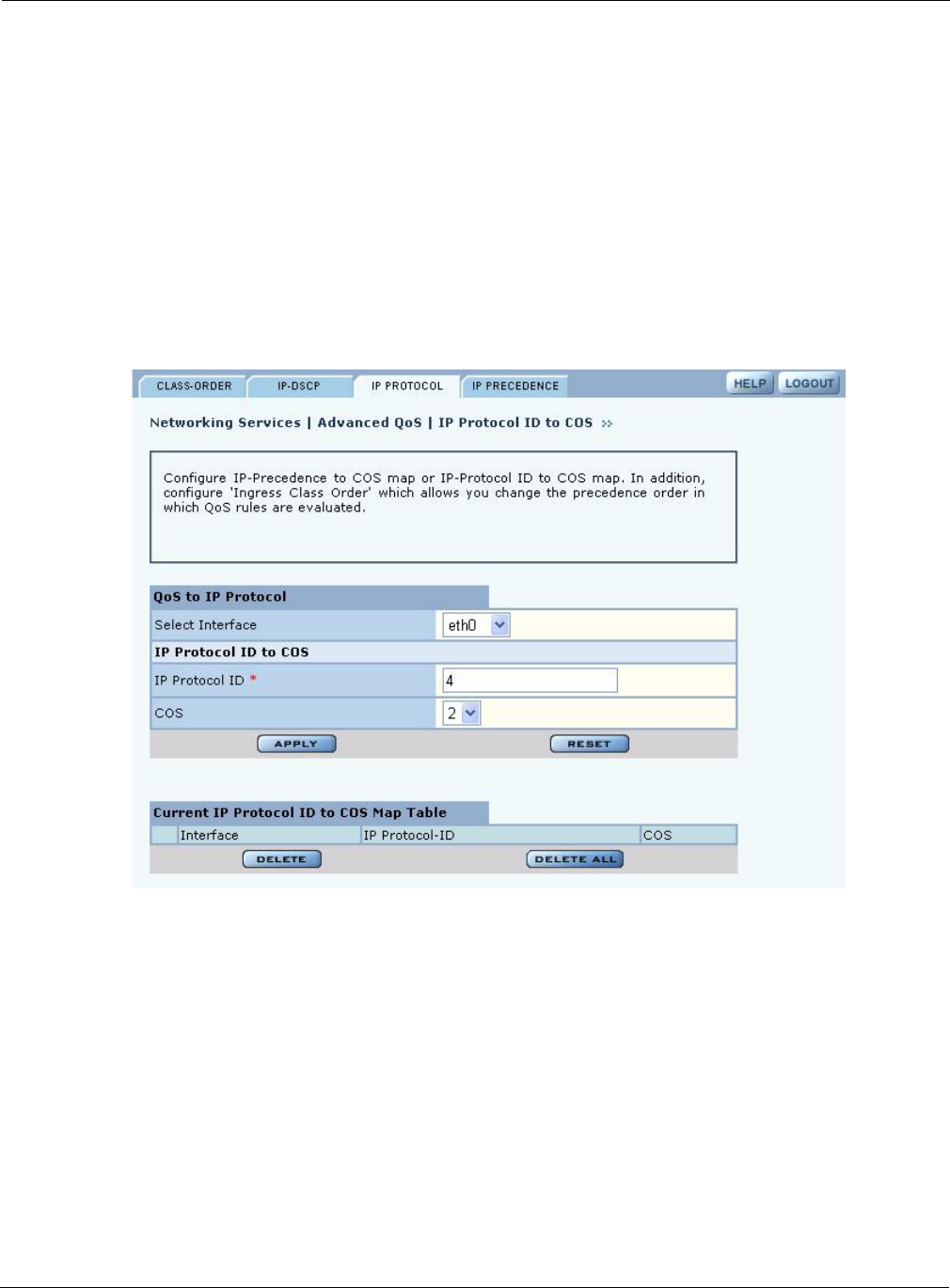
Configuring Advanced QoS
Installation and User Guide: Airgo Access Point 125
Click Apply to save all the changes on the tab.
IP Protocol
Use the IP Protocol tab (Figure 87) to base the COS mapping on IP protocol numbers, as defined in
Version 4 of the IP protocol. Current protocol number assignments are available at http://
www.iana.org/numbers.html.
Figure 87: Advanced QoS Configuration - IP Protocol
Configure the following fields:
Click Apply to save all the changes on the tab.
DSCP String If Default is not chosen, enter up to eight DSCP values that you want to map
to a specific COS value.
COS Select the COS value.
Field Description
Select Interface Select the AP interface.
IP Protocol ID Enter the number assigned to the IP protocol.
COS Select the COS value.
Field Description
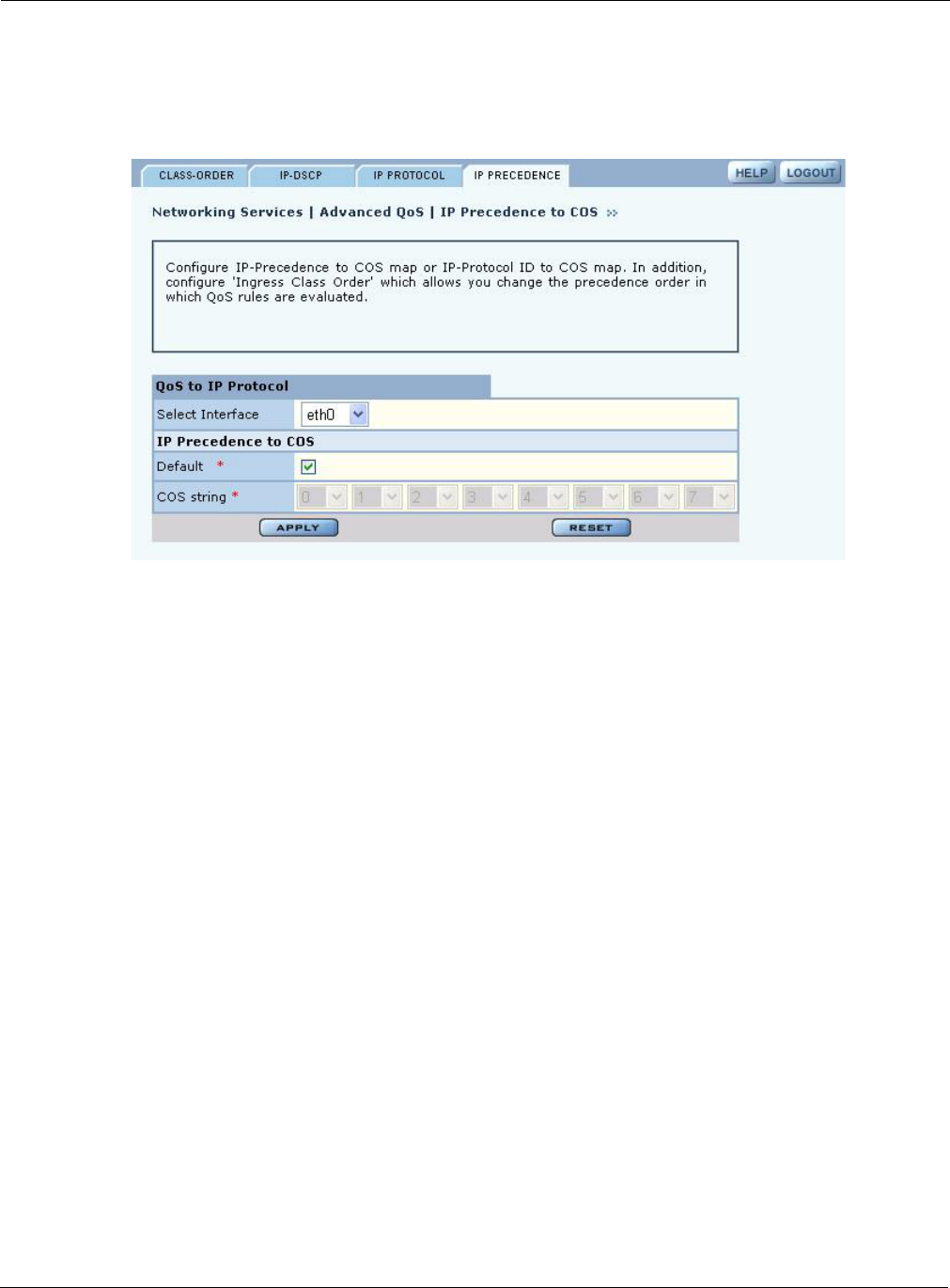
5 Configuring Networking Settings
126 Installation and User Guide: Airgo Access Point
IP Precedence
Use the IP Precedence tab (Figure 88) to base the COS mapping on the first 3 bits in the ToS byte
of the IP header.
Figure 88: Advanced QoS Configuration - IP Precedence
Configure the following fields to define an IP Precedence-to-COS map:
Click Apply to save all the changes on the tab.
Configuring Packet Filters
Use the Filter Configuration panel, accessible from the Networking Services menu, to define packet
filtering rules for the specific AP interfaces. Filters can help improve performance by reducing load
on the wireless side of the network.
The panel contains the following tabs:
•Filter Table — View currently defined packet filters, and add or edit filters.
•Filter Stats — View counts of packets that match the filter criteria.
Filter Table
Choose Filter Configuration from the Networking Services menu to open the Filter Table tab
(Figure 89). By default, an incoming and outgoing filter is defined for each of the interfaces wlan0,
wlan1, and eth0. The Filter table displays the name of the interface, whether it is for incoming or
outgoing traffic, whether to accept or discard the packet, and the criteria used to accept or discard it.
Field Description
Select Radio Interface Select the AP interface.
Default Select to apply the default mapping
COS If Default is not chosen, select the desired COS values.
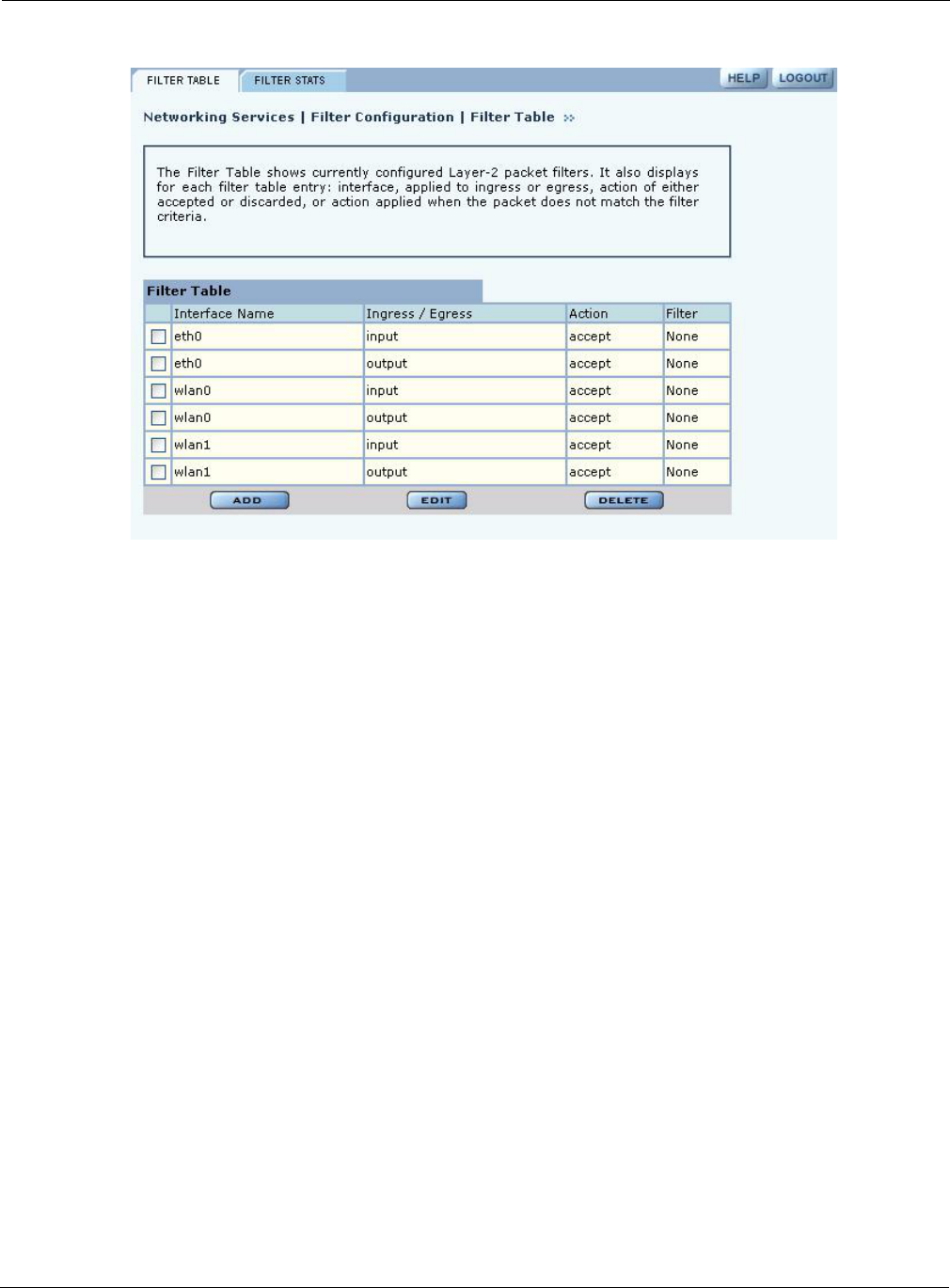
Configuring Packet Filters
Installation and User Guide: Airgo Access Point 127
Figure 89: Filter Configuration - Filter Table
From the Filter Table tab, add a new filter by clicking Add, or edit an existing one by selecting the
filter and clicking Edit. The Add Filter Entry panel opens (Figure 90). Enter or select values for the
following fields:
Click Apply to save the values and return to the Summary tab. Click Cancel to return to the
Summary tab without saving the values.
Field Description
Interface Name If creating a new filter, select an interface from the pull-down list.
Filter Direction Specify whether the filter is for incoming (ingress) or outgoing (egress)
communications. It is necessary to create a separate filter for each.
Accept/Discard Indicate whether the filtering rule is to accept or discard the packet.
Select Match Indicate if the filter rule is satisfied when a packet contains an Ether Type
value that matches the specified Ether Type, or if the filter rule is satisfied
when a packet contains an Ether Type that does not match any other filter rule.
Ether Type is the standard Ethernet code for the type of packet (e.g., for IP,
the code is 2048, or 0x800 hex).
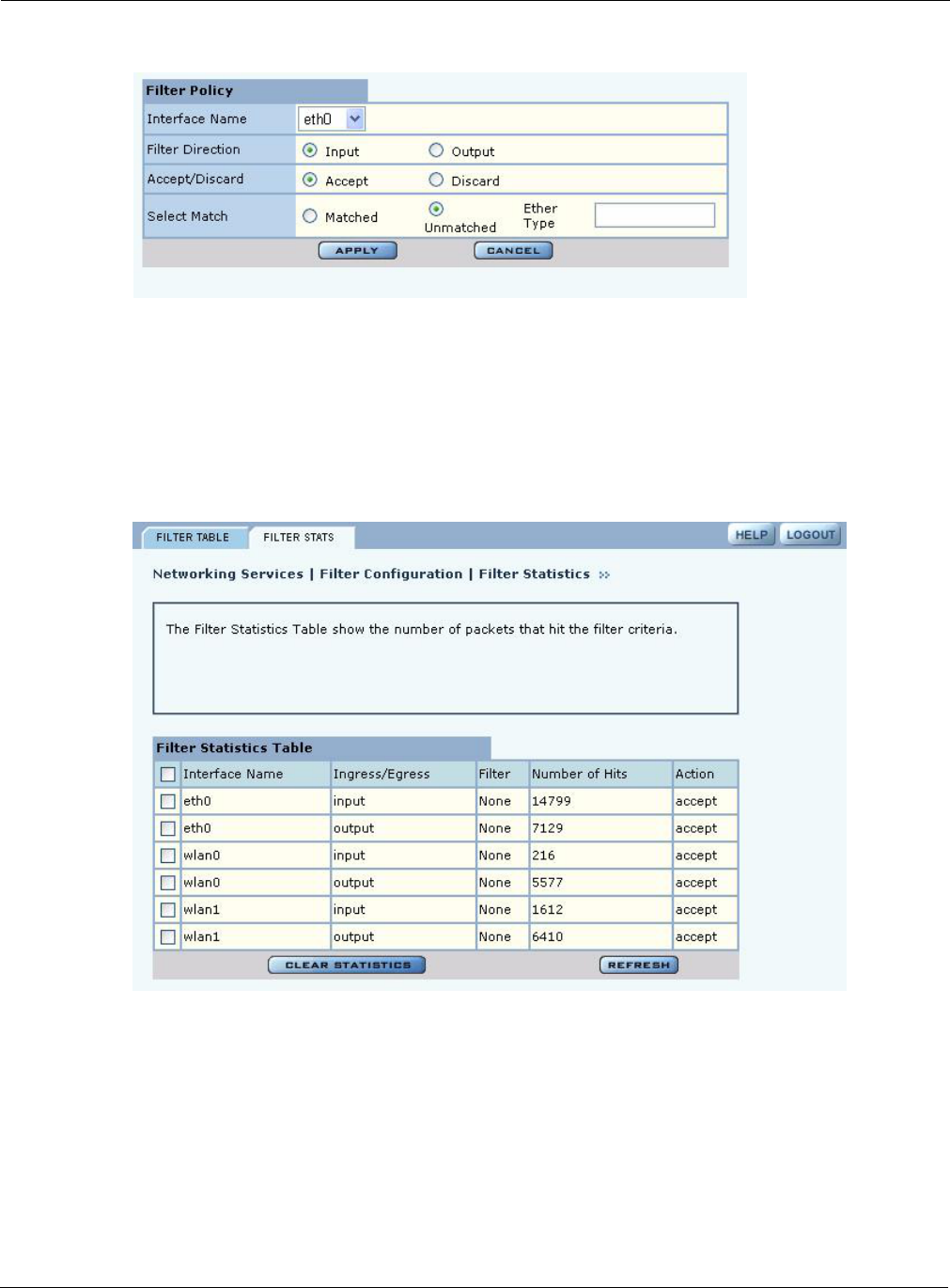
5 Configuring Networking Settings
128 Installation and User Guide: Airgo Access Point
Figure 90: Filter Configuration - Add Filter Entry Panel
Filter Statistics
The Filter Stats tab (Figure 91) lists statistics for each defined filter. The statistics are calculated
from the last time the AP was rebooted or the Clear Statistics button was selected. The Hits column
shows the number of packets of the specified type received on the interface with the defined filter.
Click Refresh to update the statistics or Clear Statistics to return the collected values to zero and
start collecting statistics again.
Figure 91: Filter Configuration - Stats Tab
Configuring Interfaces
Use the Interface Configuration panel, accessible from the Networking Services menu, to configure
the physical AP interfaces (wlan0, wlan1, eth0). The panel contains the following tabs:
•IF Table — View the administrative and operation state of each of the interfaces, and bind an
IP address to each interface.
•IF Stats — View the packet and byte statistics for traffic traversing each interface.
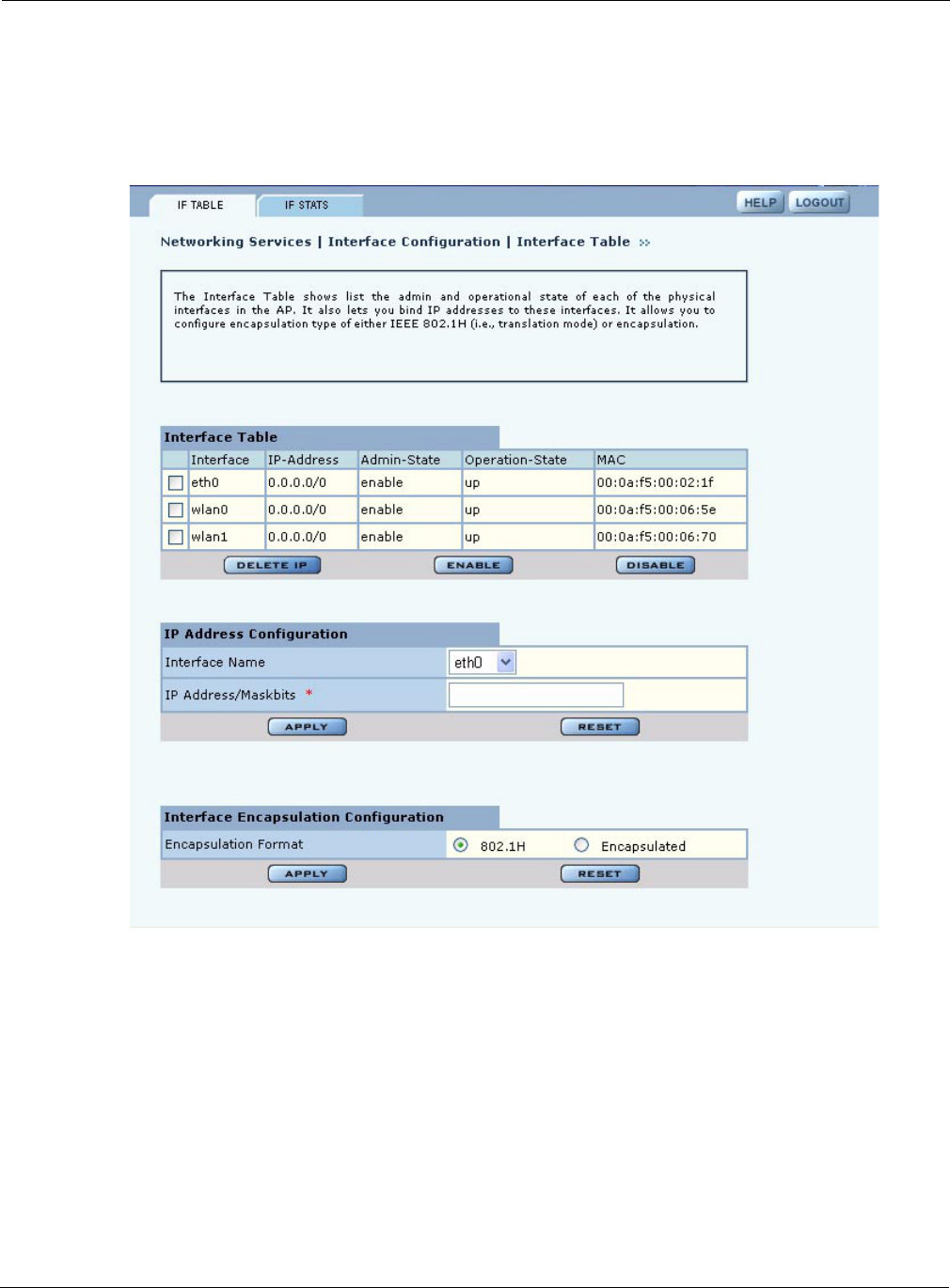
Configuring Interfaces
Installation and User Guide: Airgo Access Point 129
Interface Table
Choose Interface from the Networking Services menu to open the Interface Table (Figure 92). Use
this tab to assign an IP address to each interface, thereby making it possible to route traffic to the
interface. Without an assigned IP address, traffic can only be bridged to the interface, not routed.
Figure 92: Interface Configuration - IF Table
The Interface table lists each interface along with its IP address, Enable or Disable flag, and
indication of whether the interface is currently operational. Modify the properties of the IP address
assigned to an interface by selecting the interface entry and clicking Enable, Disable, or Delete IP.
To assign an IP address to an interface, enter the following values under IP Address Configuration,
and click Apply:
Field Description
Interface Name Select the AP interface name from the pull-down list.
IP Address Enter the IP address to assign to the interface. (required)
Maskbits Enter the subnet prefix length for the IP address. (required)
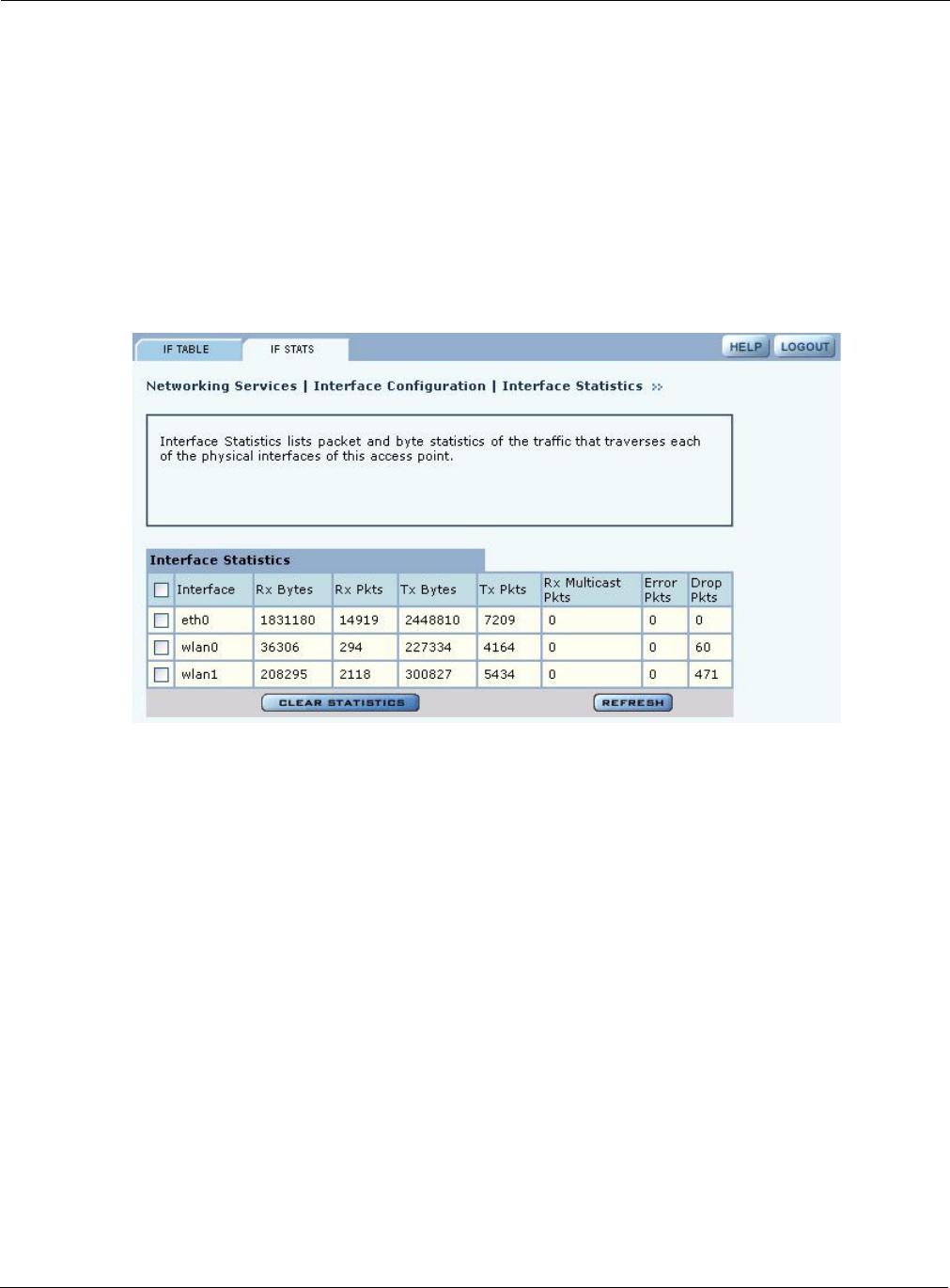
5 Configuring Networking Settings
130 Installation and User Guide: Airgo Access Point
Use the Encapsulation Configuration section at the bottom of the tab to ensure that the AP can
operate with older equipment that is not fully 802.11-compatible. 802.1h is the current standard for
encapsulation. For other, incompatible equipment, select Encapsulated to encase the Ethernet
frames from the equipment within standard 802.11 frames. Click Apply after making any change.
Interface Statistics
The Interface Statistics tab (Figure 93) shows packet and byte statistics for each of the AP
interfaces. The statistics are calculated from the last time that the AP was rebooted or the Clear
Statistics button was selected. Click Refresh to update the statistics or Clear Statistics to return the
collected values to zero and start collecting statistics again.
Figure 93: Interface - Stats Tab
Configuring SNMP
Simple Network Management Protocol (SNMP) is an industry standard protocol used to manage
interactions with the Airgo APs. The protocol works through message passing between SNMP
managers and agents, which are devices that comply with the SNMP protocol. The information of
interest to the SNMP manager is stored in the agents’ management information bases (MIBs) and
sent to the SNMP manager upon request.
SNMP communities restrict access to the MIBs to authorized agents. Each community can be
earmarked with read or read/write status, indicating the type of authorized MIBs access. An SNMP
trap filters the SNMP messages and saves or drops them, depending upon how the system is
configured.
Choose SNMP Configuration from the Networking Services menu to open the SNMP panel
(Figure 94) to configure SNMP parameters.
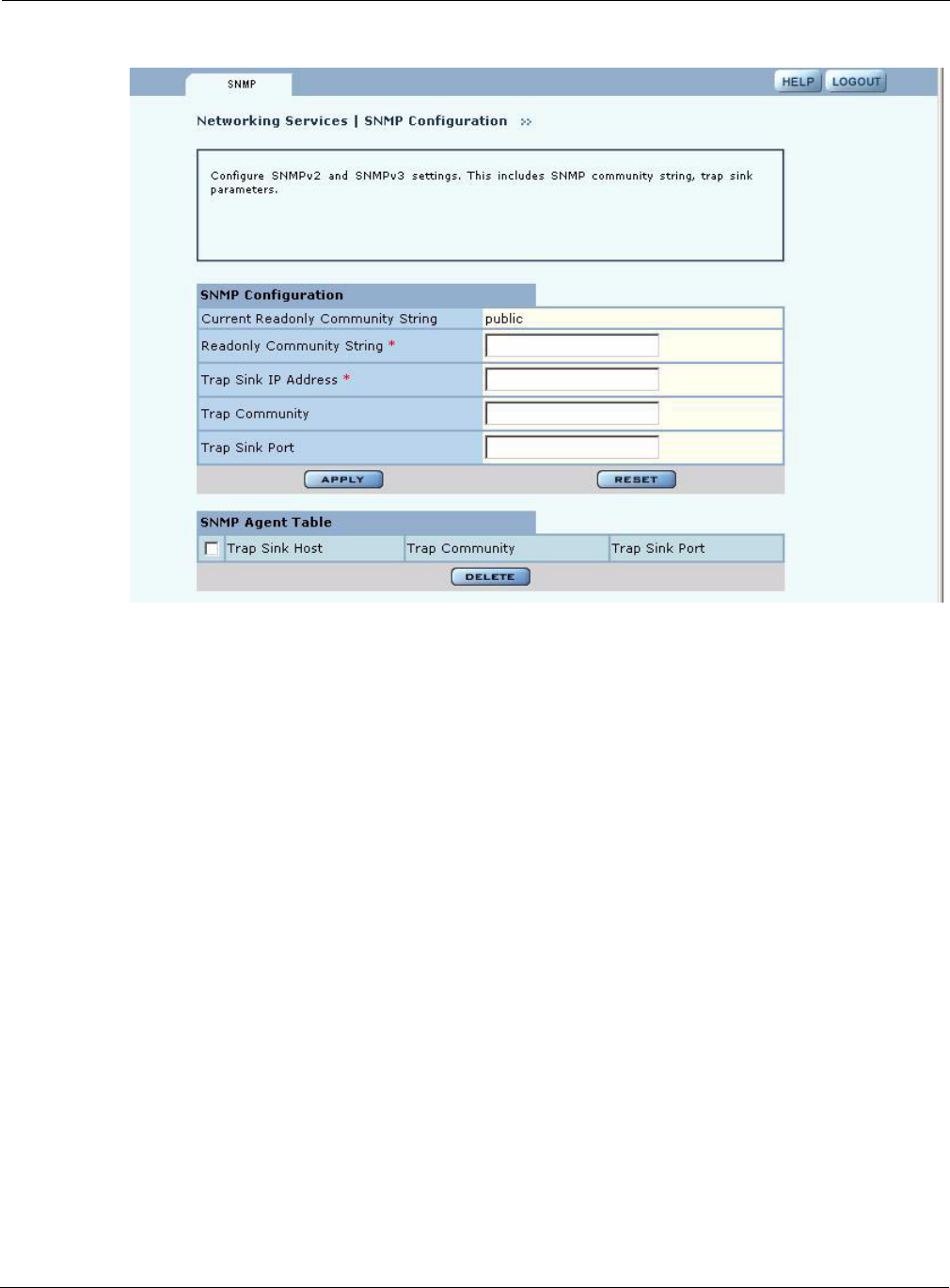
Ping Test
Installation and User Guide: Airgo Access Point 131
Figure 94: SNMP Configuration
Enter values in the following fields to define the basic SNMP configuration:
Click Apply to save your changes, or Reset to return to previously saved values.
The bottom of the SNMP panel contains a table of currently defined traps. To delete a trap, select it
in the SNMP Agent Table, and click Delete.
Ping Test
Use the Ping Test panel to execute an ICMP Echo Request to check network connectivity to a
remote IP host. Enter the hostname or IP address of the remote host. Figure 95 shows the Ping Test
panel with test results presented.
Field Description
Community String Enter the alphanumeric community string. (required)
Community Read/Write
Status
Indicate the read or read/write status of the community.
Trap Sink IP Address Enter the IP address where SNMP traps should be sent. (required)
Trap Community Enter the community for SNMP traps.
Trap Sink Port Indicate the port identified for the SNMP traps. (default is 162)
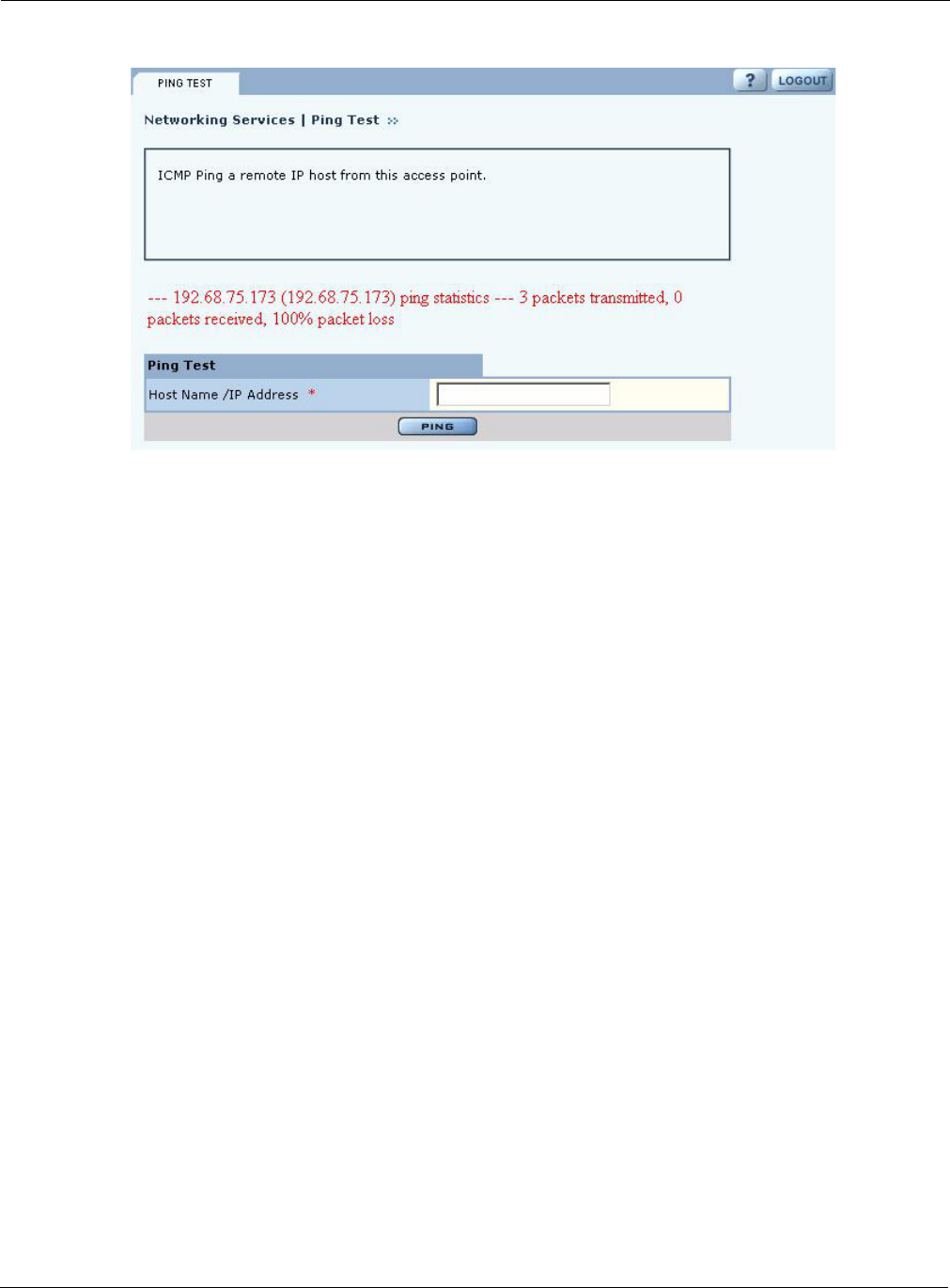
5 Configuring Networking Settings
132 Installation and User Guide: Airgo Access Point
Figure 95: Ping Test
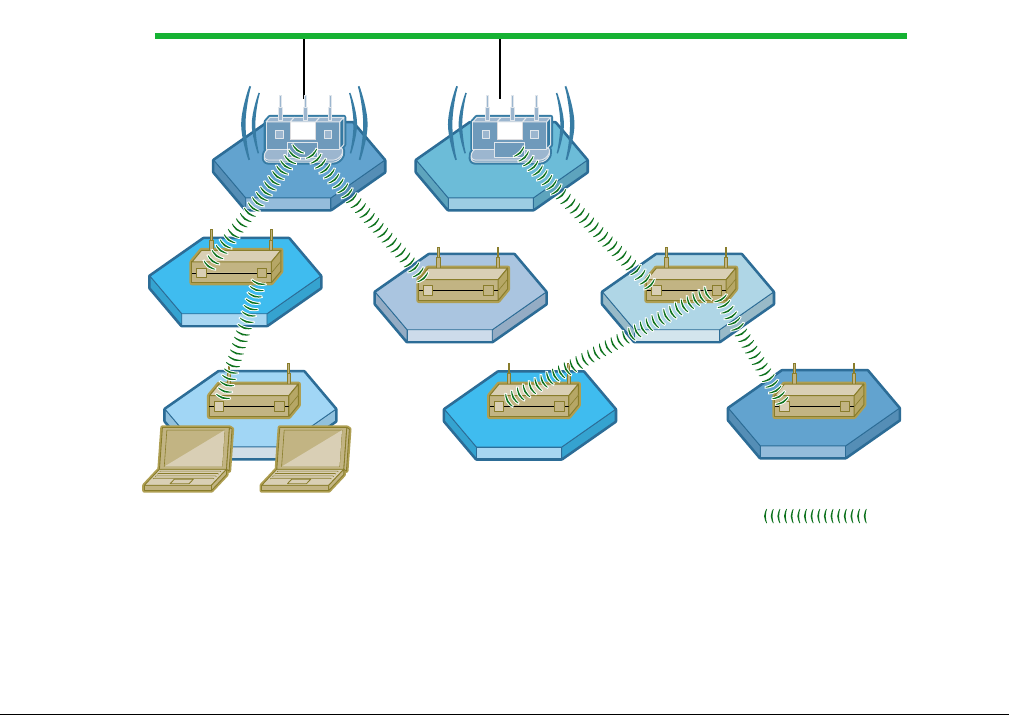
Installation and User Guide: Airgo Access Point 133
6Configuring a Wireless Backhaul
This chapter explains how to set up a wireless distribution system to cover a large area with limited
wired network connectivity. It covers the following topics:
•Introduction
•Use of Radios for Backhaul
•Wireless Backhaul Security
•Non-Wired or “Pseudo-Wired” Backhaul Configurations
•Setting Up a Wireless Backhaul
Introduction
In a typical wireless backhaul configuration, some APs connect directly to the wired network, while
others relay wireless signals from clients to the APs connected to the wired network. Wireless
backhaul interconnects multiple Airgo Access Points to form a wireless distribution system in
which an 802.11 network covers large areas, such as a campus or open area with relatively few
wired access points (Figure 96).
Figure 96: Wireless Backhaul Network
Applications of wireless backhaul include building-to-building bridging and 802.11b traffic
aggregation. Support for wireless backhaul includes bridge creation, instantiation of logical bridge
A0007B
Wireless Backhaul =
10/100 Switched Ethernet
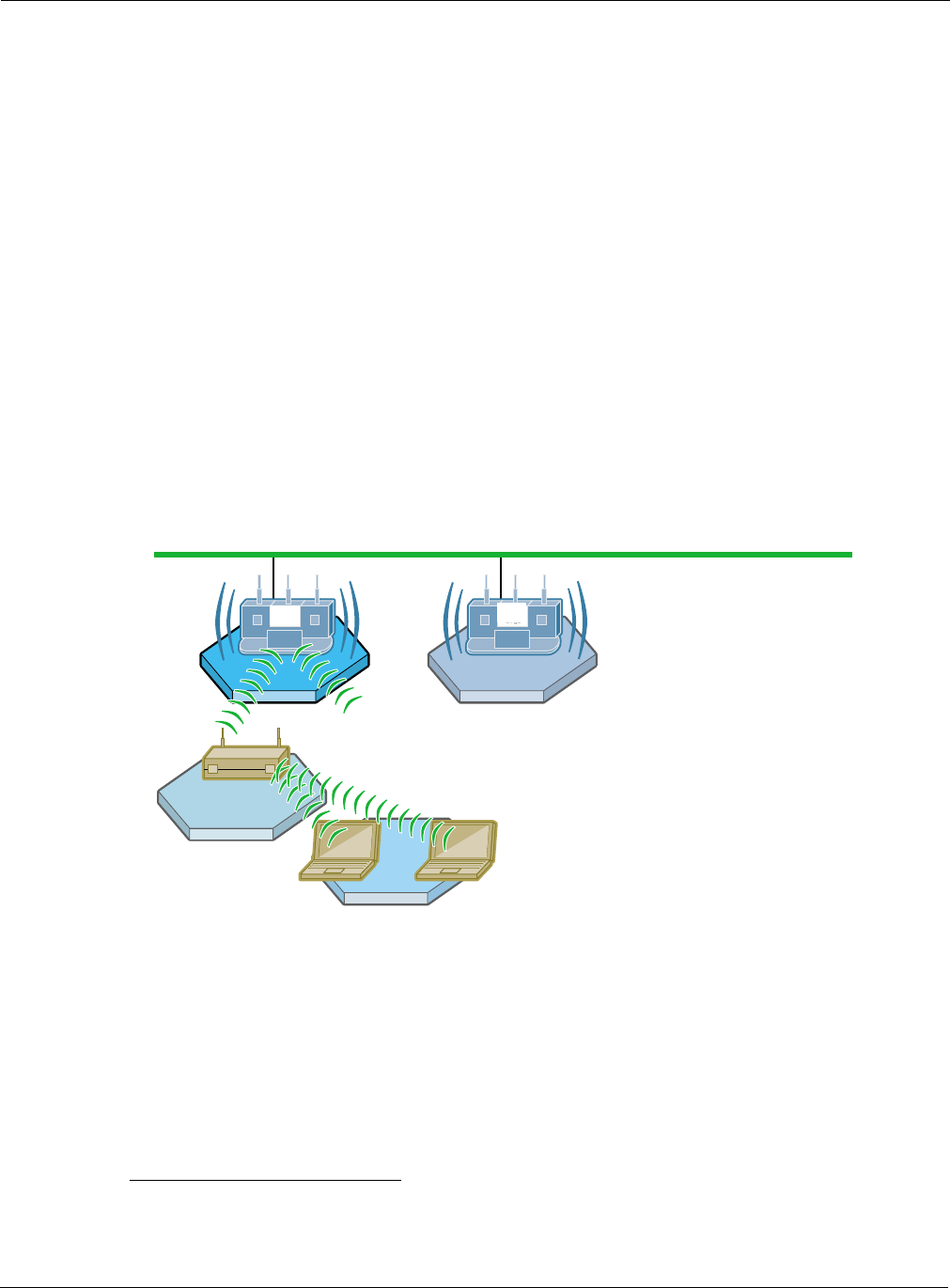
6 Configuring a Wireless Backhaul
134 Installation and User Guide: Airgo Access Point
ports on radios, and bridging functions such as address learning, packet forwarding, and spanning
tree protocol (STP).
Use of Radios for Backhaul
Each access point in a backhaul configuration must have two radios and be enrolled in the
network.1 Typically, one of the radios operates in normal (AP) mode to serve downstream access
point radios or laptop clients. The other assumes the backhaul point (BP) role, relaying network
traffic upstream from laptop clients or other access point BP radios.
A radio or radios can be configured to operate in the BP mode even if its AP is directly connected
to the wired network, as in the case of building-to-building bridge applications.
Radio Bands and Backhaul Hops
Figure 97 illustrates how the AP and BP radios operate in a backhaul arrangement. For a BP radio
to establish a link with an upstream access point, it must be able to receive radio signals from the
AP radio in the upstream access point. Accordingly, the node with the BP radio must be within
range of the upstream AP radio.
Figure 97: AP and BP Radios in Backhaul Arrangement
To prevent interference from compromising communications, the radios on each access point must
operate in different bands. If the AP radio operates in the 2.4GHz band, then the BP radio must
operate in the 5GHz band, and vice versa. As the number of hops increases, this creates an
alternating band pattern (Figure 98).
1Each access point must have a wired connection to be enrolled in the network (see “Enrolling APs” on page 181). After the
AP is enrolled, the wired connection can be removed.
10/100 Switched Ethernet
AP Radio
AP Radio
Client Client
BP Radio
Security Portal AP
A00052

Use of Radios for Backhaul
Installation and User Guide: Airgo Access Point 135
Figure 98: Frequency Bands and Hops in Wireless Backhaul Networks
The alternating band requirement carries implications for the number of backhaul hops that may be
desired to support network clients. The Airgo Access Point can technically support up to 7
backhaul hops from a client upstream to the wired AP; however, in practice, it is desirable to limit
the number of hops for the following reasons:
•Legacy client support: To support a wide range of legacy clients, the link from clients to the
downstream APs should be in the 2.4GHz band. Restricting the number of backhaul hops to
two allows the client links to operate at 2.4GHz and the backhaul link to operate at 5GHz. All
client types are served, and the two access point radios operate in different bands, as required
(Figure 98).
•Performance: As the number of hops increases, maintaining performance may require
advanced tuning of network parameters and restrictions on the number of supported APs and
clients.
Wireless Backhaul Trunks
A trunk is a wireless connection from one access point radio to another. An access point that is not
connected to the wired network or an access point radio explicitly configured in the BP mode tries
to establish a wireless trunk connection to another access point. A succession of trunks established
between access points provides a path from client stations through the wireless network to the
wired network.
If a trunk connection fails or a backhaul link goes down, the access point that established the trunk
re-scans the wireless environment and attempts to connect to another AP radio with compatible
wireless and network characteristics. This process is called retrunking.
Backhaul retrunking usually occurs quickly (in two to three seconds) if uplink candidates are
available. Subnets do not change as a result of retrunking. If a backhaul trunk fails and the BP radio
cannot reestablish (recover) backhaul within 30 minutes, all backhaul links formed with its uplink
AP radio are brought down. This gives an opportunity for the downlink nodes to attempt to form
alternate backhaul paths.
Second hop: 2.4 GHz
Good for legacy clients
5 GHz
First hop: 5 GHz
Root AP:
2.4 and
5 GHz
A0059
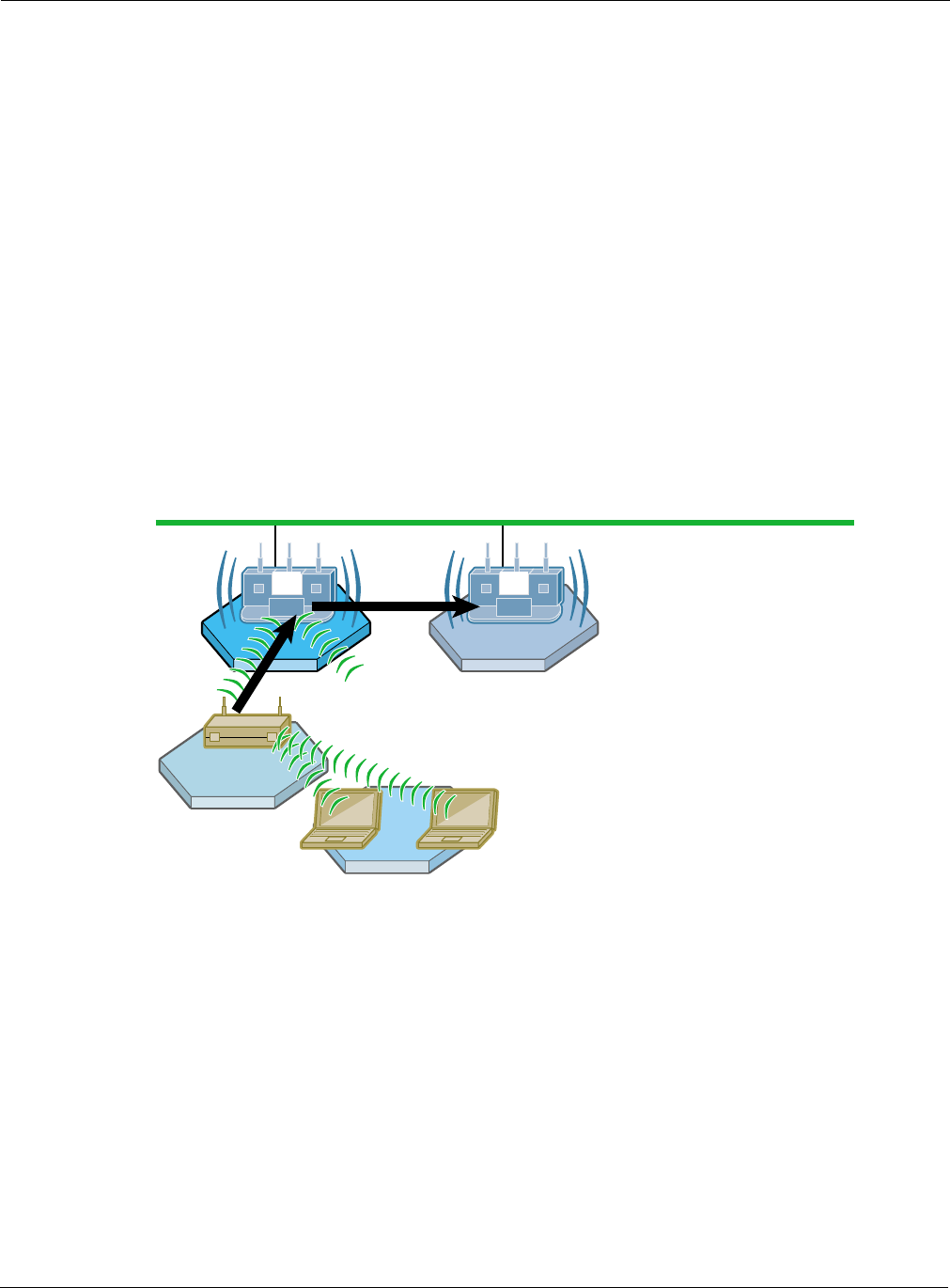
6 Configuring a Wireless Backhaul
136 Installation and User Guide: Airgo Access Point
Wireless Backhaul Security
By implementing a common security policy across the network, you can provide appropriate
security to clients while also ensuring that incompatibilities do not prevent formation of wireless
backhaul links.
Overall wireless backhaul security depends upon the security modes assigned to all the AP and BP
radios in the backhaul arrangement. The security mode assigned to the access point (see “Security
Mode” on page 150) determines the security used by each AP radio, while the backhaul security
policy (see “Link Criteria” on page 138) determines the security used by each BP radio. When a BP
radio attempts to form a backhaul, the upstream AP authenticates locally, in the case of PSK, WEP,
or Open security, or sends the request to the security portal, in the case of certificate-based security
(Figure 99).
Each link from a client through to the root AP should use the same security mode; therefore, the AP
and BP security modes should be the same. It is strongly recommended that you apply the same
global security policy across the entire network, thereby ensuring that backhaul trunks can form
wherever needed.
Figure 99: Certificate Authentication in Wireless Backhaul Network
Certificate security provides the highest level of protection and is the default option for backhaul
security. The APs must be managed by NM Portal or NMS, and a security portal must be
configured to service backhaul authentication requests. For backhaul authentication, requests are
sent from the BP radio through to the security portal (see Figure 99).
From the perspective of the wired APs, each backhaul AP appears as a client; however, these
“clients” are not identified in the RADIUS user database. For authentication purposes, identity
information for the backhaul APs is automatically entered into the internal RADIUS database on
the security services portal AP upon enrollment of the backhaul node. Users cannot view or modify
this information.
WPA-PSK provides effective security without requiring a security portal for backhaul
authentication. Backhaul authentication is managed with the same PSK password used for the
global security setting. When configuring a network of APs for wireless backhaul with WPA-PSK,
10/100 Switched Ethernet
AP Radio
AP Radio
Client Client
BP Radio
Security Portal AP
A00053

Wireless Backhaul Security
Installation and User Guide: Airgo Access Point 137
be sure that all APs are configured with identical SSID and PSK-password. This is necessary
because PSK-password is bound to the SSID. A BP radio in a wireless backhaul network uses the
PSK-password tied to the SSID to authenticate with an uplink AP. Even if you configure the BP
backhaul criteria to include the correct uplink AP SSID, it will not form a backhaul if the SSID on
the downlink AP is different from that of the uplink AP.
The WEP or Open option for backhaul security is compatible with either WEP or Open as the
global security policy. If the global security mode is WEP on the AP and the wireless backhaul
security mode is open or WEP on the BP radio, the backhaul will form with WEP security. If the
global security mode is Open on the AP and the backhaul security mode is WEP or Open on the BP
radio, then the backhaul will form with open security. The WEP or Open option is appropriate for
hotspots, other networks that must support legacy clients, or applications such as hospitality suites
that may have no security requirements.
Table 12 lists the available backhaul security options. For detailed information on these options,
see Chapter 7, “Managing Security.”
Table 12: Wireless Security Settings for AP and BP Radios
Wireless Security (AP) Backhaul Security (BP) Comments
Configuration of Wireless
Security on Uplink AP
Configuration Required for
Backhaul Security on
Downlink AP (Any One of
Following)
Security
Portal
Required
Valid BP Authentication
Modes that will Allow
Backhaul to Form
WPA-
EAP
WPA-
PSK
Open
or
WEP Certif. PSK
Open-
or-
WEP
Enable Disable Disable Enable Disable Disable Y BP->AP->security portal
using WPA-EAP
(Certificate)
Disable Enable Disable Disable Enable Disable N BP->AP using WPA-PSK
only
Disable Disable Enable Disable Disable Enable N BP->AP using WEP, OR
BP->AP using Open
Enable Enable Enable Enable Disable Disable Y BP->AP->security portal
using WPA-EAP
(Certificate)
Enable Enable Enable Disable Enable Disable Y BP->AP using WPA-PSK
Enable Enable Enable Disable Disable Enable Y BP->AP using WEP, OR
BP->AP using Open
Enable Enable Disable Enable Disable Disable Y BP->AP->security portal
using WPA-EAP
(Certificate)
Enable Enable Disable Disable Enable Disable Y BP->AP using WPA-PSK
Disable Enable Enable Disable Enable Disable N BP->AP using WPA-PSK
Disable Enable Enable Disable Disable Enable N BP->AP using WEP, OR
BP->AP using Open

6 Configuring a Wireless Backhaul
138 Installation and User Guide: Airgo Access Point
Non-Wired or “Pseudo-Wired” Backhaul Configurations
It is possible to configure a wireless backhaul to operate without a working connection to a wired
network. This approach may be useful in a warehouse or factory setting as a means of establishing
a wireless network disconnected from the corporate infrastructure. Clients can communicate with
each other across the wireless distribution system without the need for administrative controls to
restrict access to backend servers or the Internet.
You can configure non-wired backhaul in either of the following two ways:
Setting Up a Wireless Backhaul
Choose Wireless Backhaul from the Wireless menu to bring up the Wireless Backhaul
configuration panel. The panel contains the following tabs:
•Link Criteria — Configure criteria for backhaul trunk formation.
•Candidate APs — Identify APs to use for the uplink.
•Trunk Table — View the list of current backhaul trunks.
•Trunk Stats — View statistics for the backhaul trunks.
Link Criteria
Use the Link Criteria tab (Figure 100) to set up the network parameters for the wireless backhaul.
These parameters specify the rules that apply to the BP radios which form uplink backhaul trunks
by associating to normal (AP) radios. BP radios use the link criteria to determine the set of suitable
APs for the backhaul trunk.
Portal Method Stage the AP deployment as if it will be connected to your wired
infrastructure. Configure one of the APs as an NM Portal and enroll the
other APs. Then configure the NM Portal AP to be in “wired only” mode.
When you deploy the APs in the completely-wireless setting, they will
automatically form a wireless backhaul with the NM Portal AP as the
root, even though the NM Portal AP no longer has a wired connection.
Non-Portal Method Manually configure each AP as a normal AP, making sure to select a
global security mode that does not require use of a security portal (WPA-
PSK, WEP, or Open). Select one of the APs to be in “wired-only” mode.
When you deploy the APs, they will automatically form a wireless
backhaul with the “wired-only” AP as the root, even though the AP does
not have a wired connection.
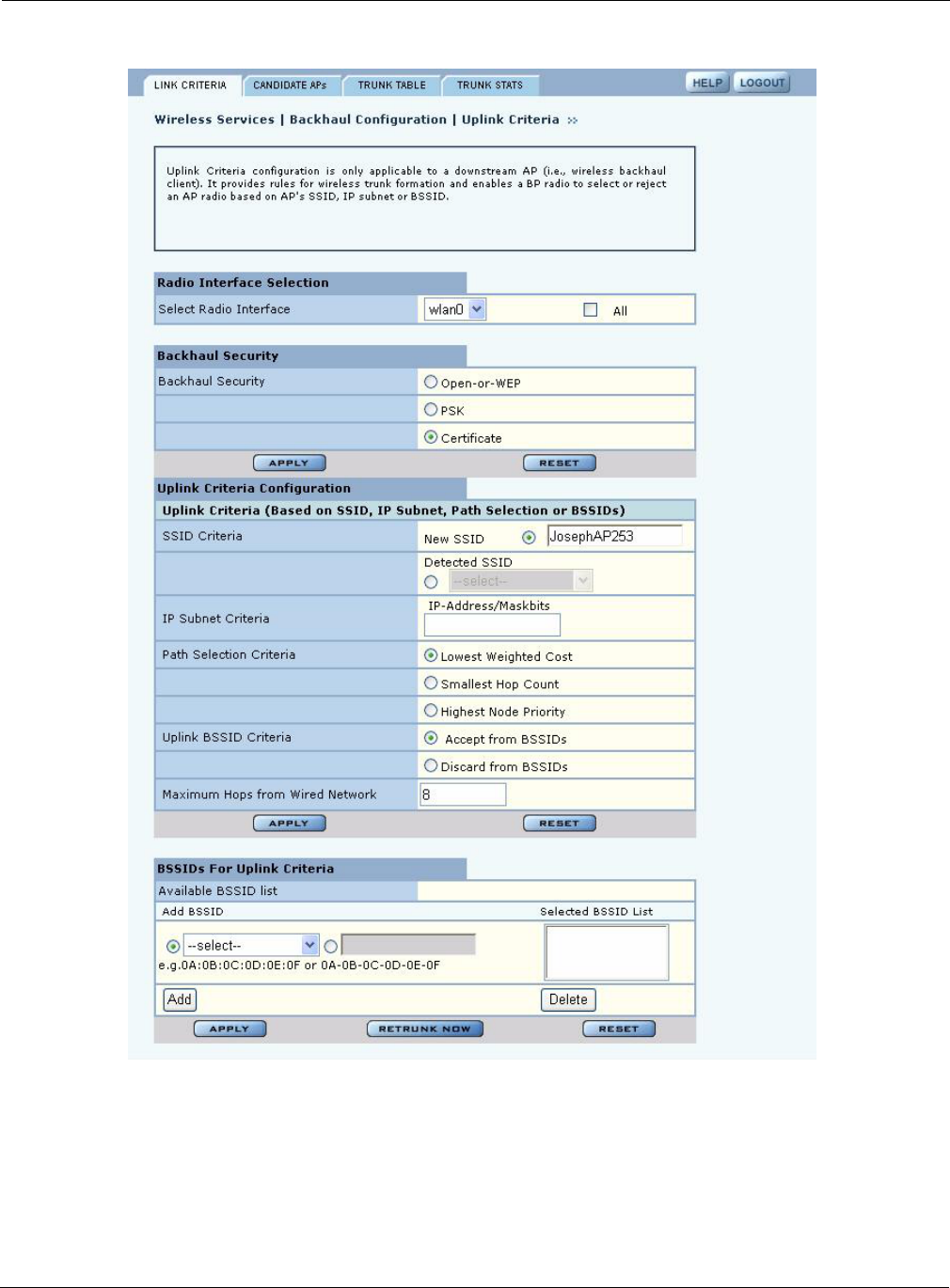
Setting Up a Wireless Backhaul
Installation and User Guide: Airgo Access Point 139
Figure 100: Backhaul Configuration - Link Criteria

6 Configuring a Wireless Backhaul
140 Installation and User Guide: Airgo Access Point
The Uplink Configuration settings on this tab restrict how the backhaul is configured. Select some
or all of the settings, or leave this section blank to permit unrestricted choice of uplinks:
After making changes in the Uplink Criteria Configuration section, click Apply. Click Reset to
return the parameters on the panel to the previously saved values.
Field Description
Select Radio Interface Select radio wlan0 or wlan1.
Backhaul Security Select from the following options (see “Wireless Backhaul Security” on
page 136 for more information):
•Open-or-WEP: Compatible with the WEP or Open global security mode.
•PSK: Compatible with the WPA-PSK global security mode using the same
pre-shared key.
•Certificate: Compatible with the WPA-EAP global security mode.
Requires that the network have a security portal configured to provide
backhaul authentication.
SSID Criteria Select Detected SSID to connect to a specific network. To add an SSID that
has not been detected, select New SSID and enter the name of the SSID. This
configuration is one of the attributes used by the radio in BP mode to form a
backhaul.
IP Subnet Criteria Enter an IP address and subnet prefix length to restrict the backhaul to a
specific subnet. The BP radio selects those APs as candidates that advertise
the specified subnet. If the IP address is 0.0.0.0, the BP radio ignores the
subnet ID as a criterion when selecting AP candidates for trunk formation.
Path Selection Criteria Choose the criterion for selecting the best wireless backhaul route from the
following three options:
•Lowest Weighted Cost — Candidate parent APs are selected in ascending
order of path cost. (The candidate parent with lowest path cost to the wired
network is the one with highest priority). Path cost is a cumulative metric
in which each hop contributes to the path cost value. The calculation
factors in the backhaul and non-backhaul traffic load on the candidate AP
and quality of the link between the backhaul end points.
•Smallest Hop Count — Candidate parents are selected in ascending order
of hop count (number of hops to the wired network).
•Highest Node priority — Candidate parents are selected in ascending order
of priority as determined by the configured uplink BSSID list.
Uplink BSSID Criteria This parameter is used in conjunction with the area entitled “BSSIDs For
Uplink Criteria” at the bottom of the tab to restrict uplink candidates to a
specific set of BSSIDs or to permit all BSSIDs except a designated list.
•To restrict candidates to a designated list, select Accept from BSSIDs.
•To avoid candidates on a specified list, select Discard from BSSIDs.
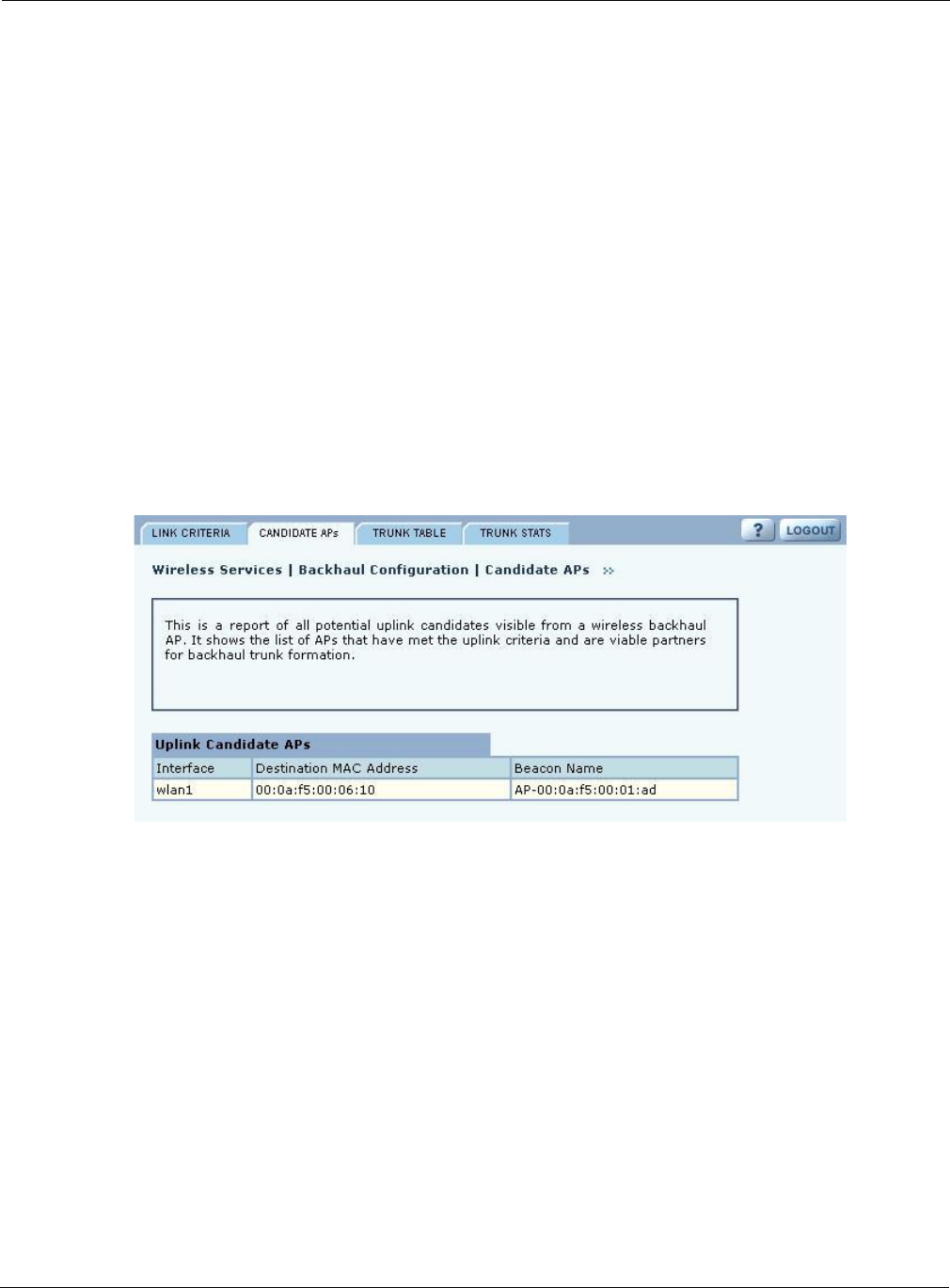
Setting Up a Wireless Backhaul
Installation and User Guide: Airgo Access Point 141
Use the area at the bottom of the tab to specify the BSSID criteria (in conjunction with the Uplink
BSSID buttons):
After adding BSSIDs, click Apply. The BP now attempts to establish a backhaul link based upon
the configured rules.
Click Delete to remove a BSSID from the list.
Candidate APs
Select the Candidate APs tab (Figure 101) to identify the access points that can be used to create the
uplink to the wired network.
Figure 101: Backhaul Configuration - Candidate APs
The panel displays the discovered APs able to provide uplink connectivity. The table of uplink
candidate APs shows the following information:
If no uplink candidate APs are available, the table is empty.
Trunk Table
Select the Trunk Table tab (Figure 102) to view the list of current backhaul trunks. The backhaul is
established if the MAC address of the backhaul trunk is listed in the table.
Field Description
Add BSSID To add BSSIDs to the Selected list, add from the pull-down list, and click
Add. Alternatively, enter the name of a BSSID, and click Add. The saved
BSSIDs are displayed in the selected BSSIDs list on the right. This list that
determines acceptable uplink candidates (if Accept from BSSIDs was selected
in Uplink BSSID Criteria), or eliminated uplink candidates (if Discard from
BSSIDs was selected).
Item Description
Interface Radio interface of uplink candidate parent
Destination MAC
Address
BSSID of the remote uplink candidate parent
AP Beacon Name Name of the AP node of the candidate parent, sent in beacons
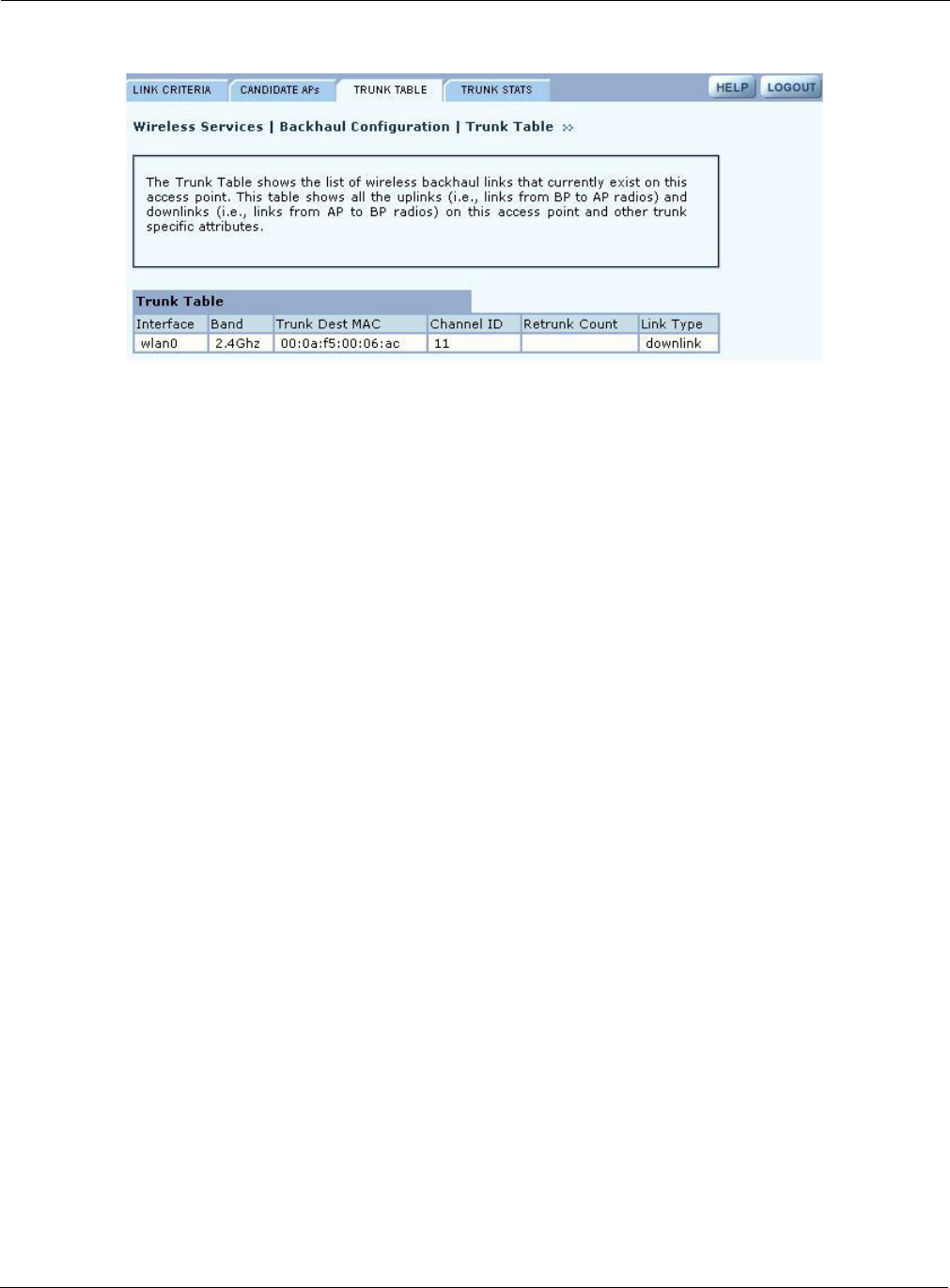
6 Configuring a Wireless Backhaul
142 Installation and User Guide: Airgo Access Point
Figure 102: Backhaul Configuration - Trunk Table
This tab contains the following information:
If no trunks are detected, the table is empty.
Trunk Statistics
Select the Trunk Statistics tab (Figure 103) to view statistics for the available backhaul trunks. If no
trunks are detected, the table is empty. To clear the cumulative statistics, click Clear Statistics.
Feature Description
Interface Name Radio interface of the BP radio (uplink) or AP radio (downlink) to which
downlink trunks are connected. Applies to uplink and downlink trunks.
Band (2.4GHz or 5GHz,
or both)
Operating band of the uplink or downlink trunks. Applies to uplink and
downlink trunks. For the uplink trunk the band is the operating band of the BP
radio. For downlink trunks, the band is the operating band of the AP radio.
Trunk Dest MAC MAC address (BSSID) of the remote backhaul destination. For uplink trunks
this is the MAC address of the parent AP; for downlink trunks it is the MAC
address of the BPs (children) associated with the AP radio. Applies to uplink
and downlink trunks.
Channel ID of the channel on which the backhaul trunks (uplink and downlink) are
operating. Applies to uplink and downlink trunks.
Re-trunk counts Number of times the BP (uplink) retrunked (could be due to trunk failure or
trunk optimization). Applies only to the uplink trunk.
Link Type Indication of whether the interface is an uplink or downlink trunk.
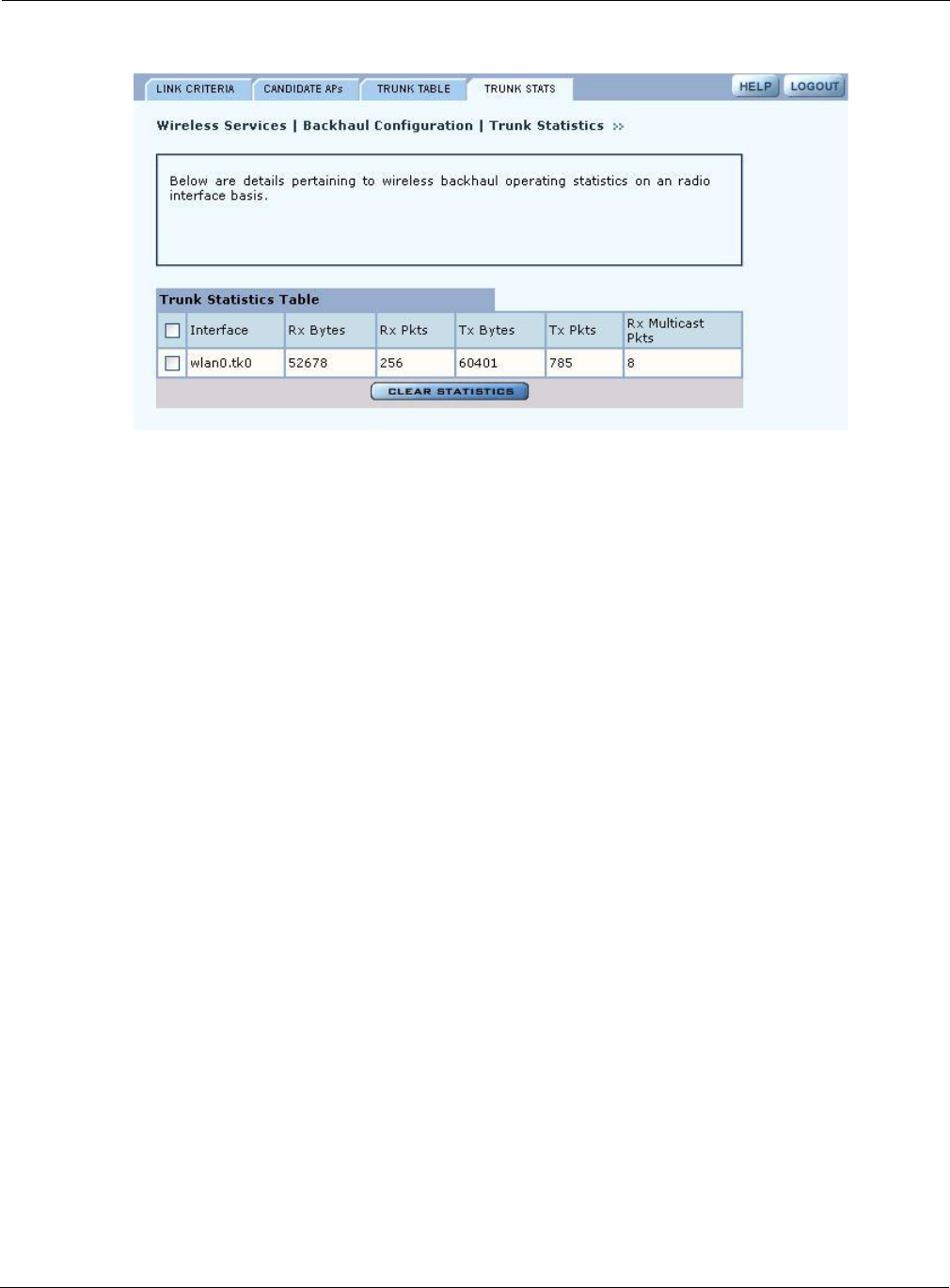
Setting Up a Wireless Backhaul
Installation and User Guide: Airgo Access Point 143
Figure 103: Backhaul Configuration - Trunk Stats
This tab contains the following information:
Click Clear Statistics to return the counts in this tab to zero and begin collecting statistics again.
Field Description
Interface The AP radio interface (wlan0 or wlan1)
Rx Bytes Number of bytes received at this AP
Rx Packets Number of packets received at this AP
Tx Bytes Number of packets transmitted by this AP
Tx Packets Number of packets transmitted by this AP
Rx Multicast Packets Number of multicast packets received by this AP

6 Configuring a Wireless Backhaul
144 Installation and User Guide: Airgo Access Point

Installation and User Guide: Airgo Access Point 145
7Managing Security
This chapter describes the encryption and authentication features of the Airgo Access Point and
explains how to set the security configuration. The chapter includes the following topics:
•Introduction
•Security Elements
•Data Encryption
•Zone Privacy
•Configuring Wireless Security
•Configuring Authentication Zones
•Configuring Administrator Security
•Viewing Security Statistics
•Configuring Advanced Parameters
•Configuring Zone Privacy
Introduction
Airgo Networks offers the strongest available security options for wireless networking, as listed
here and illustrated in Figure 104:
•AP Security verifies the identity of individual APs and authorizes them to be part of the
wireless network. APs can be enrolled individually or pre-enrolled as a group. The process uses
a certificate and password to fully verify the identity of the AP. By clearly identifying which
APs belong to the authorized set, the enrollment process can also help identify unauthorized or
rogue APs.
•Administrator security authorizes designated users to access the configuration and management
capabilities of the AP using https, SSH, or SNMPv3 for the web interface, CLI, or network
management system.
•User security encompasses authentication and encryption. Authentication verifies the identity
of individual users and gives them access to the network, restricted to specific network service
profiles. Once the network and authenticated users are in place, data encryption protects the
privacy of user data transmitted over the wireless network.
•Guest access security provides password or custom access control for guest users, including the
configuration of a guest VLAN for Internet access and session management.
NOTE: For information on security for access point enrollment, refer to Chapter 9,
“Managing the Network.”
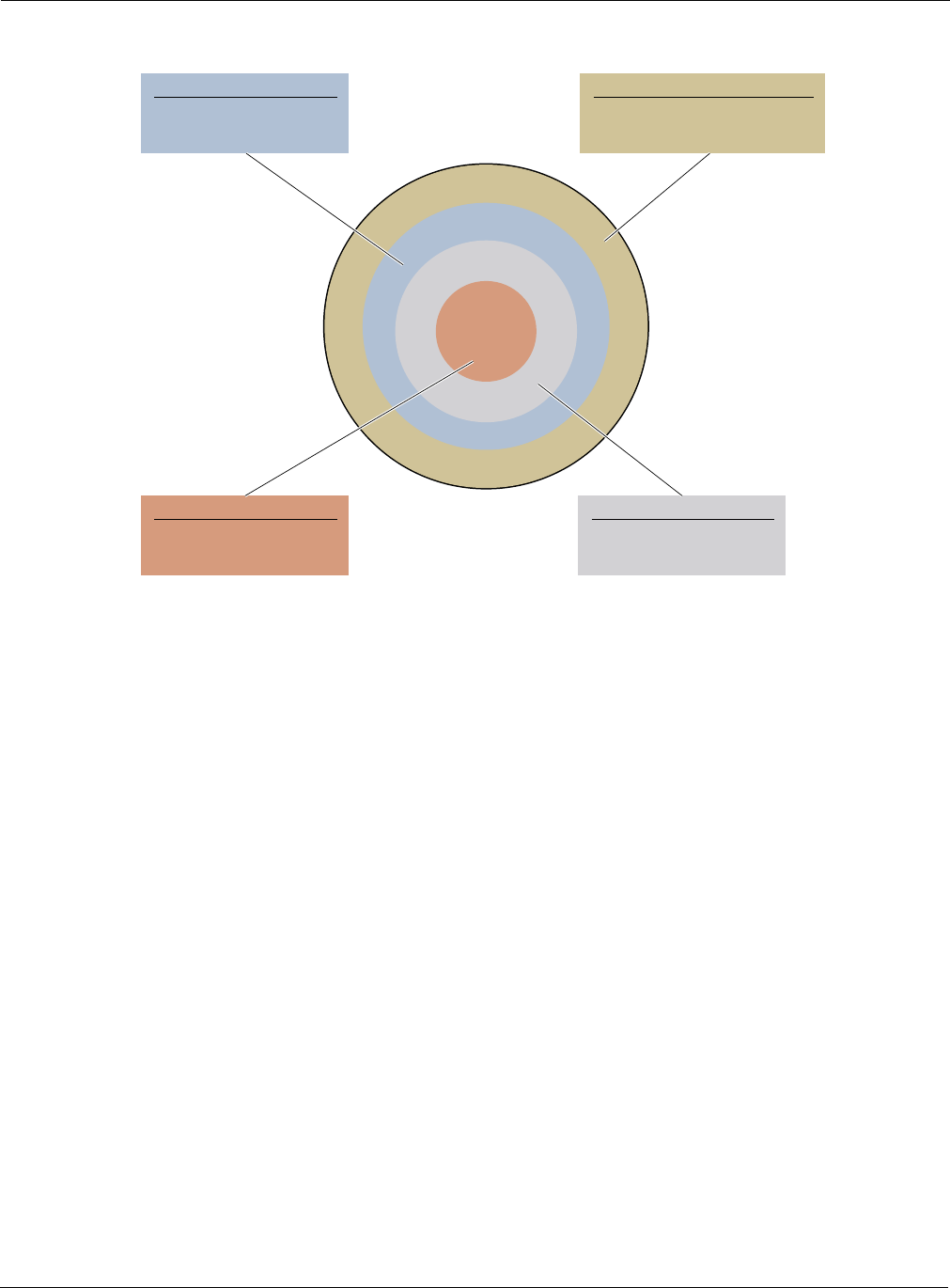
7 Managing Security
146 Installation and User Guide: Airgo Access Point
Figure 104: Wireless Security Elements
Security Elements
Each security element emphasizes a different aspect of wireless network security. Guest security is
described in Chapter 8, “Configuring Guest Access.”
AP Security
A highly secure process is provided to enroll access points. Three distinct levels of identification
verify the AP: device ID, thumbprint, and a bootstrap password unique to the AP. To assure central
control of the verification process, it is recommended that a single enrollment server handle
enrollment for the entire wireless network. The architecture supports two enrollment server
options:
•AP Enrollment Server — Designate an NM Portal AP as the enrollment server for the network.
For instructions, see Chapter 9, “Managing the Network.”
•NMS Pro — The NMS Pro network management system, offered as a separate product,
operates as a complete enrollment solution for the enterprise. In addition to supporting manual
AP enrollment, NMS Pro includes automatic AP pre-enrollment by way of a bar code reader
interface. For information on using NMS Pro, see the NMS Pro Installation and Configuration
Guide.
Administrative Security
SSH, https, and SNMPv3 are used for secure administrative access to the AP.
Users Security
¥ All WPA Modes
¥ EAP-TLS, -PEAP, -PSK
¥ AES, TKIP, or WEP Encryption
A004
7
AP Security
¥ Secure AP Enrollment
¥ Batch or One-Click
¥ Certificates & Password
Admin Security
¥ Admin & Operator
¥ Username, Password
¥ SSH, HTTPS, SNMPv3
Guest Security
¥ Password or Custom Access Control
¥ Guest-VLAN for Internet Access
¥ Session Management
Guest Security
User Security
Admin Security
AP
Security

Data Encryption
Installation and User Guide: Airgo Access Point 147
User Security
Acceptable and effective solutions for user authentication depend upon the network size,
complexity, and existing authentication infrastructure.
Current user authentication standards are based on the IEEE 802.1x specification, which identifies
users and permits connectivity based upon policies established in a central server. Many
authentication servers use the Remote Authentication Dial-In User Service (RADIUS) protocol,
which enables remote access servers to communicate with the central server to authenticate users
and authorize service or system access. Within the RADIUS context, the most effective
authentication methods use versions of the Extensible Authentication Protocol (EAP) for the end-
to-end authentication of the client by the authentication server.
The Airgo AP can meet all the user authentication needs for the full range of wireless networks.
(See Chapter 2, “Planning Your Installation.”) Several modes of authentication are supported, as
listed in Table 13. WPA-PSK uses pre-shared keys (PSK) configured directly by the administrator
into the AP and network clients. Based on the network-wide key, the clients and AP receive unique
session keys for each client session. This approach can be effective for small businesses for which
strong encryption is desired but a centralized authentication infrastructure is not available. EAP-
TLS (EAP with Transport Layer Security) is a certificate-based authentication method based on the
TLS protocol. The RADIUS security services within the Airgo AP provide EAP-TLS for user
authentication. Integration is also supported with RADIUS servers that support EAP-TLS or EAP-
PEAP.
In addition to the EAP-based authentication methods, WEP-based encryption is available for
legacy clients. The option of no user authentication is also available.
Data Encryption
Table 14 lists the available options for data encryption, in order of decreasing protection. The
current standard for data encryption is WPA-AES, which provides financial-grade protection. The
WEP encryption options use 64-bit or 128-bit encryption keys, assigned manually or dynamically,
as dictated by the capabilities of the client. These offer some protection against casual interlopers;
however, the WEP algorithms are vulnerable to compromise and can be difficult to maintain.
WPA-TKIP closes the major WEP loopholes and can be an acceptable alternative to standard WEP.
Table 13: Authentication Options
Type Description
EAP-TLS Certificate-based authentication, used by the security portal and many external
RADIUS servers
EAP-PEAP EAP-PEAP RADIUS-based authentication
WPA-PSK Authentication acceptable for small to mid-size installations, in which manual
distribution of keys is convenient and centralized management is not required
Dynamic WEP with
802.1x
Not recommended due to limitations of the WEP algorithms. If it is necessary
to use this option to support legacy equipment, make sure a RADIUS server is
configured for the SSID. The RADIUS server should be configured to support
EAP-TLS or EAP-PEAP. Note that the Airgo Wireless LAN Client Adapter
does not support dynamic WEP.
None No user authentication

7 Managing Security
148 Installation and User Guide: Airgo Access Point
Open encryption provides no protection, and is only recommended when security is not of concern.
WPA-AES is recommended for all installations, if possible.
Configure and view the following aspects of network and user security from the web interface:
•Wireless Security — Select protocols for data encryption and user authentication.
•Authentication Zones — Group RADIUS servers for user authentication.
•Administrator Security — Set the administrator login and password to access the AP.
•RADIUS Servers — Identify authorized RADIUS servers and zones.
•Security Statistics — View security-related statistics, including authentication, 802.1x
supplicant, and authentication diagnostic statistics.
•Advanced — Configure advanced RADIUS properties.
Zone Privacy
Zone Privacy improves security for users in public hot spots by isolating client stations from each
other. When zone privacy is deployed, a station can connect to the wired network but is not able to
reach other stations associated to the same AP or stations associated to other APs over wireless
backhaul. This section provides an overview of zone privacy. For configuration instructions, see
“Configuring Zone Privacy” on page 164.
Zone privacy isolates client stations from each other by limiting the paths along which APs forward
traffic. When zone privacy is enabled, the AP forwards traffic from client stations to the Ethernet
interface but does not redistribute the traffic back to the AP BSS, nor to the BSS on the second AP
radio. When zone privacy is enabled on APs interconnected over wireless backhaul, traffic from
client stations is forwarded toward the wired network over wireless backhaul connections. APs
receiving traffic from a BP (backhaul point) radio only forward traffic to another AP over a
wireless backhaul connection or to the Ethernet interface. APs in the wireless distribution system
do not forward traffic received from a BP radio to any other BSS.
The zone privacy rules governing traffic forwarding apply to traffic from client stations and to
management traffic from APs. Consequently, the partial network connectivity resulting from zone
privacy can affect features such as client roaming and peer-to-peer communications between APs.
To mitigate against any issues that may arise, enable zone privacy only on non-management
VLANs that carry only user data traffic. Specifically, subscriber privacy can be enforced if ports
attached to APs are members of different VLANs carrying user data. When zone privacy is desired
between two wired APs, all clients that associate to the two different APs are part of different user
Table 14: Encryption Options
Type Description
AES Highest level of protection
TKIP WEP with additional protection
WEP 128 First generation encryption using 128-bit keys; does not provide adequate
protection
WEP 64 First generation encryption using 64-bit keys; does not provide adequate
protection
Open No protection
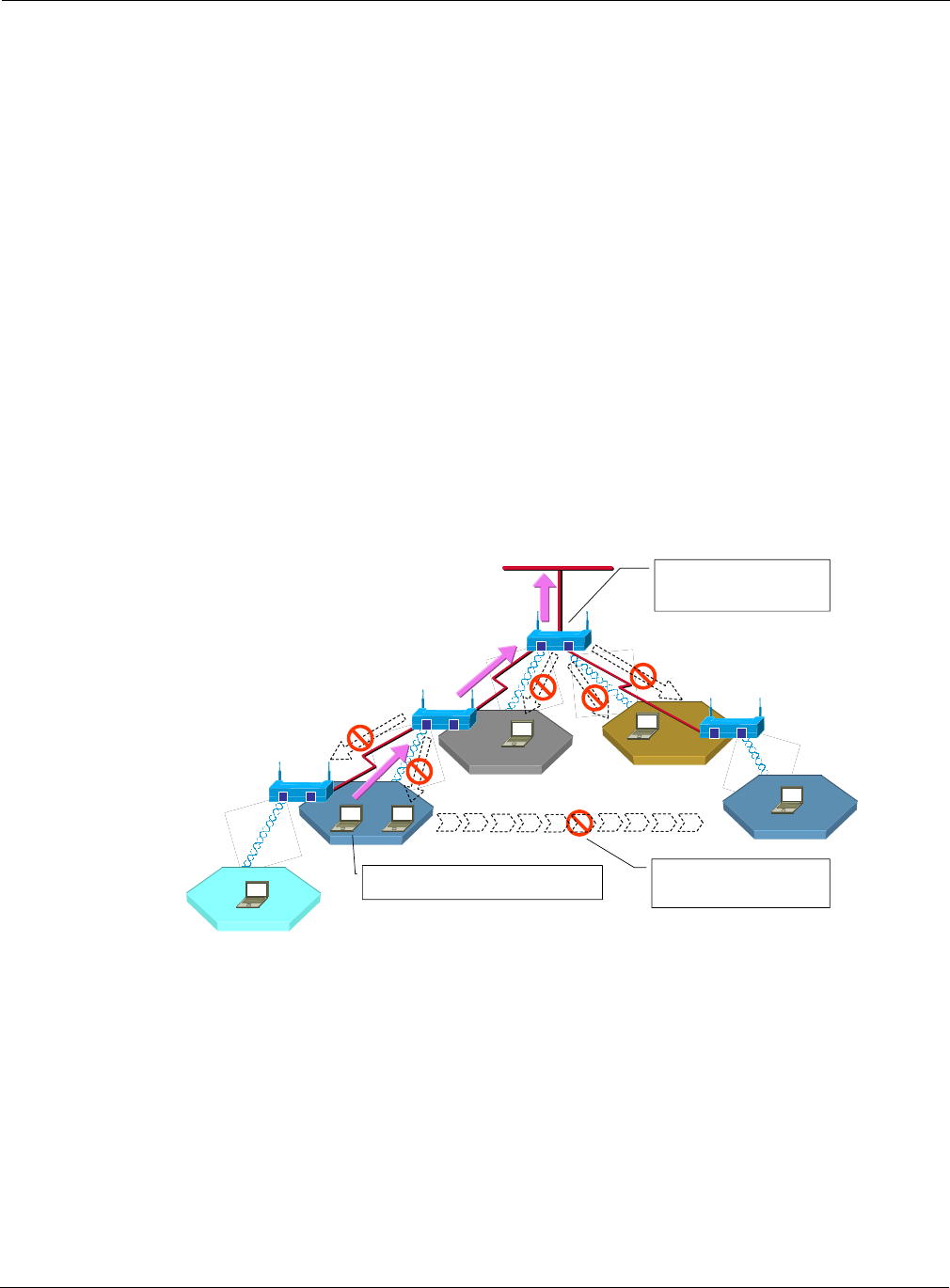
Zone Privacy
Installation and User Guide: Airgo Access Point 149
VLANs. A VLAN switch is able to segregate traffic between the two VLANs such that any client
of the first AP is not able to contact any client on the second AP.
To provide full connectivity between APs for management traffic, assign all ports on the APs to the
management VLAN.
Zone Privacy Deployment without VLANs
When zone privacy is implemented without VLANs, communication forwarding rules can affect
station and management traffic between the APs. The following deployment constraints apply
(Figure 105):
•The root AP for the wireless backhaul network must be attached to the wired network because
all downstream APs are guaranteed connectivity only to the root AP.
•APs should be managed using policy distribution from NM Portal because the station has
connectivity to only a subset of APs over the wireless backhaul.
•Station reassociation fails if a station roams to a BSS started by an AP that cannot exchange
Inter Access Point Protocol (IAPP) messages with the AP from which the station has moved.
The IAPP messages are used to support roaming of client stations between APs and enable
neighboring APs to keep up-to-date information concerning the status of roaming client
stations.
Figure 105: Zone Privacy Using a Single VLAN
Zone Privacy Deployment on Multiple VLANs
When zone privacy is deployed using multiple VLANs, you can designate one VLAN for
management traffic and others for user data. Enabling zone privacy only on the VLANs that carry
user data traffic eliminates several of the constraints caused by connectivity limitations. The
following requirements apply when using multiple VLANs to deploy zone privacy:
•The root AP for the wireless backhaul network must be attached to the wired network.
•Zone privacy for subscribers must be enabled on a non-management VLAN.
•APs can be managed directly from any station, if that the station is on the management VLAN.
•Roaming is unaffected by zone privacy because IAPP messages are sent on the management
VLAN that has full connectivity over the wireless distribution system.
“root” AP must be
connected to a wired
network
•APs managed indirectly by NM portal Roaming is impacted
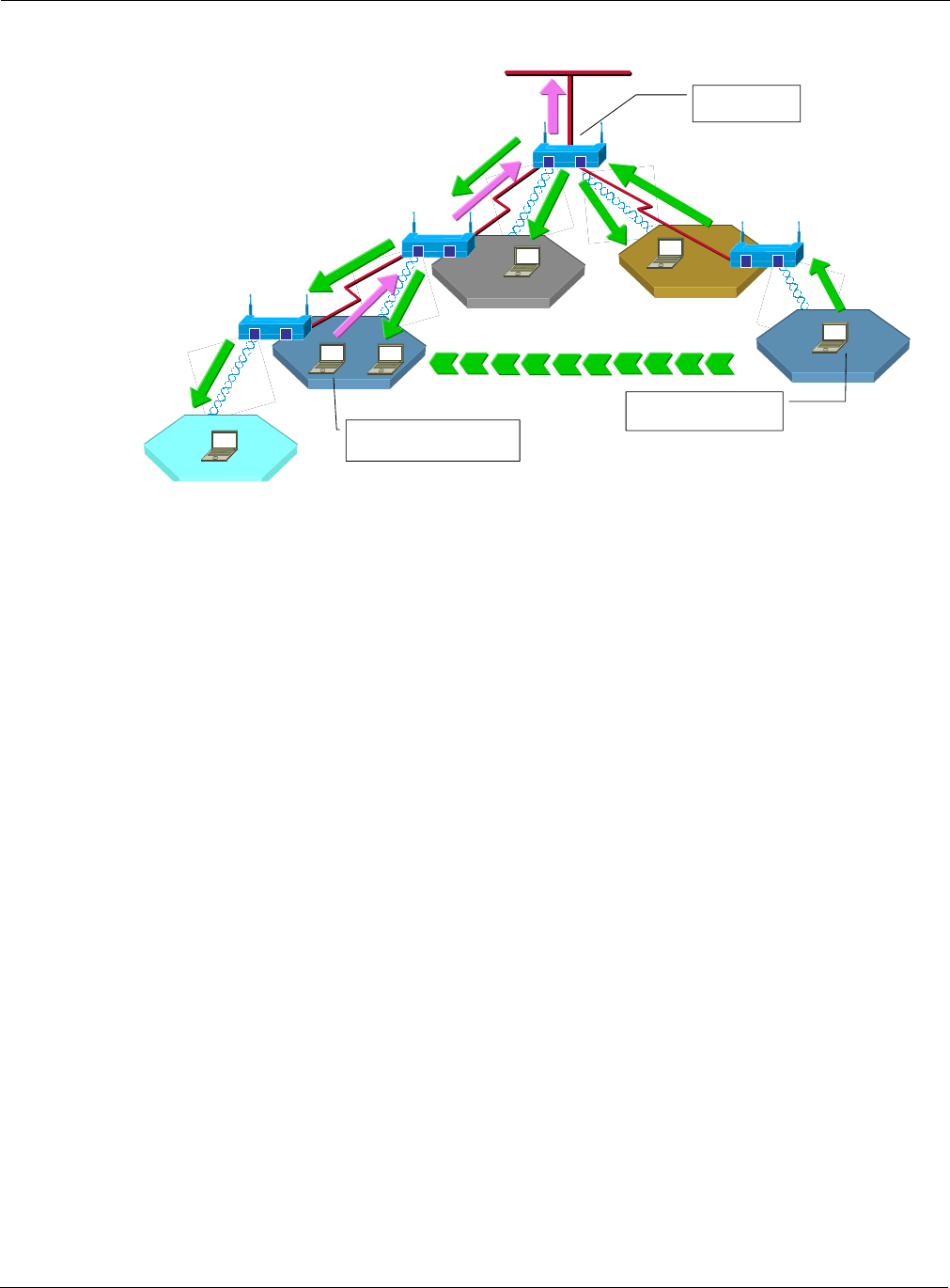
7 Managing Security
150 Installation and User Guide: Airgo Access Point
Figure 106: Zone Privacy - using a Management VLAN
Configuring Wireless Security
Choose Wireless Security from the Security Services menu to configure the protocols for data
encryption and user authentication. The Wireless Security panel contains two tabs:
•Security Mode — Configure WPA, WEP, or open encryption and authentication.
•SSID Auth — Configure security settings for the SSID.
Security Mode
Use the Security Mode tab (Figure 107) to assign the encryption and authentication methods,
including WPA, WEP, or Open. Allowing multiple encryption modes can be useful to support
installations with a mixture of client wireless adapters. The allowed combinations have some
limitations; it is not possible to enable both WEP and Open simultaneously. Also, Open and WPA
encryption modes require each mode to be mapped to a separate VLAN (see “Configuring VLANs”
on page 111).
“root” AP
Management VLAN
Non-management VLAN
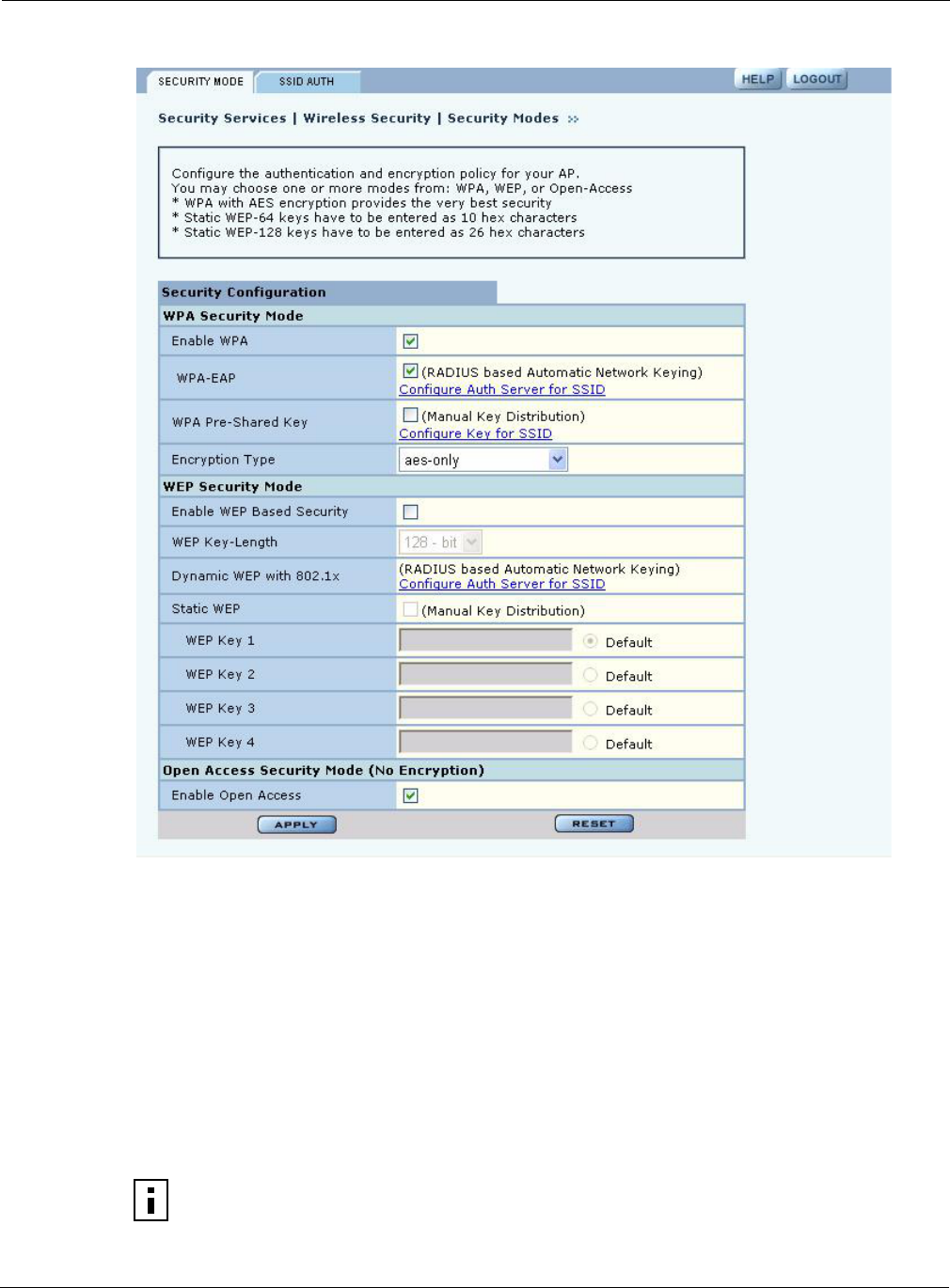
Configuring Wireless Security
Installation and User Guide: Airgo Access Point 151
Figure 107: Security Services - Security Mode
WPA Security
Select Enable WPA to activate the WPA authentication and encryption fields. The following
options are available:
Click Apply to save the configuration, or Reset to return to the previously saved values.
WPA provides strong encryption support with the AES and TKIP algorithms.
Field Description
WPA Security Mode WPA-EAP — For RADIUS-based networking keying
WPA-PSK — For pre-shared keys
Encryption Type AES, TKIP, AES, and TKIP
NOTE: Some early versions of WPA-capable client software may not permit a client to
associate to the AP when multiple modes of encryption and authentication are chosen.

7 Managing Security
152 Installation and User Guide: Airgo Access Point
WEP Security
If it is necessary to configure WEP security, select Enable WEP to activate the WEP fields.
Configure the following values in the WEP security area:
Click Apply to save the settings or Reset to clear the fields on the panel.
Open Access
Select Enable Open Access to omit data encryption. A pop-up message warns of the potential
security risk in using open access. Click OK to continue.
SSID Authentication
Use the SSID Authentication tab (Figure 108) to assign RADIUS Authentication servers or a WPA
pre-shared key. RADIUS based authentication uses lists of servers, called authentication zones,
which are provided by the Airgo AP security portal or an external RADIUS server. Each SSID can
be configured with the RADIUS servers used for EAP authentication and the WPA pre-shared key
(if applicable).
MAC-ACL lookups can be enabled for clients that associate with WPA-PSK, manual WEP-keys,
or with no security. MAC-ACL is not applicable if per user authentication is done where username
is available.
NOTE: Selecting WPA-EAP or WPA-PSK displays a link that leads to the SSID
Authentication tab. Refer to “SSID Authentication” on page 152 for instructions on
using this tab.
Field Description
Enable WEP Activate the WEP settings. The Airgo AP supports WEP with dynamic and
manually entered keys. To use dynamic keys, select WEP, but do not enter
values in the Key fields.
Key-Length Select 64-bit or 128-bit.
Key 1 - Key 4 Activated if WEP is selected as the security mode. Enter a WEP key. A WEP-
64 key is 10 hex characters, and a WEP-128 key is 26 hex characters.
(required if security mode is WEP)
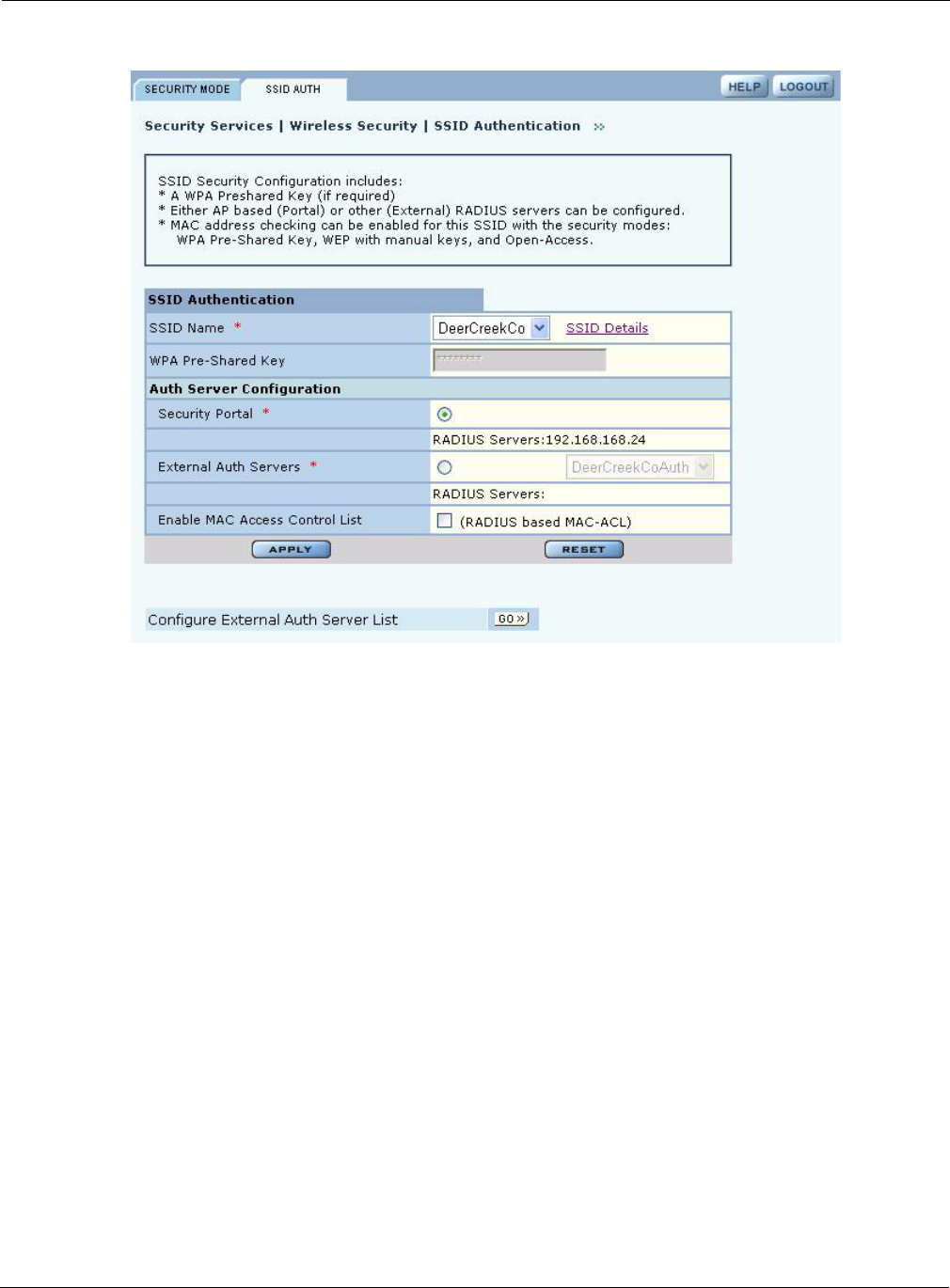
Configuring Wireless Security
Installation and User Guide: Airgo Access Point 153
Figure 108: Security Services - SSID Auth
Assign the following values to configure SSID authentication:
Click Apply to save changes or Reset to return to previously saved values. It may be necessary to
click Back on your browser to return to the Security Configuration panel. Make sure to also click
Apply on the Security Configuration panel.
An external RADIUS server can also be added from this tab. Click Go at the bottom of the tab to
open the Authentication Zone tab of the Authentication Zones panel. For instructions on adding a
server, refer to “Configuring Authentication Zones” on page 155.
Feature Description
SSID Name Select from the SSID pull-down list. Click SSID Details to view more SSID-
related information, enable multiple SSIDs, or change other SSID attributes.
WPA Pre-Shared Key Enter the pre-shared key for WPA, if appropriate. This field is grayed out if
WPA-PSK is not the selected authentication type.
Authentication Server
Configuration
Select the Security Portal or External Authentication Servers radio button. For
Security Portal, the IP addresses of all security portals are displayed below the
radio button. For External security, select from the list of RADIUS servers or
click Go at the bottom of the tab to configure the authentication server list
(see “Authentication Zones” on page 155). (required)
Enable MAC Access
Control List
Select to enable authentication using MAC addresses centrally managed in a
RADIUS server. For MAC-ACL authentication, it is necessary to use a
security portal or external RADIUS server.

7 Managing Security
154 Installation and User Guide: Airgo Access Point
If an external RADIUS server is to be used for MAC address based ACL lookups, the following
apply:
1The RADIUS server must have PAP authentication enabled for these MAC ACL users
2The RADIUS server can expect the AP to send the following standard RADIUS attributes in
the authentication request for purposes of policy configuration and interoperability. (MAC
addresses must have no colon or hyphen separators):
3The RADIUS server should enforce a policy such that MAC ACL users are only allowed to use
PAP authentication for Wireless. This is important because the username and password are not
secret.
4The RADIUS server may optionally send back the Session-Timeout attribute to override the
AP default session-timeout.
5The RADIUS server may optionally send back an attribute encoded with the user group.
If an external RADIUS server is used for EAP based authentication (with WPA or with legacy
802.1x), the following information should be used when configuring the server:
1The RADIUS server can expect the AP to send the following standard RADIUS attributes in
the authentication request for purposes of policy configuration and interoperability:
2The RADIUS server can use these attributes to enforce policies such that EAP based
authentication is mandatory for Wireless.
3The RADIUS server may optionally send back the Session-Timeout attribute to override the
AP default session-timeout.
Attribute Description
User-Name MAC address
User-Password MAC address
Message-Authenticator RADIUS extension providing enhanced authentication of message contents
(This is the same as the signature attribute in some RADIUS servers.)
NAS-IP-Address Management IP address of the AP
NAS-Port Radio interface number for the associating station
NAS-Port-Type Standard value Wireless - IEEE 802.11 (Indicates that the user has requested
access via an 802.11 port on the AP.)
Attribute Description
User-Name Contains the MAC address in the format specified above.
EAP-Message Contains the EAP messages received from the station.
Framed-MTU Contains a hint to help the RADIUS server for EAP fragmentation.
Message-Authenticator The RADIUS extension that provides enhanced authentication of the message
contents (also referred to as signature attribute in some RADIUS servers).
NAS-IP-Address Contains the management IP address of the AP.
NAS-Port Contains the radio interface number on which the station is associating.
NAS-Port-Type Contains the standard value “Wireless - IEEE 802.11” to indicate that the user
to be authenticated has requested access via an 802.11 port on the AP.
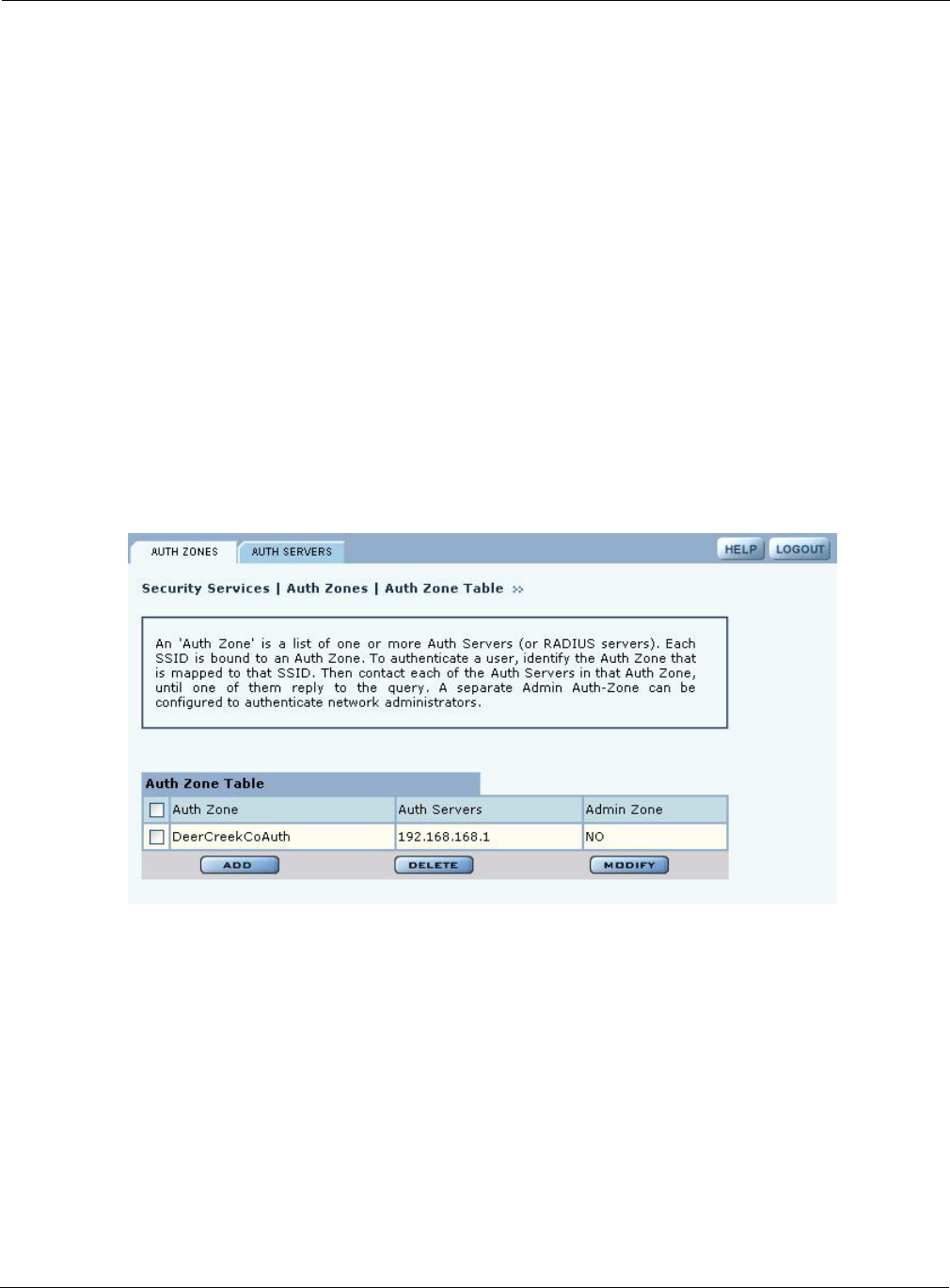
Configuring Authentication Zones
Installation and User Guide: Airgo Access Point 155
4The RADIUS server may optionally send back an attribute encoded with the user group.
Configuring Authentication Zones
RADIUS servers may be used to authenticate wireless users and administrative users, and to check
MAC Access Control Lists for the SSID.
Select Authentication Zones from the Security Services menu to define zones for RADIUS
authentication and to add external RADIUS servers to the list of available authentication servers.
Configure the servers first, and then include them in zones.
The Authentication Zone panel contains two tabs:
•Auth Zones — Define zones for RADIUS authentication.
•Auth Servers — Add RADIUS servers.
Authentication Zones
On the Auth Zones tab (Figure 109), you can create new authentication zones or modify existing
ones. Select check boxes for authentication zones you want to modify or delete, or click Add to add
a new zone.
Figure 109: Authentication Zones - Auth Zones
Set the following values on the Add Auth Zone entry panel (Figure 110):
Click Add after making selections.
Field Description
Auth Zone Name of the authentication zone
Auth Server list List of possible servers to add to the zone (Select desired servers.)
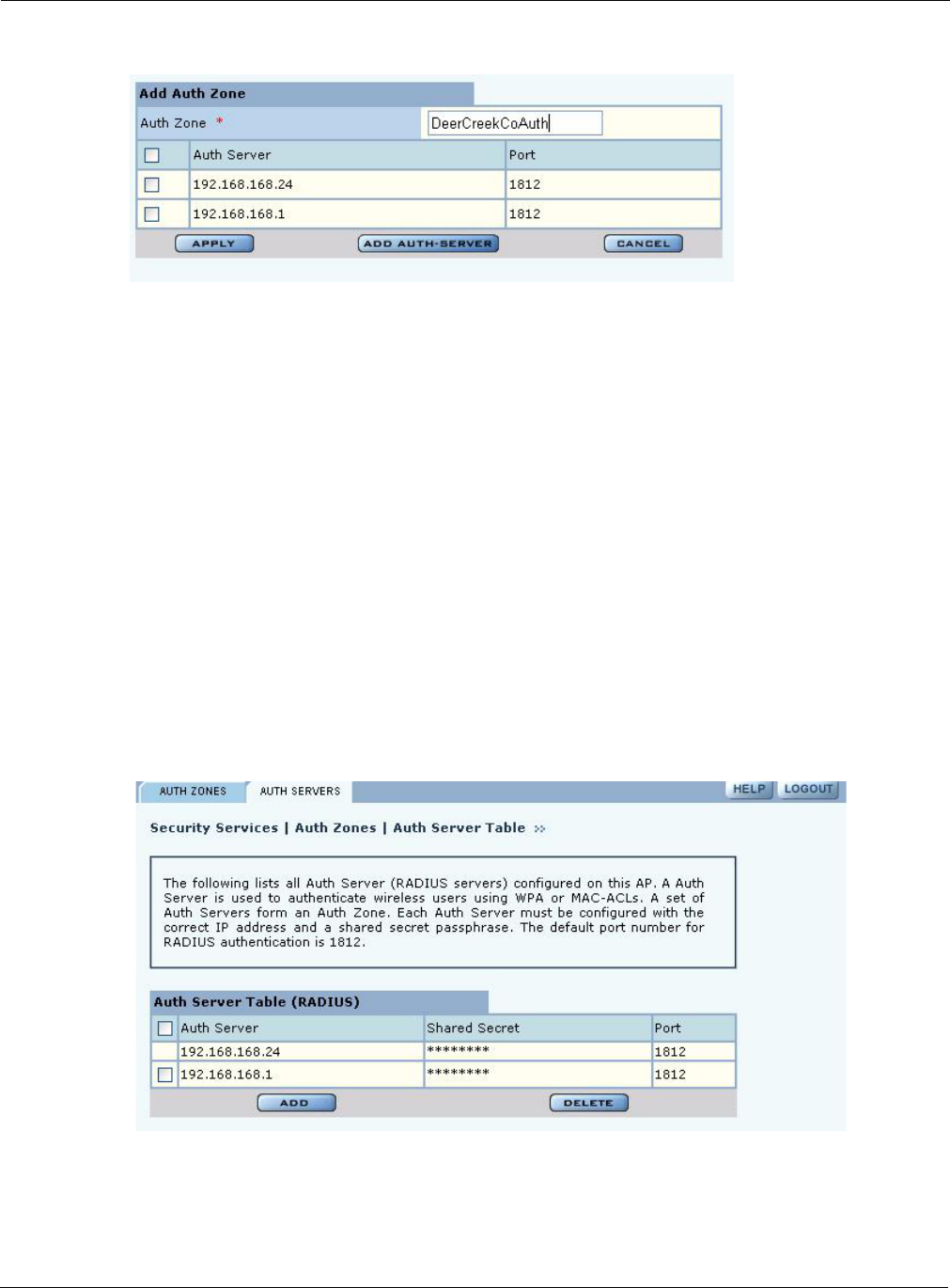
7 Managing Security
156 Installation and User Guide: Airgo Access Point
Figure 110: Authentication Zones - Add Auth Zones
To add a new authentication server, click Add Auth-Server, and enter the following values for
each new RADIUS server:
Click Add to save the values, or click Reset to clear the fields on the panel.
Click Back on your browser to return to the Auth Zone panel. Set an authentication zone for
administrative users by selecting from the pull-down list.
Authentication Servers
Open the Authentication Servers tab (Figure 111) to view the current authentication servers and
add or delete servers. This table shows the list of internal authentication servers (security portals)
and external authentication servers. The servers that do not have an associated check box are
security portals.
Figure 111: Authentication Zones - Auth Servers
Field Description
Auth Server IP address of the RADIUS authentication server
Shared Secret Secret key to be entered and confirmed
Port Number Port number for the server (default is 1812)
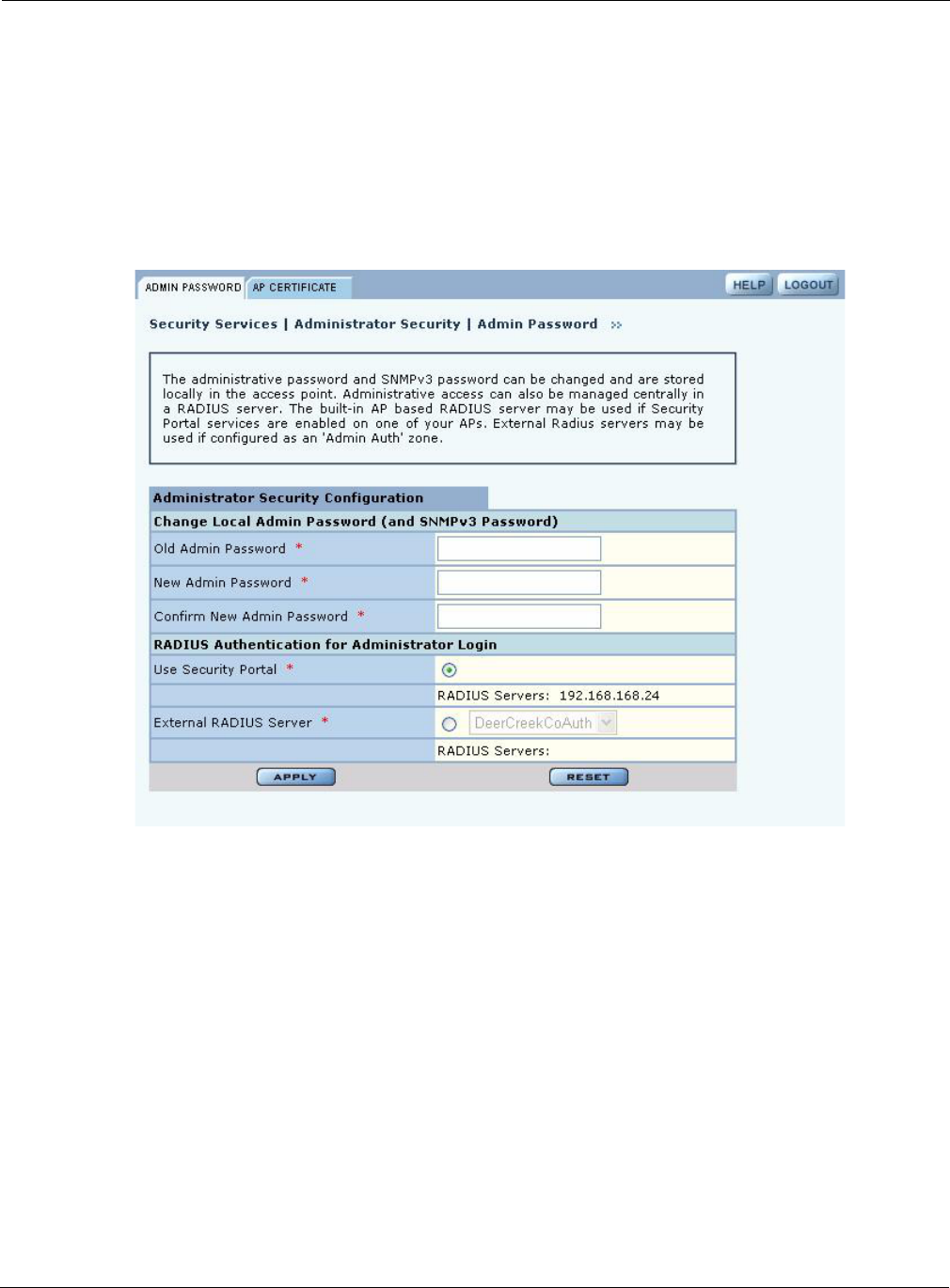
Configuring Administrator Security
Installation and User Guide: Airgo Access Point 157
Configuring Administrator Security
Use the Administrator Security menu item to administer the administrator password and view AP
certification information.
Administrator Password
Choose Administrator Security from the Security Services menu to open the Administrator
Security panel, Admin Password tab (Figure 112).
Figure 112: Administrator Security - Admin Password
Set the following values on this panel:
Click Apply to save the settings or Reset to clear the fields on the panel.
External RADIUS Server Settings
The following rules apply for an external RADIUS server:
Field Description
Change Local Admin
Password
Enter the old password and the new password, and confirm the new password.
This password is used for the local administrative login and the SNMPv3
administrative login. (required)
RADIUS Authentication
for Network
Administrator Login
Select whether to use the Portal AP security feature for network administrator
authentication or to use an external RADIUS server. With the external
RADIUS server option, links are available to add, delete, or edit the list of
servers. (required)
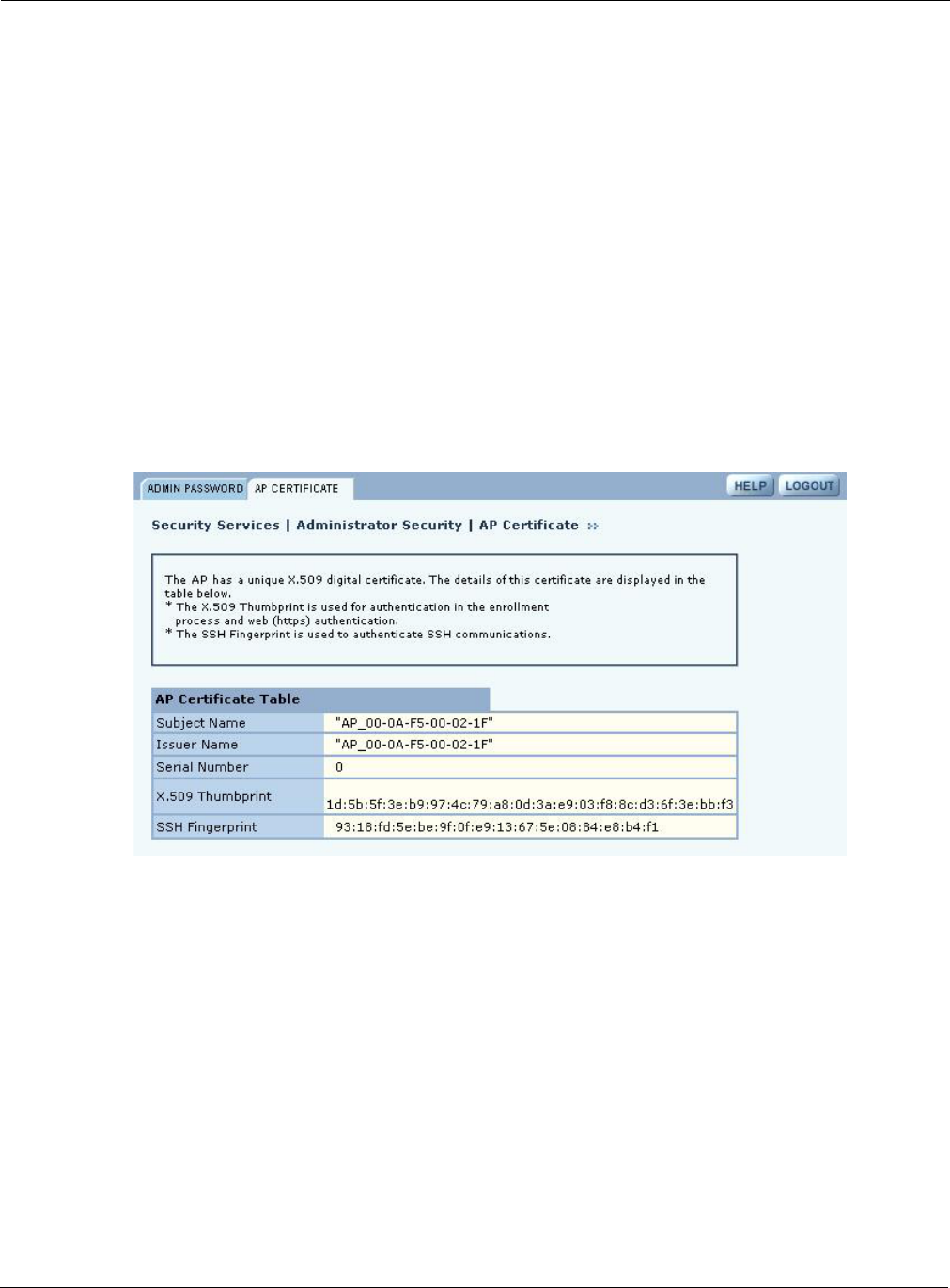
7 Managing Security
158 Installation and User Guide: Airgo Access Point
•The external RADIUS server must have Password Authentication Protocol (PAP)
authentication enabled for administrative users.
•The Airgo AP sends a standard RADIUS attribute called Service-Type in the authentication
request. The value of this attribute is set to Administrative to indicate that the user to be
authenticated has requested access to an administrative interface on the AP.
•If the user authentication is successful, the RADIUS server must send back a vendor-specific
attribute defined as follows:
vendor-id=13586, vendor sub-type=3, integer value = 1
This attribute informs the AP that the user is not a normal user, but rather an administrator who
may be granted access to the privileges of the administrative interface.
AP Certificate
To view information about the unique X.509 security certificate assigned to the AP, choose
Administrator Security from the Security Services menu to open the Administrator Security
panel, and then select AP Certification (Figure 112).
Figure 113: Administrator Security - AP Certificate
This tab contains the following information:
Item Description
Subject Name AP Device ID.
Issuer Name Device ID of the certificate issuing entity.
Serial Number Serial number of the AP.
X.509 Thumbprint SHA1 hash of the AP digital certificate. Used to authenticate the identity
of the AP device during AP enrollment and when managing the AP using
the Web browser interface.
SSH Fingerprint MD5 hash of the AP digital certificate. Used to authenticate the identity
of the AP when using SSH to remotely manage the AP.
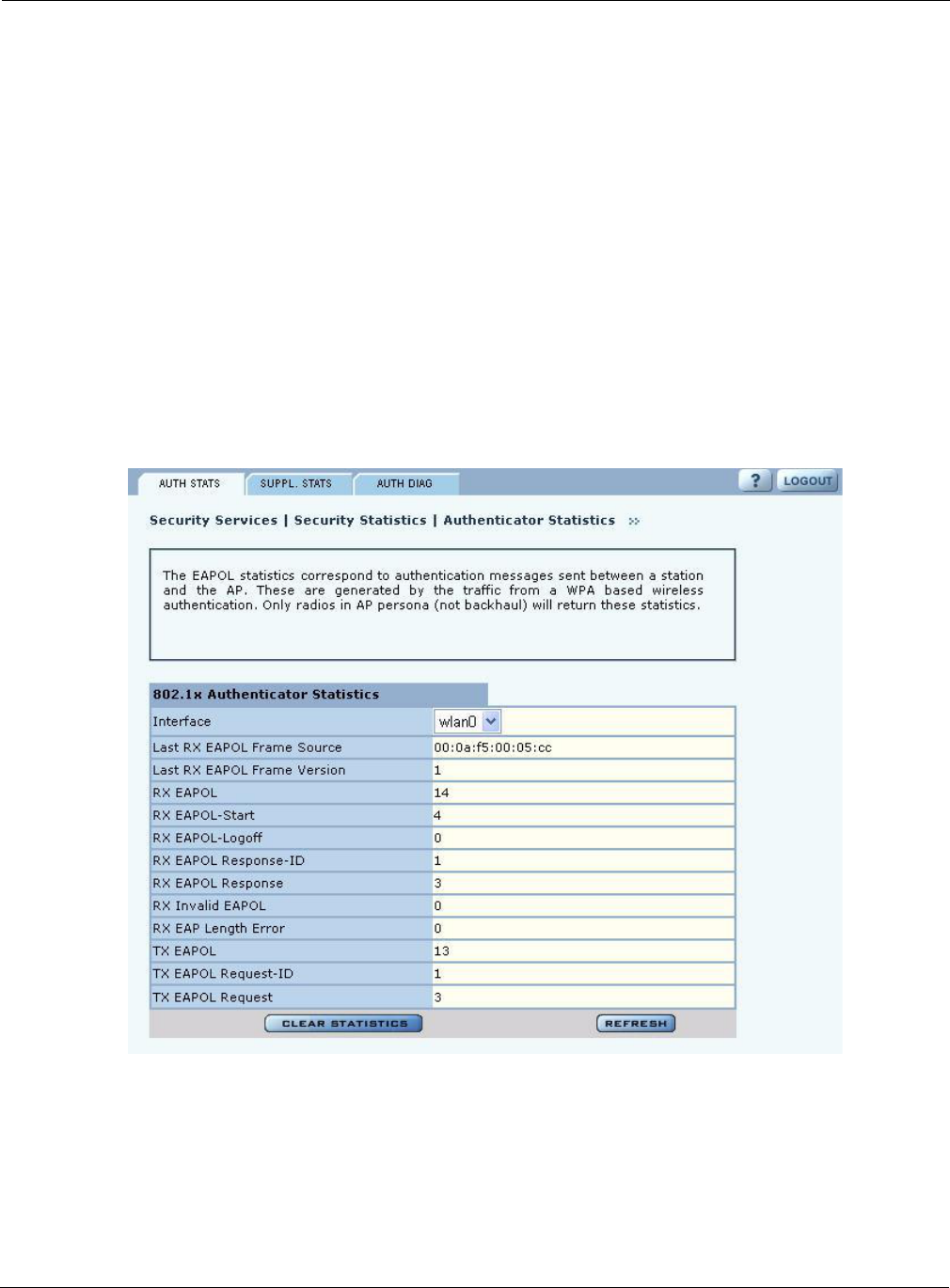
Viewing Security Statistics
Installation and User Guide: Airgo Access Point 159
Viewing Security Statistics
Choose Security Statistics from the menu tree to open the Security Statistics panels. This panel
contains the following tabs:
•Authenticator Stats — View authentication statistics for each selected AP radio.
•Supplicant Stats (Supplicant Statistics) — View statistics on 802.1x requests for each selected
BP radio.
•Auth Diag — View authentication diagnostics statistics, including backend data.
Each of the tabs includes a Reset button to return the statistics to zero and begin collecting them
again.
Authentication Statistics
The Authenticator Statistics tab (Figure 114) contains EAPOL statistics, which correspond to
authentication messages sent between a station and an AP. These are generated by the traffic from
WPA or 8021.x-based wireless authentication. Only radios in AP mode produce this data.
Figure 114: Security Statistics - Authenticator Stats
The tab contains the following information:
Field Description
Interface Select the radio interface of interest for viewing statistics.
Last RX EAPOL Frame
Source
The source MAC address from the last EAPOL frame received by the AP.
This identifies a station or BP that is currently authenticating or re-
authenticating with the AP.

7 Managing Security
160 Installation and User Guide: Airgo Access Point
Supplicant Statistics
The Supplicant Stats tab (Figure 115) reports on authentication messages sent between a local BP
radio and the upstream AP. Only radios in BP mode return these statistics. The statistics are
generated from the EAPOL protocol, which is used for 802.1x authentication.
Last RX EAPOL Frame
Version
The EAPOL version from the last EAPOL frame received by the AP.
RX EAPOL The total number of EAPOL frames received by the AP.
RX EAPOL-Start The total number of EAPOL-Start frames received by the AP. This count
increments as stations or BPs request the AP to start their authentication
sequence.
RX EAPOL-Logoff The total number of EAPOL-Logoff frames received by the AP. This count
may not increment as most 802.1x peers do not send this frame for security
reasons.
RX EAPOL Response-
ID
The total number of EAPOL-based EAP Response-ID frames received by the
AP. This count increments as stations or BPs present their user-ID or device-
ID information to the AP at the start of the authentication sequence.
RX EAPOL Response The total number of EAPOL-based EAP Response frames received by the AP
that do not contain an EAP Response-ID. This count increments as the AP
receives authentication credentials derived from passwords or certificates
from stations or BPs authenticating with it.
RX Invalid EAPOL The total number of EAPOL frames received by the AP that have invalid
packet type fields. These frames are discarded by the AP.
RX EAP Length Error The total number of EAPOL frames received by the AP that have invalid
packet body length fields. These frames are discarded by the AP.
TX EAPOL The total number of EAPOL frames transmitted by this AP.
TX EAPOL Request-ID The total number of EAPOL-based EAP Request-ID frames transmitted by
this AP. This count increments as the AP sends authentication frames to
stations or BPs requesting them to return their user-ID or device-ID
information at the very start of the authentication sequence.
TX EAPOL Request The total number of EAPOL-based EAP Request frames transmitted by the
AP that do not contain an EAP Request-ID. This count increments as the AP
transmits authentication credentials derived from passwords or certificates to
the stations or BPs authenticating with it.
Field Description
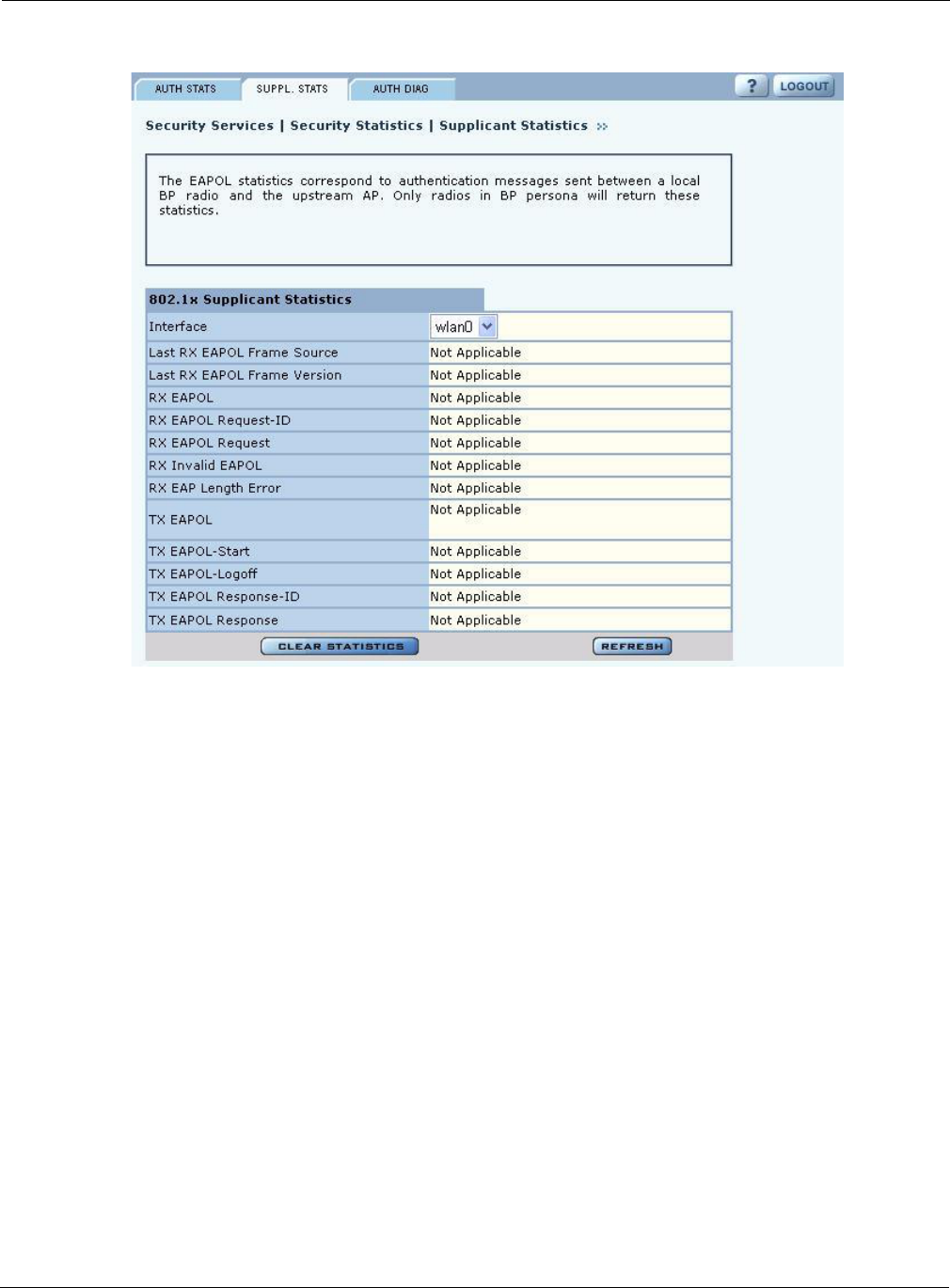
Viewing Security Statistics
Installation and User Guide: Airgo Access Point 161
Figure 115: Security Statistics - Supplicant Stats
The tab contains the following information:
Field Description
Interface Select the radio interface of interest for viewing statistics.
Last RX EAPOL Frame
Source
The source MAC address from the last EAPOL frame received by the BP.
This identifies the upstream AP that is currently authenticating or re-
authenticating with the BP.
Last RX EAPOL Frame
Version
The EAPOL version from the last EAPOL frame received by the BP.
RX EAPOL The total number of EAPOL frames received by the BP.
RX EAPOL Request-ID The total number of EAPOL-based EAP Request-ID frames received by this
BP. This count increments as the AP sends authentication frames to the BP
requesting it to send its device ID information at the very start of the
authentication sequence.
RX EAPOL Request The total number of EAPOL-based EAP Request frames received by the BP
that do not contain an EAP Request-ID. This count increments as the AP
transmits authentication credentials derived from certificates to the BP.
RX Invalid EAPOL The total number of EAPOL frames received by the BP that have invalid
packet type fields. These frames are discarded by the BP.
RX EAP Length Error The total number of EAPOL frames received by the BP that have invalid
packet body length fields. These frames are discarded by the BP.
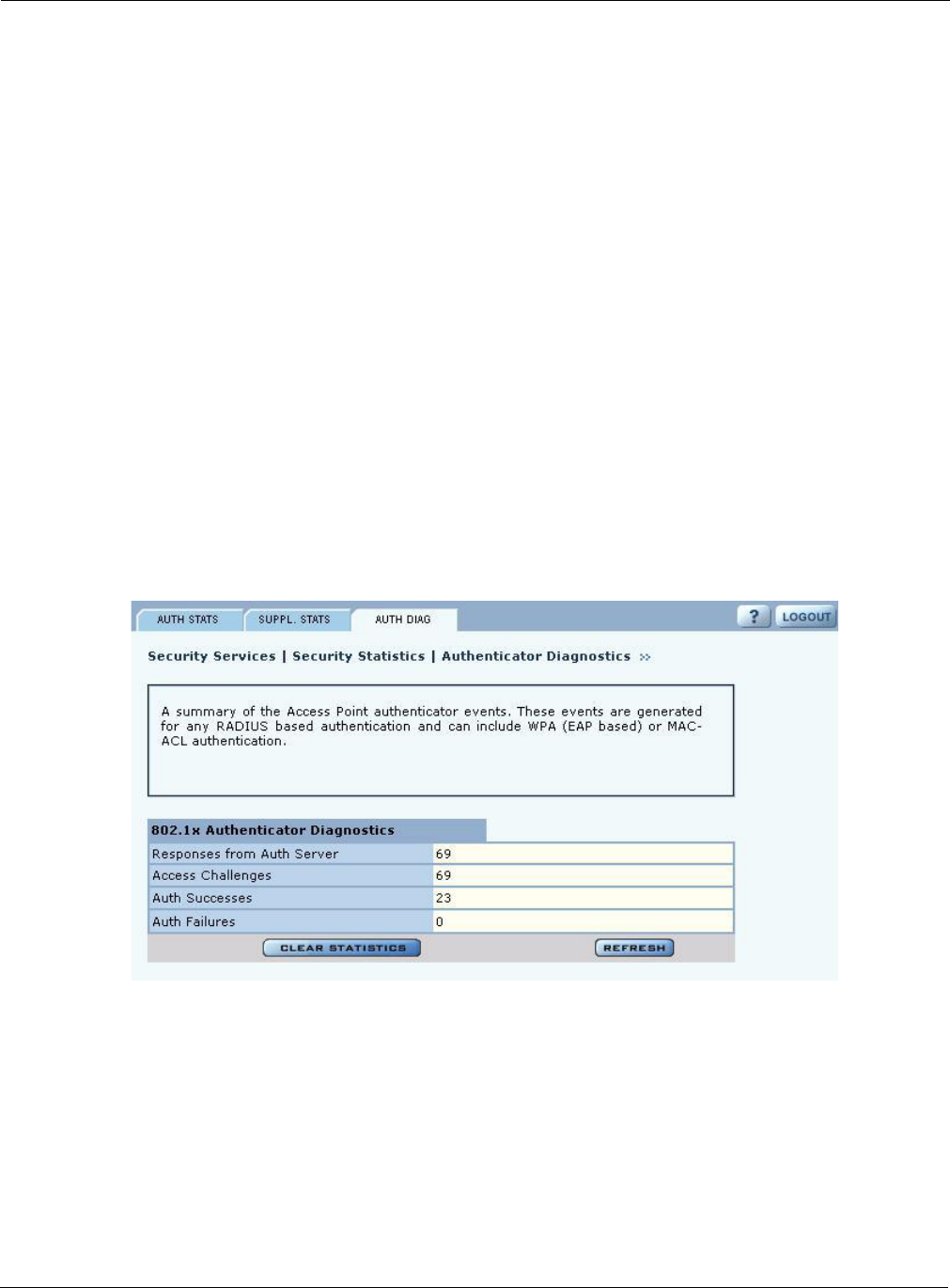
7 Managing Security
162 Installation and User Guide: Airgo Access Point
Authenticator Diagnostics
The Authenticator Diagnostics tab (Figure 116) contains a summary of the AP authenticator events
received from a backend authentication server. These events are generated for any RADIUS based
authentication and can include WPA (EAP-based), MAC-ACL, or dynamic WEP authentication.
Figure 116: Security Statistics - Authenticator Diagnostics
The tab contains the following information:
TX EAPOL The total number of EAPOL frames transmitted by this BP.
TX EAPOL-Start The total number of EAPOL-Start frames transmitted by the BP. This count
goes up as the BP requests the AP to start its authentication sequence.
TX EAPOL-Logoff The total number of EAPOL-Logoff frames transmitted by the BP. This count
will not increment as the BP does not send this 8021.x frame for security
reasons.
TX EAPOL Response-
ID
The total number of EAPOL-based EAP Response-ID frames transmitted by
this BP. This count increments as the BP sends authentication frames to the
AP with its device-ID information at the very start of the authentication
sequence.
TX EAPOL Response The total number of EAPOL-based EAP Response frames transmitted by the
BP that do not contain an EAP Response-ID. This count increments as the BP
transmits authentication credentials derived from certificates to the AP that is
authenticating with it.
Field Description
Responses from Auth
Server
The total number of RADIUS authentication-related packets received from
the backend authentication server.
Access Challenges The total number of RADIUS authentication packets that contained an
ACCESS-CHALLENGE. These are sent by the RADIUS server when it is
engaged in a multi-step authentication sequence.
Field Description
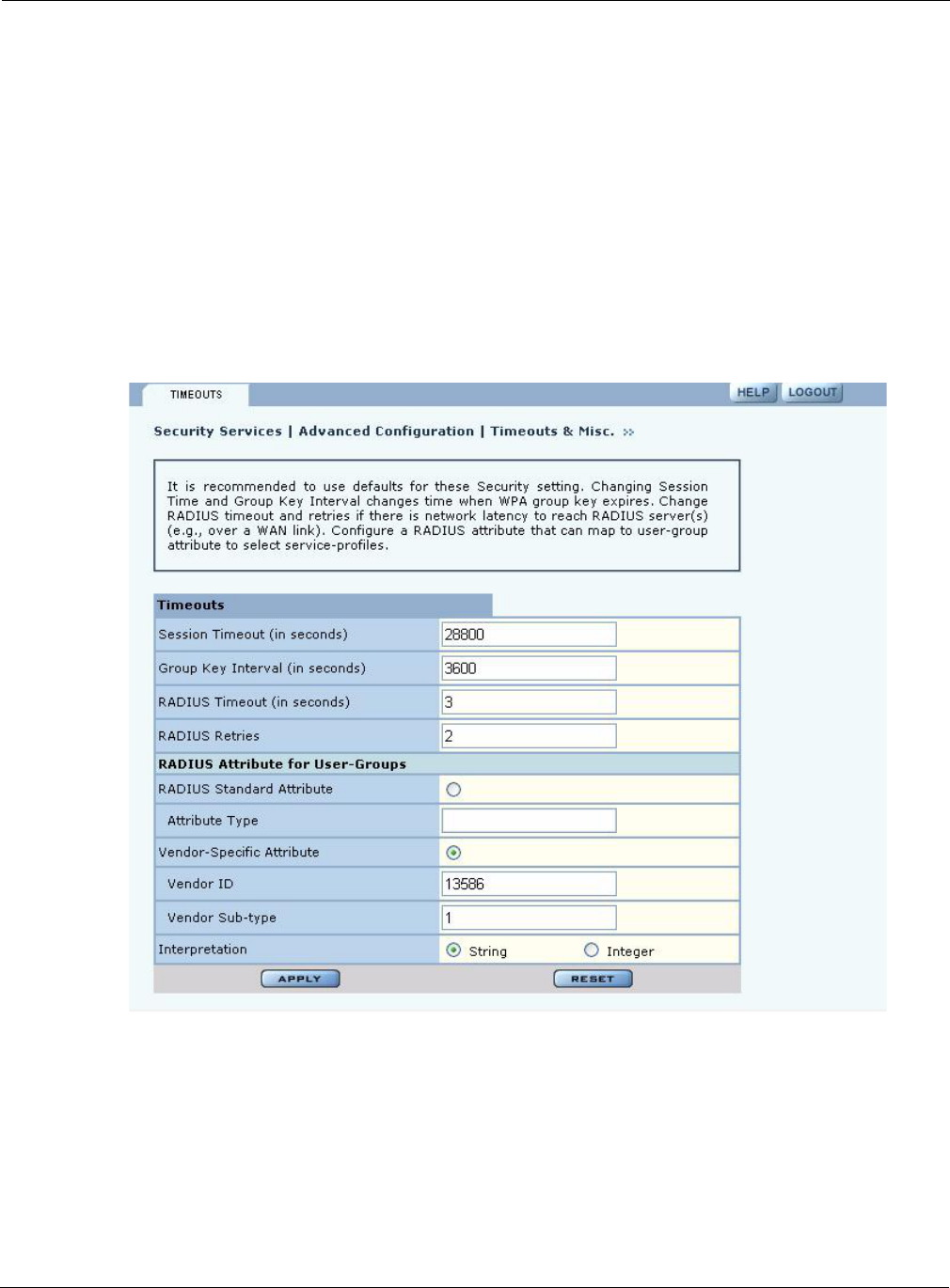
Configuring Advanced Parameters
Installation and User Guide: Airgo Access Point 163
Configuring Advanced Parameters
Choose Advanced Configuration from the menu tree to open the Advanced RADIUS
configuration panel (Figure 117). It is not necessary to modify any settings on this panel.
Figure 117: Advanced Configuration - Timeouts
The panel contains the following fields:
Auth Successes The total number of RADIUS authentication packets that contained an
ACCESS-ACCEPT. These are sent by the RADIUS server when the
authentication sequence succeeds.
Auth Failures The total number of RADIUS authentication packets that contained an
ACCESS-REJECT. These are sent by the RADIUS server when the
authentication sequence fails.
Field Description
Field Description
Session Timeout Time in seconds after which a station is re-authenticated.
Group Key Interval Time in seconds after which the group key is changed (this is not used if static
WEP keys are enforced).
RADIUS Timeout Time in seconds after which the request is retransmitted.
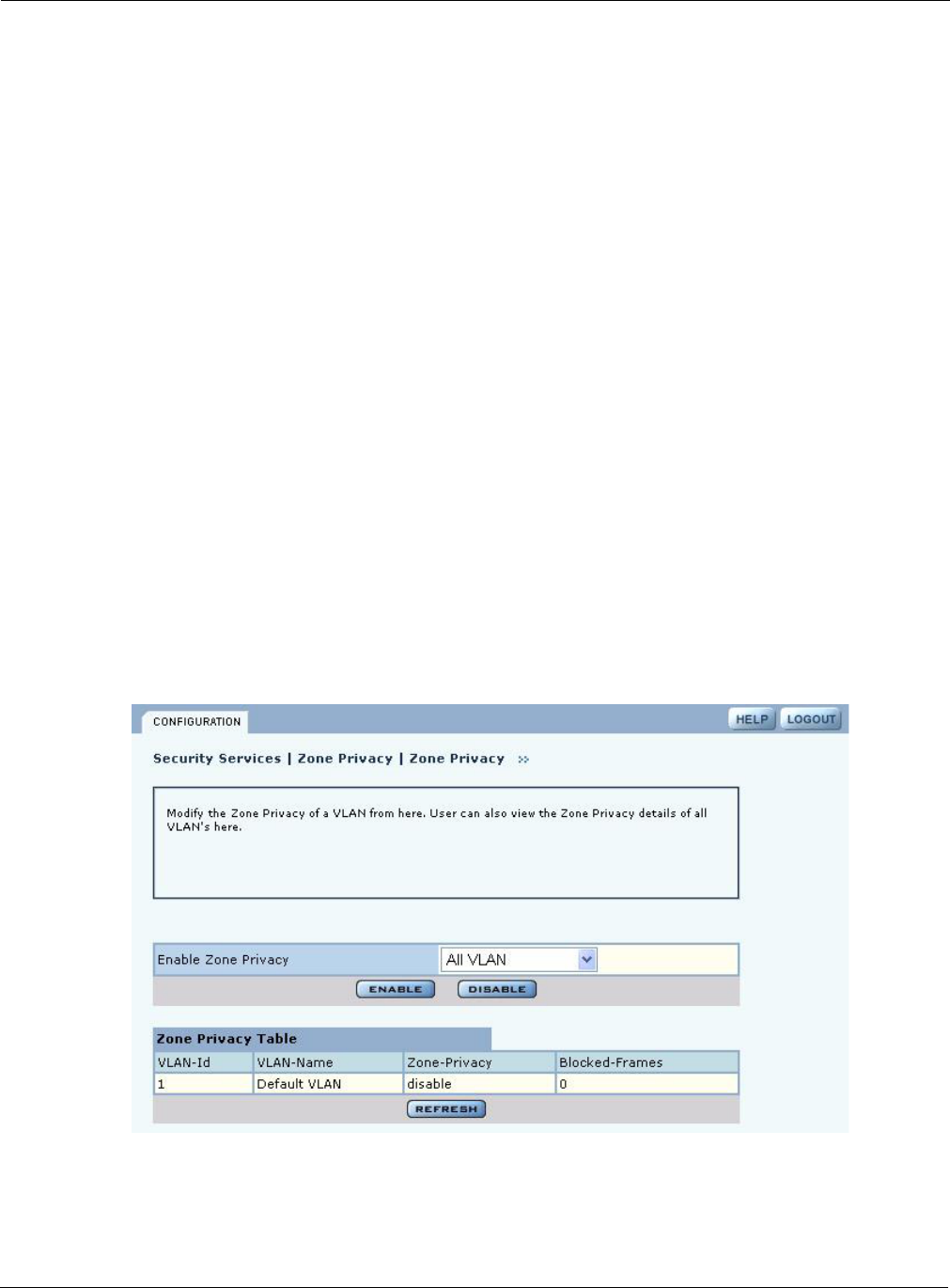
7 Managing Security
164 Installation and User Guide: Airgo Access Point
Other standard or vendor-specific attributes can be used to determine service policies. For example,
an enterprise having an existing RADIUS attribute for VLANs (Tunnel-Private-Group-ID) can
reuse the attribute for service profile assignment by configuring it as the RADIUS attribute for user
groups. This can be accomplished by selecting RADIUS Standard Attribute Type 81, with a string
interpretation. The VLAN string that is returned by the RADIUS server will then be used as the
name of the user-group.
For attributes that return integer values, the group name will be the string representation of the
same integer. For example, the integer 1 will be treated as the group name “1.”
Click Apply to implement changes, or click Reset to return the entries on the panel to their
previous values.
Configuring Zone Privacy
Choose Zone Privacy from the menu tree to open the configuration panel for zone privacy
(Figure 118).
Figure 118: Zone Privacy
RADIUS Retries Number of retransmit attempts after which the RADIUS request is marked a
failure.
External RADIUS
Group-Key Attribute
(for User Group ID)
RADIUS attribute used by the AP to determine the user group (see “SSID
Details” on page 87). When a wireless user is authenticated by a RADIUS
server, the server can optionally send the AP the user group for the
association. If a user group is not returned, the user is not assigned a group
and gets the default service profile for the SSID. By default, a Vendor Specific
Attribute is used (13586, 1, String).
Field Description

Configuring Zone Privacy
Installation and User Guide: Airgo Access Point 165
The panel contains the following settings:
Item Description
Enable Zone Privacy Allows you to enable zone privacy on one or more VLANs.
1Select a VLAN to which zone privacy will apply or select All VLANs
to apply the feature across all defined VLANS.
2Click Enable.
3Repeat if desired to enable zone privacy on additional VLANs.
Zone Privacy Table Displays a list of VLANs and their current zone privacy status. Each row
contains the following information:
•VLAN ID
•VLAN Name
•Zone privacy status: Enabled or Disabled
•Blocked frames: number of frames blocked due to enforcement of
zone privacy rules

7 Managing Security
166 Installation and User Guide: Airgo Access Point

Installation and User Guide: Airgo Access Point 167
8Configuring Guest Access
This chapter describes how to enable guest user access to the wireless network while protecting the
network from unauthorized use. It contains the following sections:
•Overview
•Internal Landing Page
•External Landing Page
•Configuring Guest Access with VLANs
•Guest Access Services Panel
Overview
Guest access allows visitors to a facility to access the Internet through the wireless network without
gaining access to the corporate network. Unauthenticated users are permitted to associate to an AP,
but any web communications are captured and directed to a controlled landing page or captive
portal. The landing page allows the guest user to log in using web-based authentication, and can be
implemented by way of an internal or external URL. The page can inform unauthenticated users of
the network access policies and provide instructions on obtaining the guest password. Following
successful authentication, the guest user is released from the captive pages and allowed to access
resources permitted to guest users.
The Airgo AP supports guest access administration with or without the use of VLANs to segregate
guest traffic from other network traffic. Both approaches are compatible with the use of external
and internal landing pages.
Guest Access without VLANs
This option is ideal for hot spot deployments in which guest authentication is required, but it is not
necessary to segregate guest traffic from other network traffic. Once guests are authenticated, they
are automatically assigned a default guest service profile, which includes the default security mode
for the AP, and provided with full network access.
Guest access without VLANs is compatible with open or mixed security modes. Mixed security
modes are desirable if some users have need for ongoing network access, while others will only
access the network periodically as guests. Open access only is desirable for hot spot settings that
caterer almost exclusively to guests.
If the security mode is Open access only, then all users connecting to the configured SSID are
treated as guest users and are directed to the guest login page. Once they successfully log in to the
network, they are connected to the network, but their data traffic is not encrypted.
If the security mode is mixed (with WPA-PSK configured), then users who know the WPA-PSK
password can connect to the network using that password. Their data traffic will be encrypted over
the air. Users who try to connect to the network using open authentication will automatically be
presented the guest login page. Once authenticated, they will be provided network access, but their
traffic will not be encrypted.